inbox and environment news: Issue 617
March 10-16, 2024: Issue 617
Newport's Saved Littoral Rainforest At Hillside Road: New Bushcare Group Begins
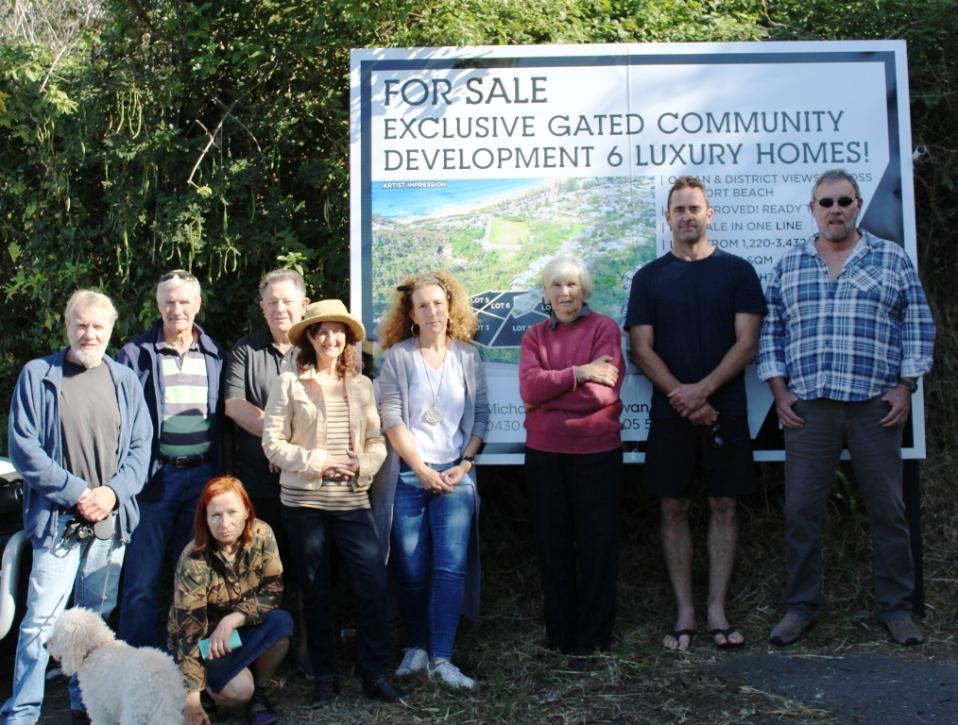
Pittwater Online spoke to Artist Mick Glasheen, who had also been speaking about the same matter in 2017, and was renting a premises on the property at that time.
Having spent time exploring Newport's 'Crown to the Sea' paths, which wend from one side of Bilgola to Newport through the green pockets of Newport and Bilgola reserves, the potential to realise a 'connecting completion of this loop' was envisioned by the residents and Mick.
The land includes significant Littoral Rainforest which is listed as an Endangered Ecologically Community (EEC) under NSW Legislation and Critically Endangered under Commonwealth Legislation. It is adjacent to the public bushland areas called the 'Crown to the Sea', making it a corridor extension to other important habitat and biodiversity rich areas.
Pittwater Online subsequently contacted Newport Residents Association President Gavin Butler, Marita Macrae, President of the Pittwater Natural Heritage Association (PNHA), Neil Evers of the Aboriginal support Group, Manly, Warringah, Pittwater and arranged, with Mick as host, an informal morning tea on site so all the people who had spoken about the same thing separately together so they could speak about it as one. The news service also informed MP for Pittwater Rob Stokes about the community's aspiration to secure this land.
These individuals and groups, took it from there - arranging to make a great video (by Bruce Walters with Danielle Bressington), launched an online petition (via PNHA) and liaised with their members (Gavin of Newport Residents and Neil Evers of ASPMWP, PNHA members) Councillors and Council as well as former Pittwater MP Rob Stokes to get this one over the line.
Former Councillors Alex McTaggart and now new Pittwater MP Rory Amon 'stepped up' in particular, speaking out at council meetings for the acquisition of this 2.56 acres of land.
There was lantana and other weeds on this land, which may need extra bushcare volunteer hands to help clear it, now that Council's contractors have completed the initial works.
Confirmation the land had been secured was announced by former Pittwater's MP, The Hon Rob Stokes, then NSW Minister for Planning and Public Spaces was released on Monday, March 11th, 2019, stating that more than 10,000 square metres of Littoral rainforest near Newport will be preserved as public open space thanks to a $4.6 million joint investment by the NSW Government and Northern Beaches Council.
Member for Pittwater and Planning and Public Spaces Minister Rob Stokes said the acquisition will ensure the pristine ecological area is preserved for the next generation.
“Our government is committed to ensuring the people of NSW have access to great public open space,” Mr Stokes said.
“Protecting the environment is a huge priority for the Northern Beaches community, so I am delighted we have been able to preserve endangered rainforest, while protecting an important wildlife corridor and increasing green space in the Sydney basin.”
Then Mayor Michael Regan said the purchase was a huge win for the local community.
“Despite its high environmental value, this land on Hillside Road had been slated for sub-division and significant development, so it’s great we’ve been able to partner with the State government to save it and bring it into public hands,” Mayor Regan said.
“I’d like to thank the many community groups and individuals who fought to have this critical land saved and ensure this incredible outcome became a reality.”
The purchase, co-funded with Northern Beaches Council through the Greater Sydney Open Space Program, demonstrated the NSW Government’s priority to secure and improve green space across the State.
The site was transferred to the Northern Beaches Council for ongoing care and management.
The Council then ran a 'Have Your Say' consultation about the classification for the land; to classify the land as either 'operational' or 'community' land and give public notice of this proposed resolution.
As 'Community Land - for all, and for all time' had been the object of the community's campaign, even for years under Pittwater Council, the feedback and wondering why the council had broached a possibility of making the land 'operational' was responded to in no uncertain terms.
However, as Mick was tenant of 85 Hillcrest at the time, the council was required to undertake this process. For a variety of reasons, including site security, the council wanted to keep this tenancy in place. In order to maintain the tenancy, 85 Hillside Road would be classified 'Operational'.
Under the Local Government Act 1993, all land in Council’s ownership must be classified as either operational or community. Land, such as parks, reserves and other open space is classified as 'community', which means that it is set aside for community uses for the public.
Some land, such as Council depots and land that is being used as an investment, is classified as 'operational' which means it can be used for a broader number of purposes.
The land was formally acquired on 24 June 2021. As three months had passed since acquisition, the classification of the land at 85 Hillside Road (Lot 2 DP 1036400) and 62 Hillside Road, Newport (Lot 1 DP 408800) defaulted to a community classification in accordance with S31(2A) of the Local Government Act.
The land was to be rezoned to a zoning that respects the bushland conservation and public ownership of the land.
A Plan of Management (PoM) was due to be prepared for the site following the transfer of the land from the State Government to Council.
This PoM will include the Land Transfer Agreement signed by the State Government and Northern Beaches Council, which mandates that the majority of the land will be used for public recreation and cannot be sold to a third party. Under the Land Transfer Agreement, which had to be signed by Council before DPIE transferred the land, the land cannot be sold or subdivided and at least 80% of the land must be retained as open space.
The PON's first report (May 2018) shared:
The Newport Bushlink, 'From the Crown to the Sea' comprises the Attunga Reserve, Kanimbla Reserve, the Porters Reserve and the Crown of Newport (McMahon's Creek) Reserve at the end of Hillside road. The work to restore these and create an interlinked walkable route was commenced in 1994 by just four Newport Residents.
The reserves allow walkers to revel in glorious Newport vistas, be among Coastal Heathland landscapes as well as Littoral Rainforest and green lit creeklines. They also provide vital fauna habitat and connection pathways.
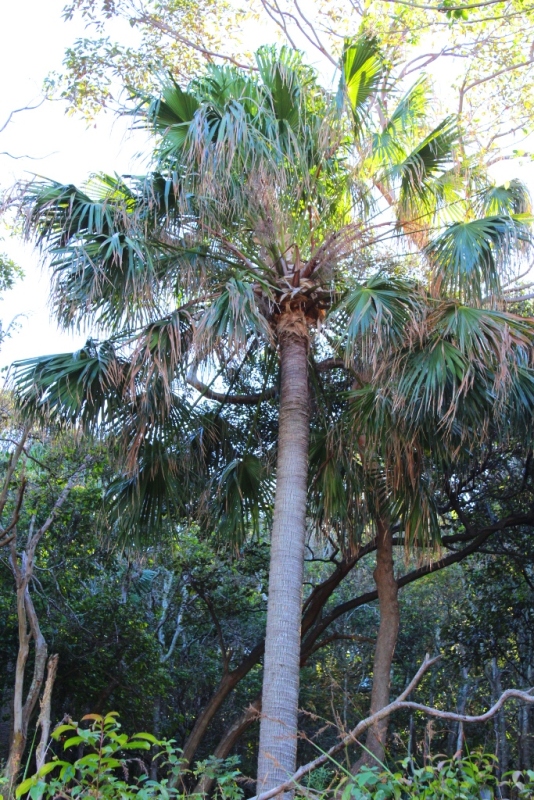 The site now on the market is approximately 1.06 ha in size, and includes 0.84 ha of native vegetation (Littoral Rainforest) and 0.22 ha of Urban Native/Exotic Vegetation. The majority of the land consists of rainforest associated species, including Cabbage Tree Palms (Livistona australis), mesic tree species such as Lilly Pillys (Acmena smithii) and Pittosporum sp., ferns; such as the Rough tree fern (Cyathea australis), vines and twiners such as Cissus sp. and sparse tussock grasses such as Lomandra sp.
The site now on the market is approximately 1.06 ha in size, and includes 0.84 ha of native vegetation (Littoral Rainforest) and 0.22 ha of Urban Native/Exotic Vegetation. The majority of the land consists of rainforest associated species, including Cabbage Tree Palms (Livistona australis), mesic tree species such as Lilly Pillys (Acmena smithii) and Pittosporum sp., ferns; such as the Rough tree fern (Cyathea australis), vines and twiners such as Cissus sp. and sparse tussock grasses such as Lomandra sp.
Other species such as Banksia integrifolia (Coastal Banksia), Ficus rubiginosa (Port Jackson Fig), Eucalyptus botryoides (Bangalay), and Allocasuarina littoralis (Forest Oak) occur less frequently in the canopy but have been recorded. Underneath the canopy a small tree layer is present, comprised predominately of Eupomatia laurina (Native Guava), Synoum glandulosum (Scentless Rosewood), Acmena smithii, and Pittosporum undulatum. The exotic tree species Erythrina x sykesii is present in the canopy in the southern half of the site.
A shrub layer is present in most areas dominated by Eupomatia laurina and Synoum glandulosum and juveniles of the trees Livistona australis and Pittosporum undulatum. Other shrubs species present with patchy occurrences include Wilkiea huegeliana (Veiny Wilkiea), Notelaea longifolia, Pittosporum revolutum (Rough-fruited Pittosporum), and Elaeocarpus reticulatus (Blueberry Ash). Vines are common in the understorey and include the species Morinda jasminoides (Sweet Morinda), Smilax australis (Lawyer Vine), Geitonoplesium cymosum (Scrambling Lily).
The ground level has ferns in most areas, the dominant species on site being Doodia aspera (Rasp Fern) and Blechnum cartilagineum (Gristle Fern), and others such as Adiantum aethiopicum (Maidenhair fern), Adiantum hispidulum (Rough Maidenhair Fern), and Calochlaena dubia (False Bracken Fern) occurring less frequently. Other herbaceous species such as Pseuderanthemum variabile (Pastel Flower), Lepidosperma elatius (Tall Sword-sedge), Schelhammera undulata (Lilac Lily), and the grasses Entolasia marginata (Margined Panic) and Oplismenus imbecillis (Creeping Beard Grass) have a scattered distribution in the ground layer.
There has been, as it has been in many Reserves prior to bush regeneration, the encroachment of lantana. There are also patches of privet and other exotic weeds association with areas that have been disturbed by development or run off from adajcent sites.
A total of 73 native species and 68 exotic species were recorded on the site and its parts during previous and subsequent development applications. The overall abundance of native and exotic species varies across the land, with native species predominating.
The site slopes steeply from the north-western side to the south-eastern boundary. There is extensive sandstone outcropping and boulders on the upper slopes, wonderful outcrops through which rain would wend.
The site adjoins Attunga Reserve and an old path around its northern perimeter once led to and joined that behind Porter's. A gambol across from Attunga would allow hikers to enjoy the great views and breeze from the peak of the site before ambling along the road to the reserve through which McMahon's creek wends.
People who live adjacent to site report seeing a powerful owl nesting in a tree on the land and a chorus of birds can be heard, during the day, singing from its green understorey. No nocturnal count of animals (or fauna that moves at night) is available but that which frequents the reserves around the land range from ring-tail possums to reptiles to a wide range of resident or seasonally returning birds.
Sounds like a paradise because it is a paradise - and would certainly appeal to anyone who wants a lofty home within a quiet corner with a glorious view and pockets of cooling green flora and fauna around them.
As the land is currently on offer as a subdivision of six large blocks, the sales pitch being a potential 'gated community', and previous discussions to have this green space acquired have availed none, the April 2018 announced NSW Government’s $290 million Open Spaces and Green Sydney package, may be just one way (or potential option for some funding) to get everyone happy this time.
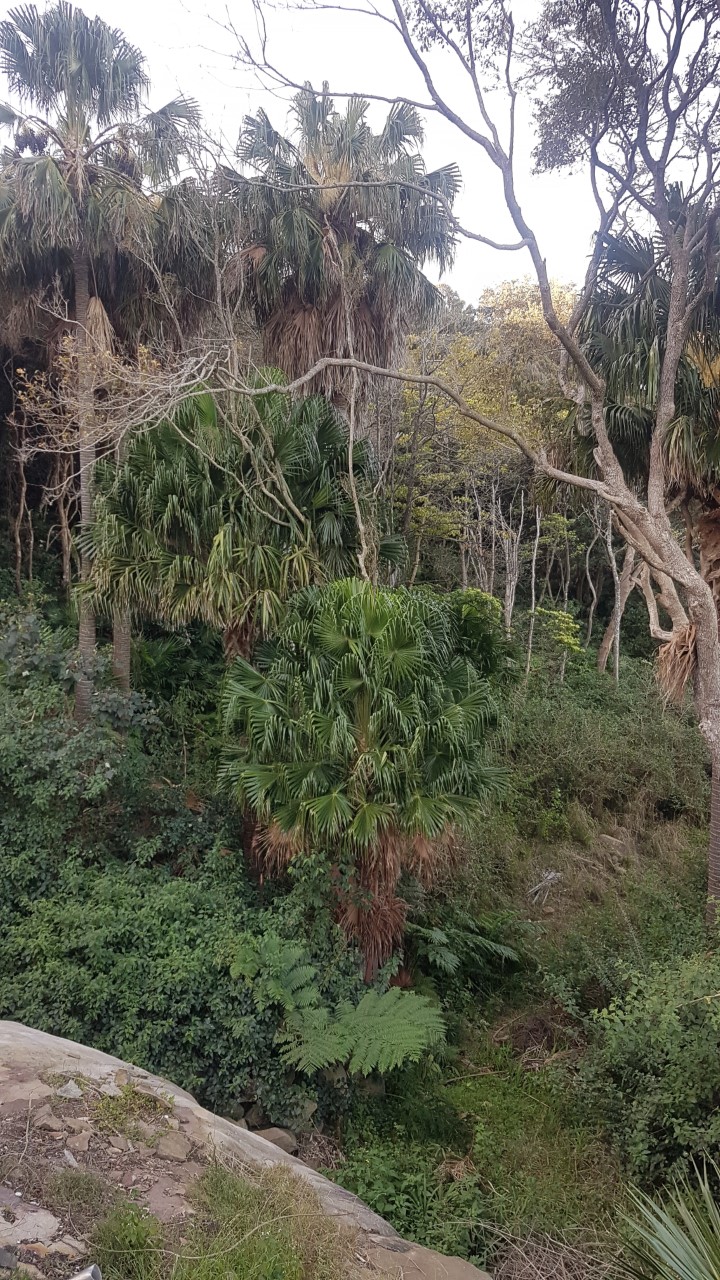
- Newport's Bushlink 'From The Crown To The Sea' Paths: Celebrating Over 20 Years Of Community Volunteer Bushcare Results - December 2017
- Potential For Newport Paradise To Be Expanded: A Greener Sydney Spark! - May 2018
- Newport's 'From The Crown To The Sea' Paths: Complete the Loop Update - July 2018
- Community Hope To Add To Newport Bushlinked Reserves Receives Council Support: Funding Will Be Sought - August 2018
- Michael Glasheen Art Exhibition To Go On The Road To Support Newport Acquisition Of Crown To The Sea Land Add-In To 'Complete The Loop' - November 2018
- From Palm Beach To Pasadena: Mick Glasheen's Drawing On The Land - GARIGAL COUNTRY Opens - December 2018
- NSW Government Working To Deliver More Green Space For Newport - March 2019
- Council Briefs - May 2019 Meeting
- Littoral Rainforest On The Newport-Bilgola Verge Secured As Public Space - September 2019

The view from the land saved for the public by former Pittwater's MP The Hon. Rob Stokes and the Northern Beaches Council.
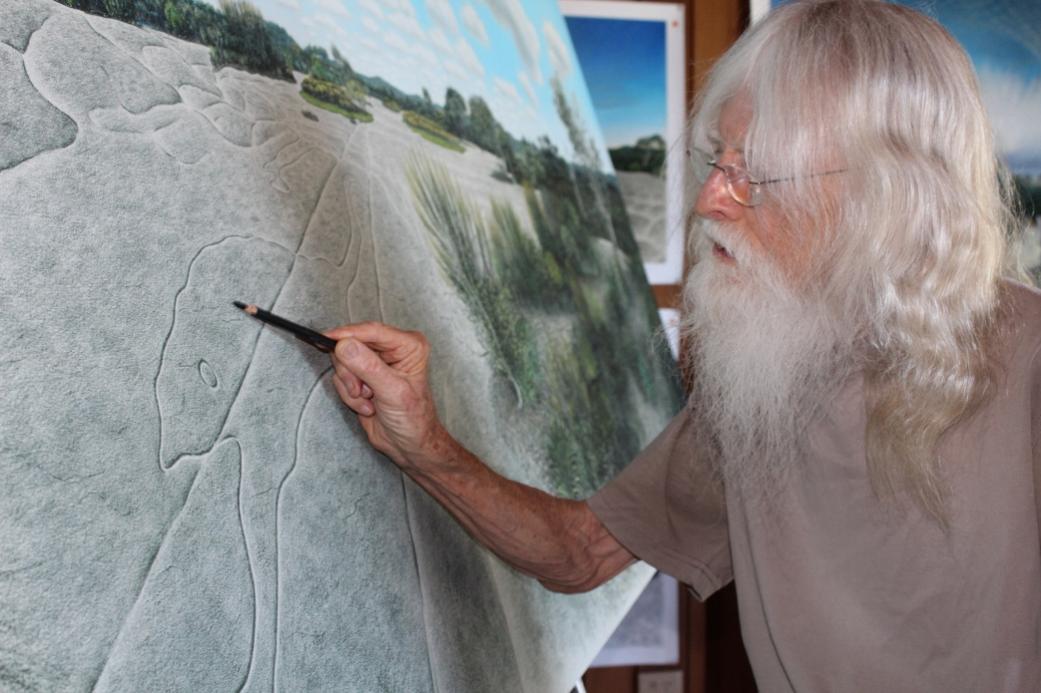
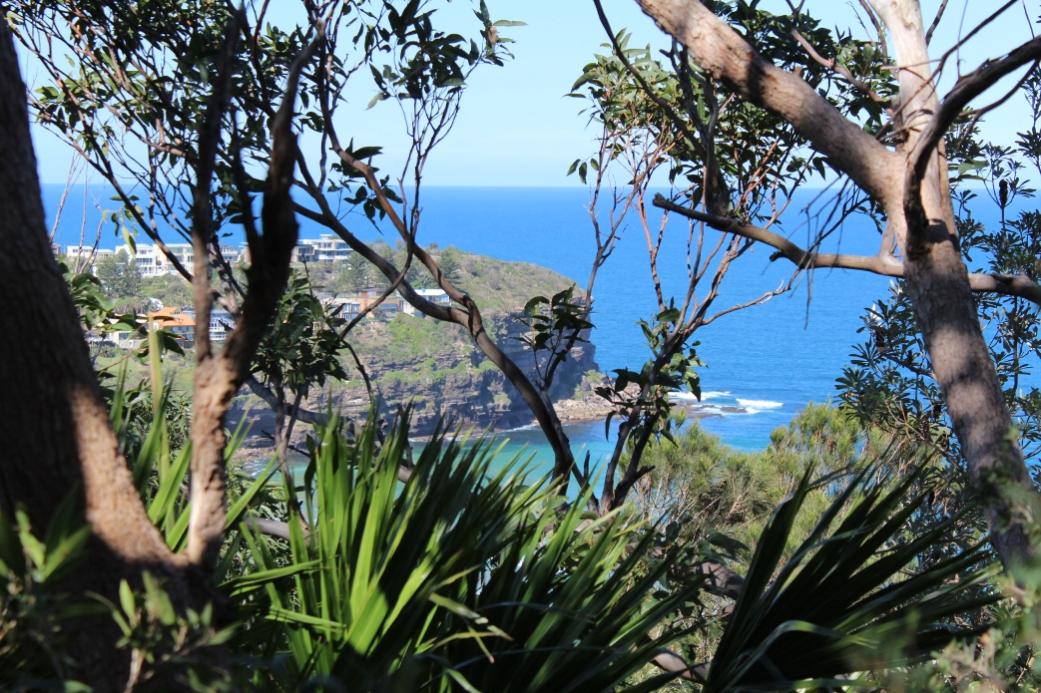
Increase Tree Vandalism Penalties: NSW Parliamentary Petition
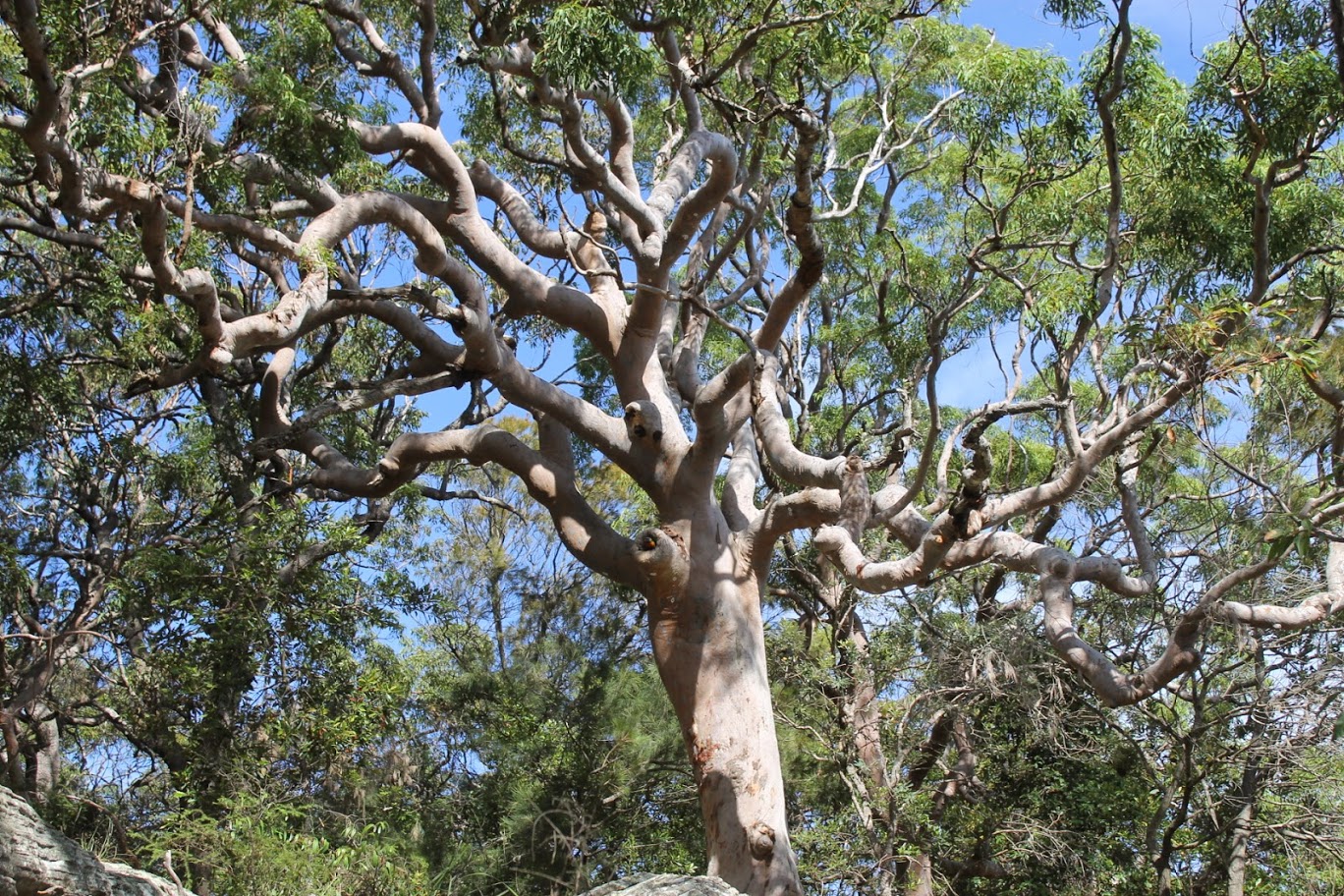
.jpg?timestamp=1708790130470)
Tree Vandalism On Harbour Trust Land At Goat Paddock, Woolwich
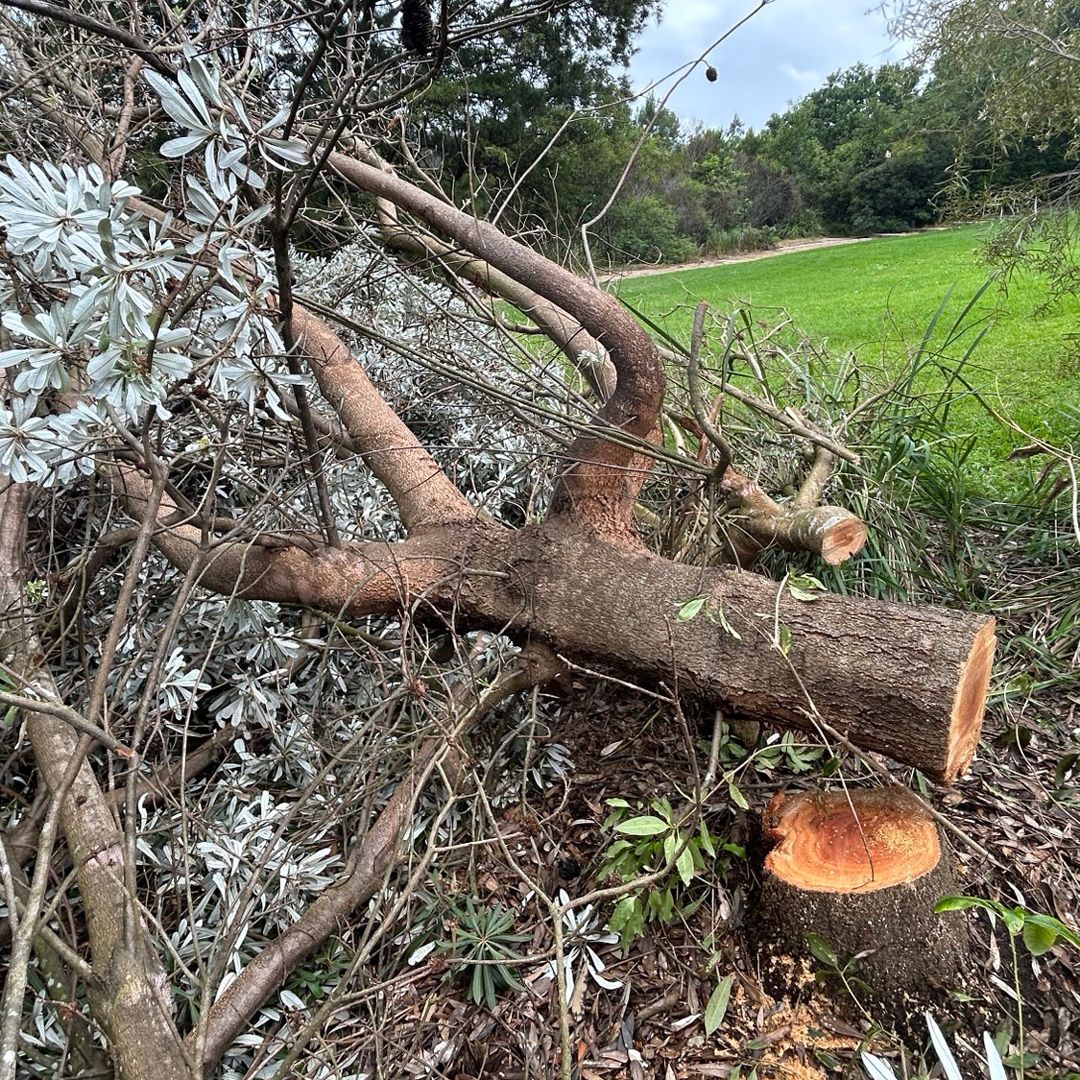
Eastern Blue Groper Changes: Have Your Say
Iconic Blue Groper Now Protected In NSW
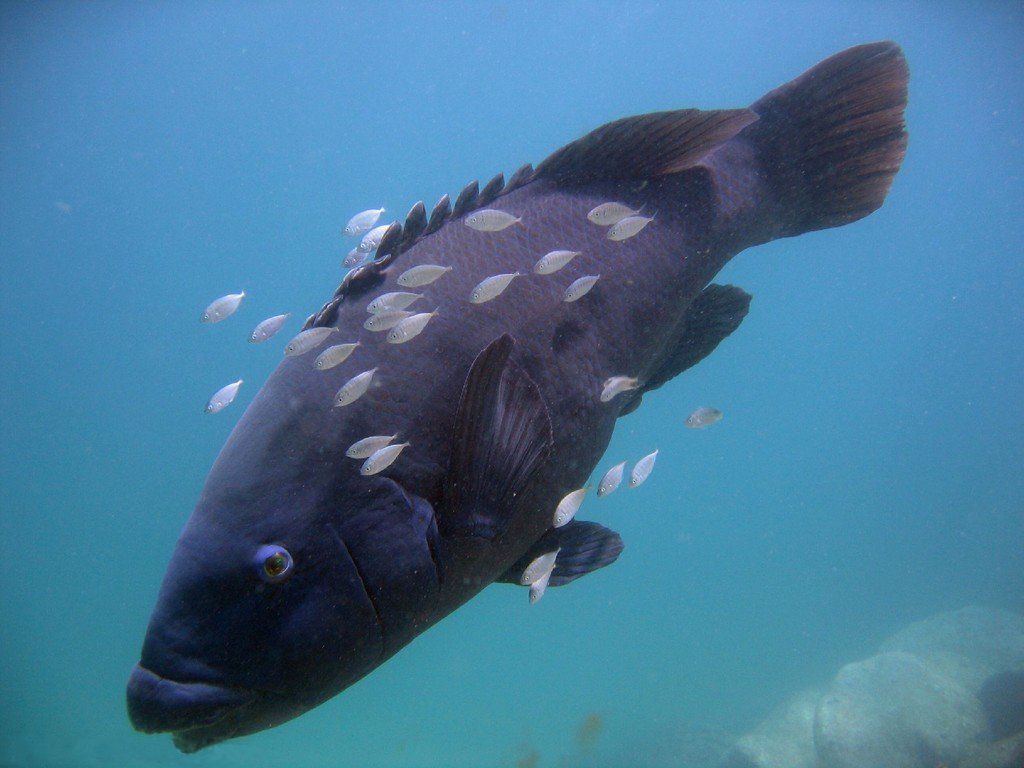
$23.8 Million To Cut Carbon Emissions: Example - The Duck Creek Blue Carbon Project
%20-%20Copy.jpg?timestamp=1710009523757)
.jpg?timestamp=1710009587225)
- Site history assessment Underway
- Hydrologic assessment and project extent mapping Underway
- Aboriginal Cultural Heritage Assessment Complete
- Mosquito Management Plan
- Project operation and maintenance plan
- deliver abatement at scale
- deliver co-benefits alongside carbon abatement
- use innovative delivery to maximise benefits to land managers.
- 24 Degree Forest
- Wilmot Cattle Company
- Regen Farmers Mutual
- Greening Australia
- World Wide Fund for Nature Australia
- NSW Department of Primary Industries.
- Reforestation by environmental or mallee plantings: A reforestation by environmental or mallee plantings project involves establishing and maintaining vegetation such as trees or shrubs on land that has been clear of forest for at least 5 years. You can plant either a mix of trees, shrubs and understory species native to the local area or species of mallee eucalypts.
- Estimation of soil organic carbon sequestration using measurement and models: To be eligible under this method, projects must introduce one or more of the following activities:
- apply nutrients to the land
- apply lime to remediate acid soils
- apply gypsum to remediate sodic or magnesic soils
- undertake new irrigation
- re-establish or rejuvenate a pasture by seeding establishing or pasture cropping
- establishing, and permanently maintaining, a pasture where there was previously no or limited pasture, such as on cropland or bare fallow
- alter the stocking rate, duration or intensity of grazing
- retain stubble after a crop is harvested
- convert from intensive tillage practices to reduced or no tillage practices
- modify landscape or landform features to remediate land
- use mechanical methods to add or redistribute soil
- use legume species in cropping or pasture system, or
- use a cover crop to promote soil vegetation cover or improve soil health or both.
- Tidal restoration of carbon blue ecosystems method (coastal wetlands): The blue carbon method enables Australian carbon credit units (ACCUs) to be earned by projects that remove or modify tidal restriction mechanisms and allow tidal flow to be introduced to an area of land. This results in the rewetting of completely or partially drained coastal wetland ecosystems and the conversion of freshwater wetlands to brackish or saline wetlands. The method enables ACCUs to be earned for the establishment of coastal wetland ecosystems that occurs as a result of project activities. There are three components within coastal wetland ecosystems that contribute to carbon abatement for a blue carbon project:
- soil carbon sequestration (through vertical accretion)
- carbon sequestered in above and below ground vegetation biomass
- emissions avoided from introducing tidal flow.
- reforestation by environmental or mallee plantings
- estimation of soil organic carbon sequestration using measurement and models
- beef cattle herd management
- tidal restoration of blue carbon ecosystems.
- High impact partnership grant guidelines (Round 1 - December 2022)
- Frequently asked questions
Wolli Creek Regional Park Officially Expanded
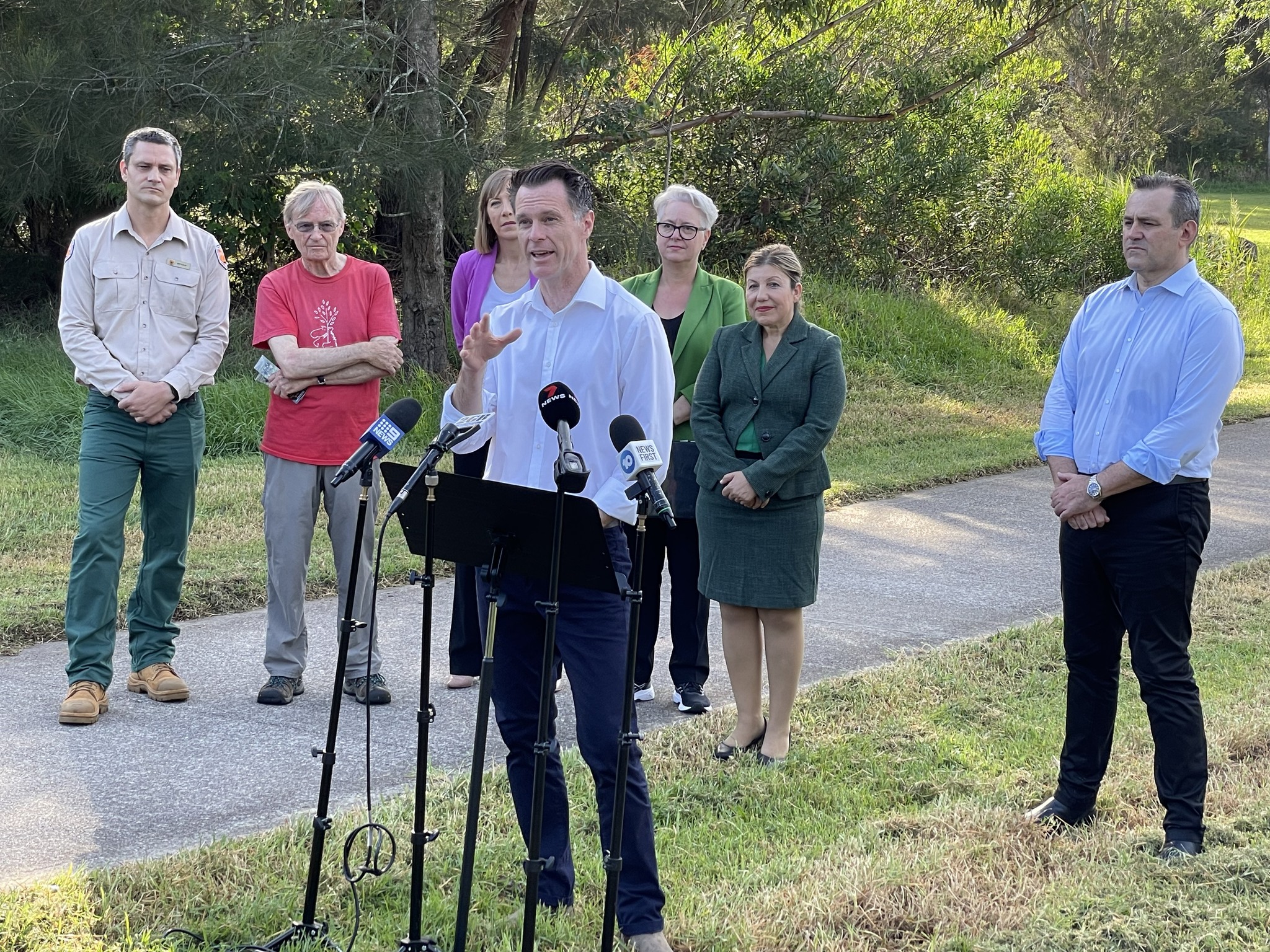
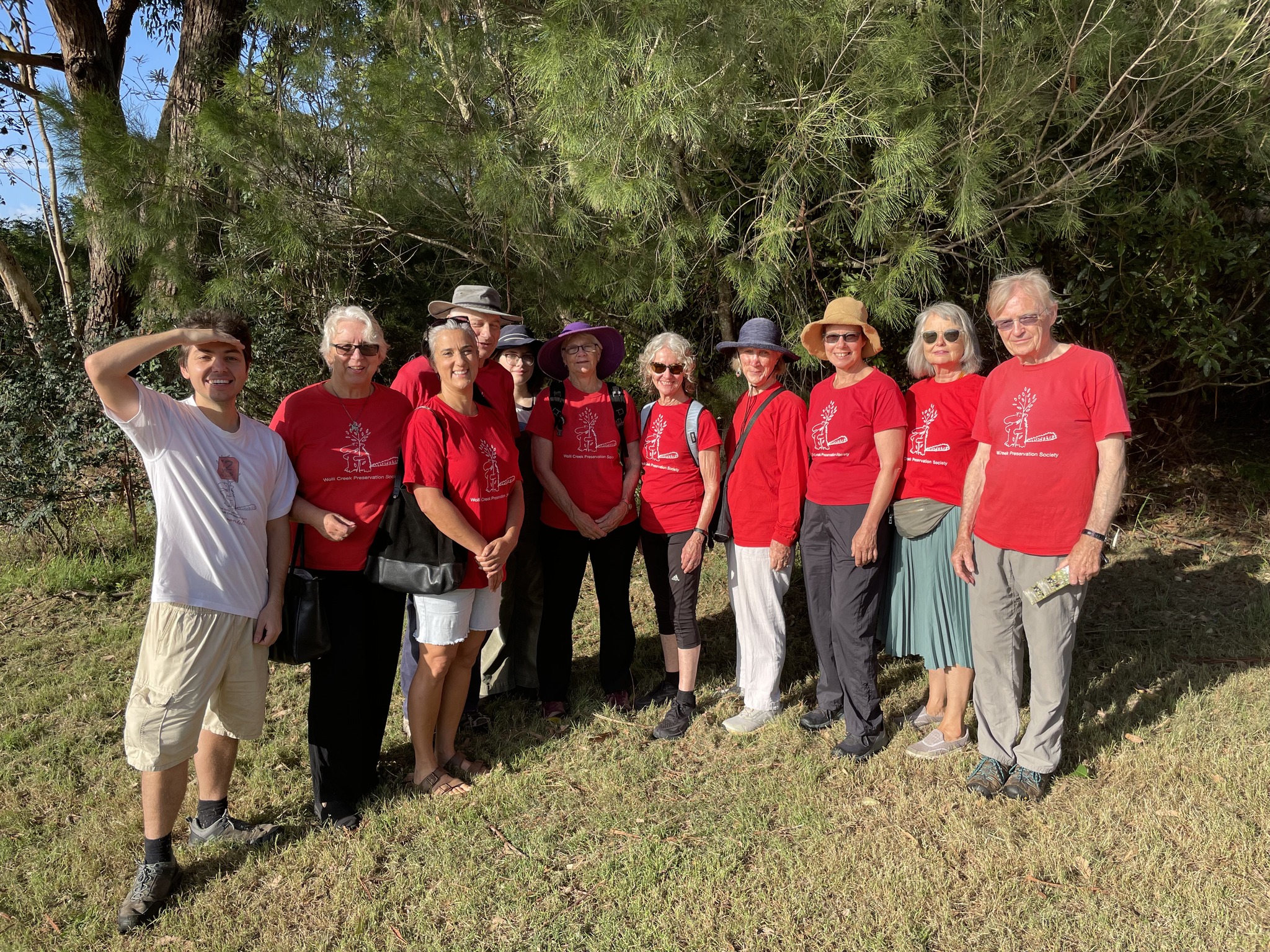
Wolli Creek Preservation Society: Protecting the natural and cultural values of Wolli Creek Valley
- [White A.W.and Burgin S. 2004. "Current status and future prospects of reptiles and frogs in Sydney’s urban-impacted bushland reserves". In Lunney D. and Burgin S. Urban wildlife: more than meets the eye. Mosman, NSW. Royal Zoological Society of New South Wales.]
- [Schell C.B. and Burgin S. 2003. Swimming against the current: the Brown Striped Marsh Frog (Limnodynastes peronii) success story. Australian Zoologist 32: 401–405.]
- DECC. 2007. Wolli Creek site profile: report for the Sydney metropolitan catchment management authority. Hurstville, NSW. Department of Environment and Climate Change.
- DECC. 2008. Management plan for the Green and Golden Bell Frog – key population on the lower Cooks River. Sydney, NSW. Department of Environment and Climate Change.
- Wikipedia contributors. (2023, December 19). Wolli Creek Regional Park. In Wikipedia, The Free Encyclopedia. Retrieved 19:13, March 9, 2024, from https://en.wikipedia.org/w/index.php?title=Wolli_Creek_Regional_Park&oldid=1190692963
Early Autumn Moth + Caterpillar That Will Become A Moth
Lichen Moths (Arctiidae: Lithosiinae) - Alternative Name/S: Footman Moths
Painted Apple Moth Caterpillar
- Dahlia ( Dahlia pinnata, ASTERACEAE ),
- Cypress ( Cupressus, CUPRESSACEAE ),
- Lupins ( Lupinus, FABACEAE ),
- Geranium ( Pelargonium x zonale, GERANIACEAE ),
- Gladiola ( Gladiolus byzantinus, IRIDACEAE ),
- Albizia ( Albizia species, MIMOSACEAE ),
- Banana Fruit ( Musa acuminata, MUSACEAE ),
- Passionfruit ( Passiflora edulis, PASSIFLORACEAE ),
- Primrose ( Primula, PRIMULACEAE ),
- Roses ( Rosa odorata, ROSACEAE ),
- Gardenia ( Gardenia jasminoides, RUBIACEAE ),
- ( Gardenia jasminoides, RUTACEAE ),
- Willow ( Salix, SALICACEAE ),
- Native Cherry ( Exocarpus cupressiformis, SANTALACEAE ),
- Lantana ( Lantana camara, VERBENACEAE ).
- Coral Pea ( Hardenbergia species, FABACEAE ),
- Wattles ( Acacia species, MIMOSACEAE ),
- Bottlebrush ( Callistemon species, MYRTACEAE ),
- Ferns ( POLYPODIOPHYTA ), and
- Spider Flowers ( Grevillea species, PROTEACEAE ).
Harvest Seeds & Native Plants: Education Sessions 2024 - "The Harvest Huddle"
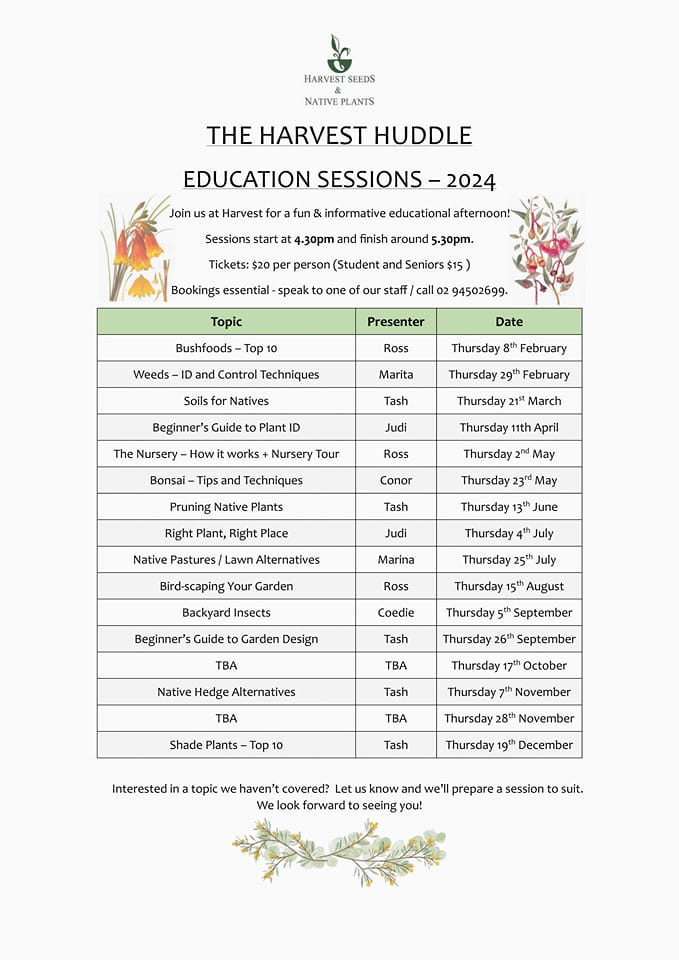
Notice Of 1080 Baiting: February 1 - July 31 2024
Please note the following notification of continuous and ongoing fox control using 1080 POISON with ground baits and canid pest ejectors (CPE’s) in Sydney Harbour National Park, Garigal National Park, Ku-ring-gai Chase National Park, and Lane Cove National Park. As part of this program, baiting also occurs on North Head Sanctuary managed by Sydney Harbour Federation Trust and the Australian Institute of Police Management facility at North Head.
This provides notification for the 6 monthly period of 1 February 2024 – 31 July 2024.
Warning signs are displayed at park entrances and other entrances to the baiting location to inform the public of 1080 baiting.
1080 Poison for fox control is used in these reserves in a continuous and ongoing manner. This means that baits and ejectors (CPE’s) remain in the reserves and are checked/replaced every 6 – 8 weeks.
1080 use at these locations is in accordance with NSW pesticides legislation, relevant 1080 Pesticide Control Orders and the NPWS Vertebrate Pesticides Standard Operating Procedures.
A series of public notifications occur on a 6 monthly basis including; alerts on the NPWS website, public notices in local papers, Area pesticide use notification registers and to the NPWS call centre.
If you have any further general enquiries about 1080, or for specific program enquiries please contact the local NPWS Area office:
For further information please call the local NPWS office on:
NPWS Sydney North (Middle Head) Area office: 9960 6266
NPWS Sydney North (Forestville) Area office: 9451 3479
NPWS North West Sydney (Lane Cove NP) Area office: 8448 0400
NPWS after-hours Duty officer service: 1300 056 294
Sydney Harbour Federation Trust: 8969 2128
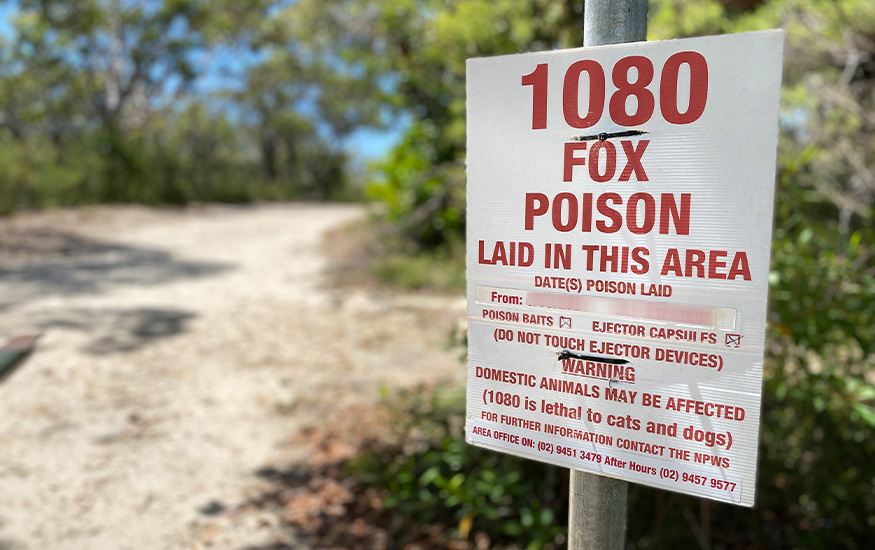
Pittwater Natural Heritage Association: Second PNHA Nature Event 2024
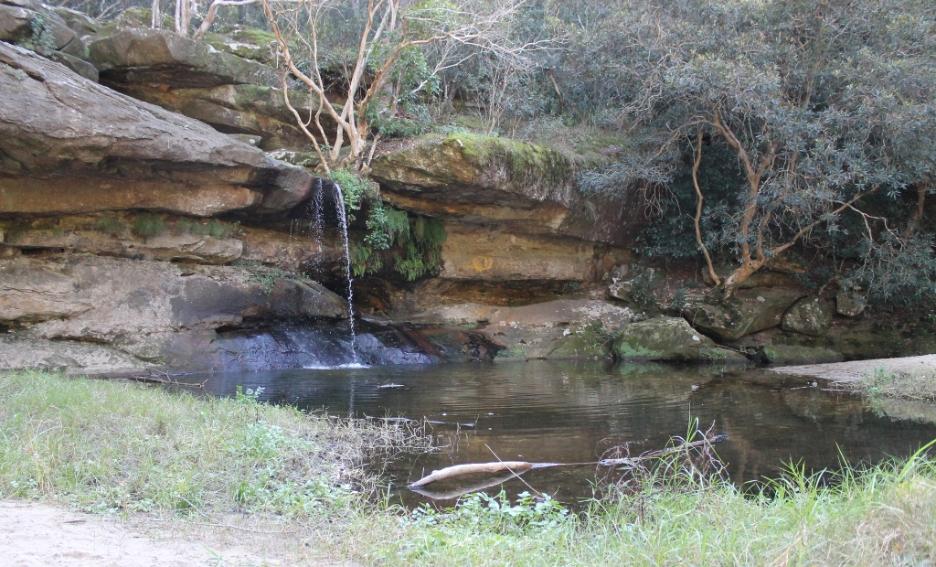
NEW At Eco House & Garden(At Kimbriki): 'Supporting School & Community Composts Workshop'
Where you can become part of the (waste) solution in our 3-hour workshop.
See below for more details and for bookings go to 👉https://www.trybooking.com/events/landing/1162545

Kimbriki Resource Recovery Centre: Early Childhood Educators Professional Development Day
As part of Kimbriki's 2024 Eco House & Garden Educational Calendar, this year we introduce the Early Childhood Educators Professional Development Day on Friday 22nd March. For more details and bookings 👉 https://www.trybooking.com/events/landing/1162305

Upcoming Events At Permaculture Northern Beaches
 Saving Our Seeds is a crucial part of our own food chain and it enables us to grow our own food and plants with no additional costs! The strongest seeds are locally grown over many generations and well adapted to local conditions - so your plants will thrive while you save on costs. Join us with seed-saving guest speakers Mylene Turban, and Elle Sheather to have an overview and to inspire you to get seed-saving!
Saving Our Seeds is a crucial part of our own food chain and it enables us to grow our own food and plants with no additional costs! The strongest seeds are locally grown over many generations and well adapted to local conditions - so your plants will thrive while you save on costs. Join us with seed-saving guest speakers Mylene Turban, and Elle Sheather to have an overview and to inspire you to get seed-saving!About

Stony Range Nursery
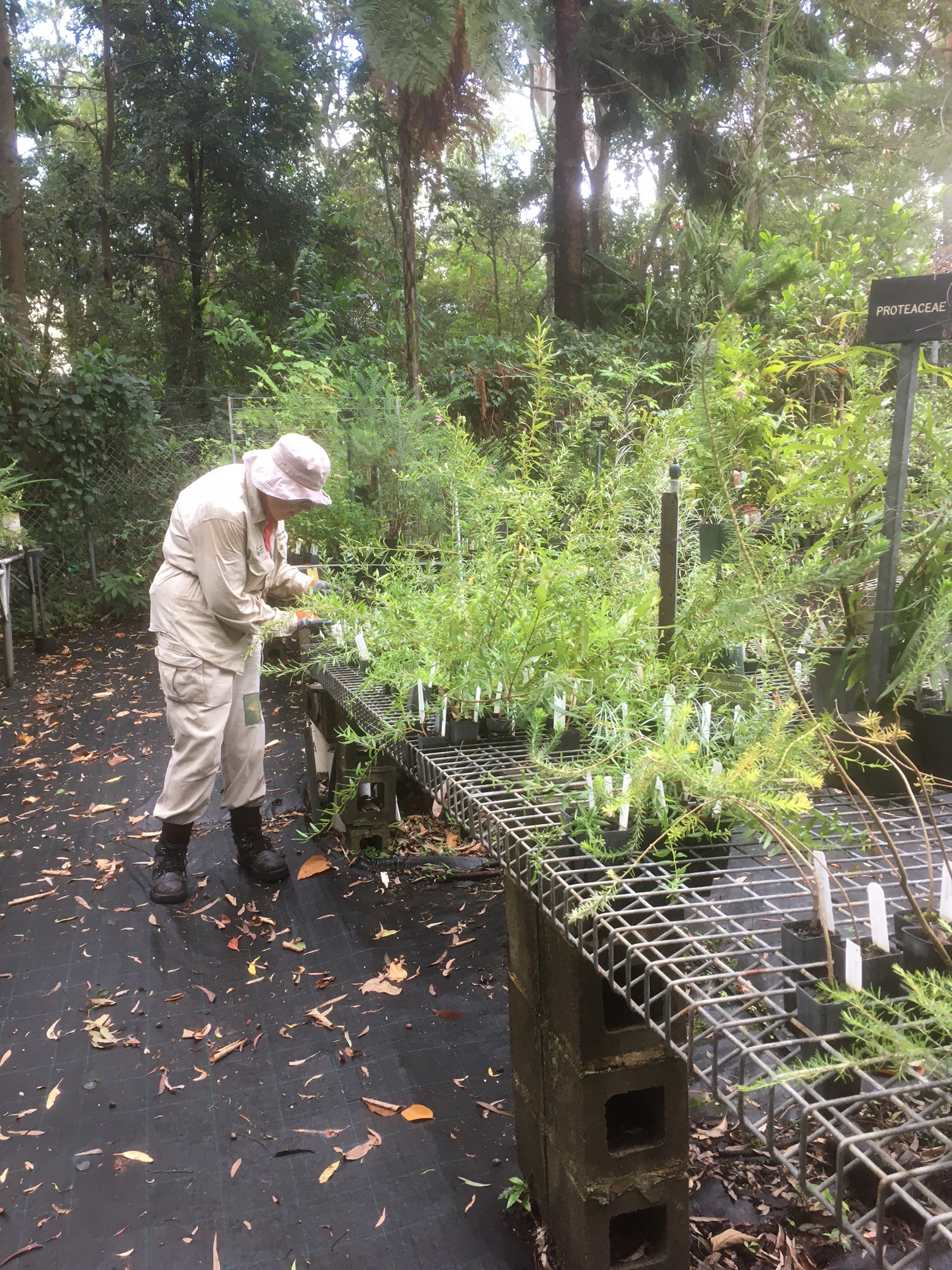
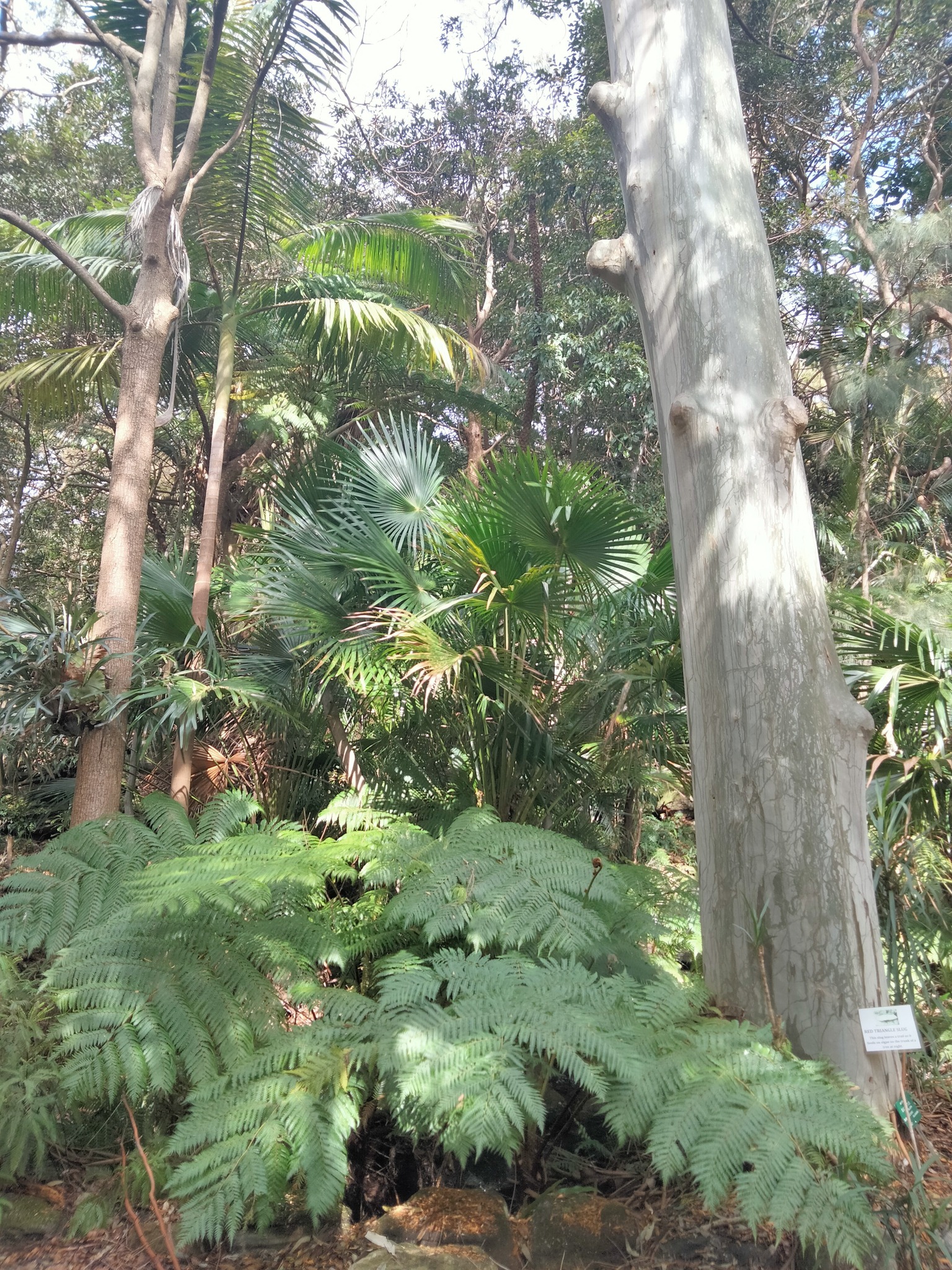
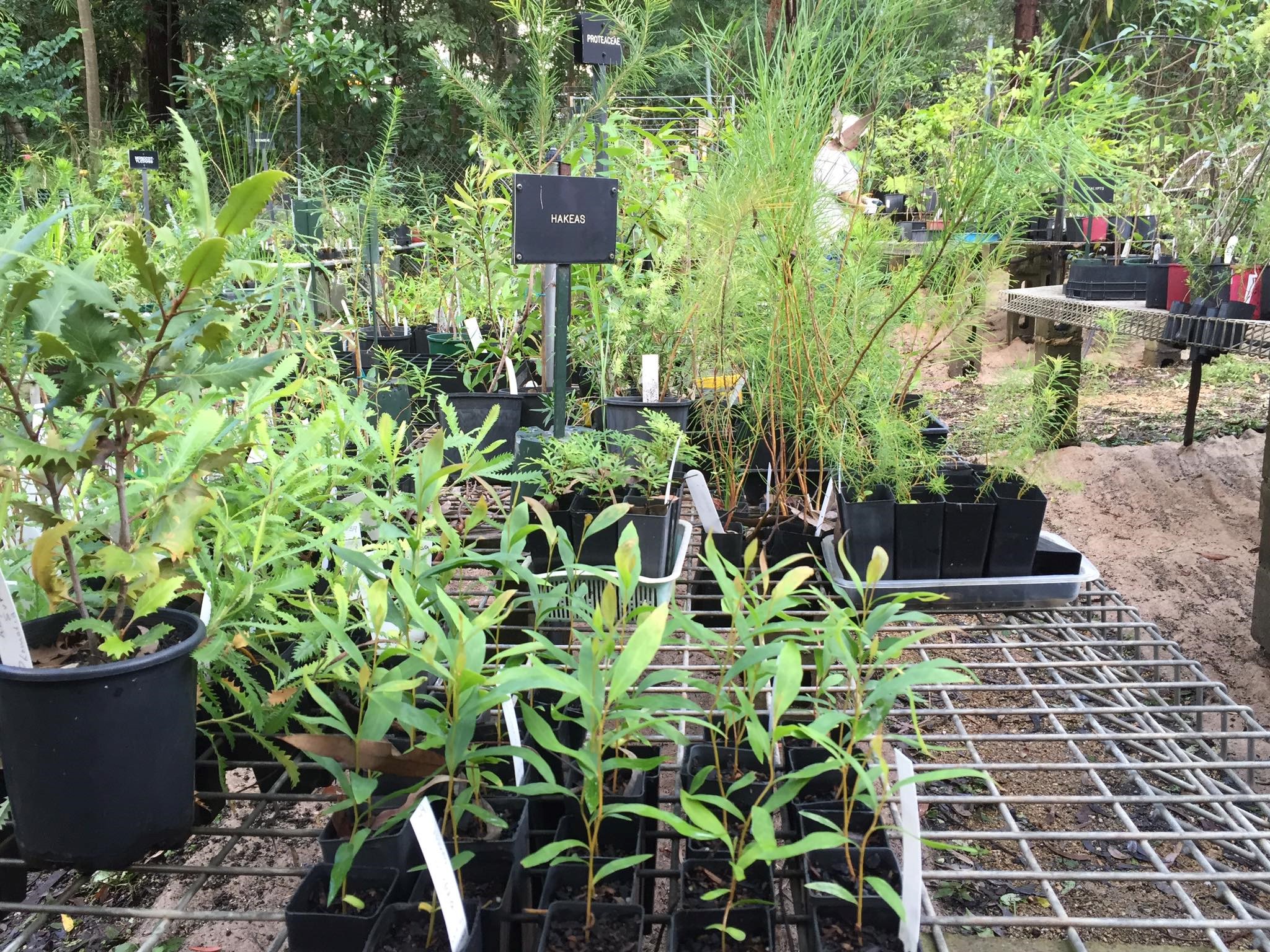
Stay Safe From Mosquitoes
- Applying repellent to exposed skin. Use repellents that contain DEET, picaridin, or oil of lemon eucalyptus. Check the label for reapplication times.
- Re-applying repellent regularly, particularly after swimming. Be sure to apply sunscreen first and then apply repellent.
- Wearing light, loose-fitting long-sleeve shirts, long pants and covered footwear and socks.
- Avoiding going outdoors during peak mosquito times, especially at dawn and dusk.
- Using insecticide sprays, vapour dispensing units and mosquito coils to repel mosquitoes (mosquito coils should only be used outdoors in well-ventilated areas)
- Covering windows and doors with insect screens and checking there are no gaps.
- Removing items that may collect water such as old tyres and empty pots from around your home to reduce the places where mosquitoes can breed.
- Using repellents that are safe for children. Most skin repellents are safe for use on children aged three months and older. Always check the label for instructions. Protecting infants aged less than three months by using an infant carrier draped with mosquito netting, secured along the edges.
- While camping, use a tent that has fly screens to prevent mosquitoes entering or sleep under a mosquito net.
Mountain Bike Incidents On Public Land: Survey
- Mountain Bike Incidents On Public Land: Survey Launched To Gather Data On What's Happening To Public Parks - Community Land - Bush Reserves In Pittwater
- Mother Brushtail Killed On Barrenjoey Road: Baby Cried All Night - Powerful Owl Struck At Same Time At Careel Bay During Owlet Fledgling Season: calls for mitigation measures - The List of 'What You can Do' as requested
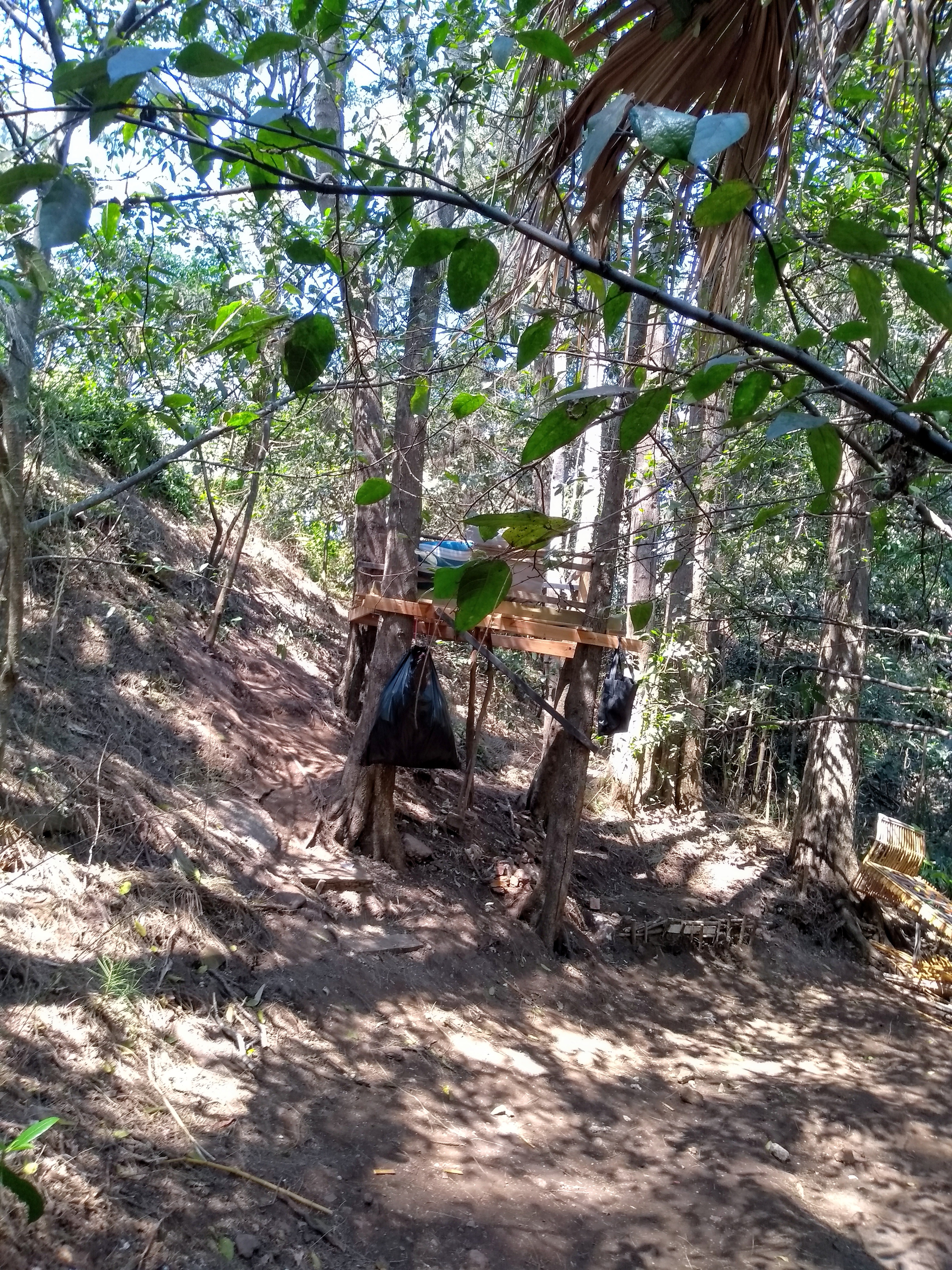
Please Look Out For Wildlife During Heatwave Events

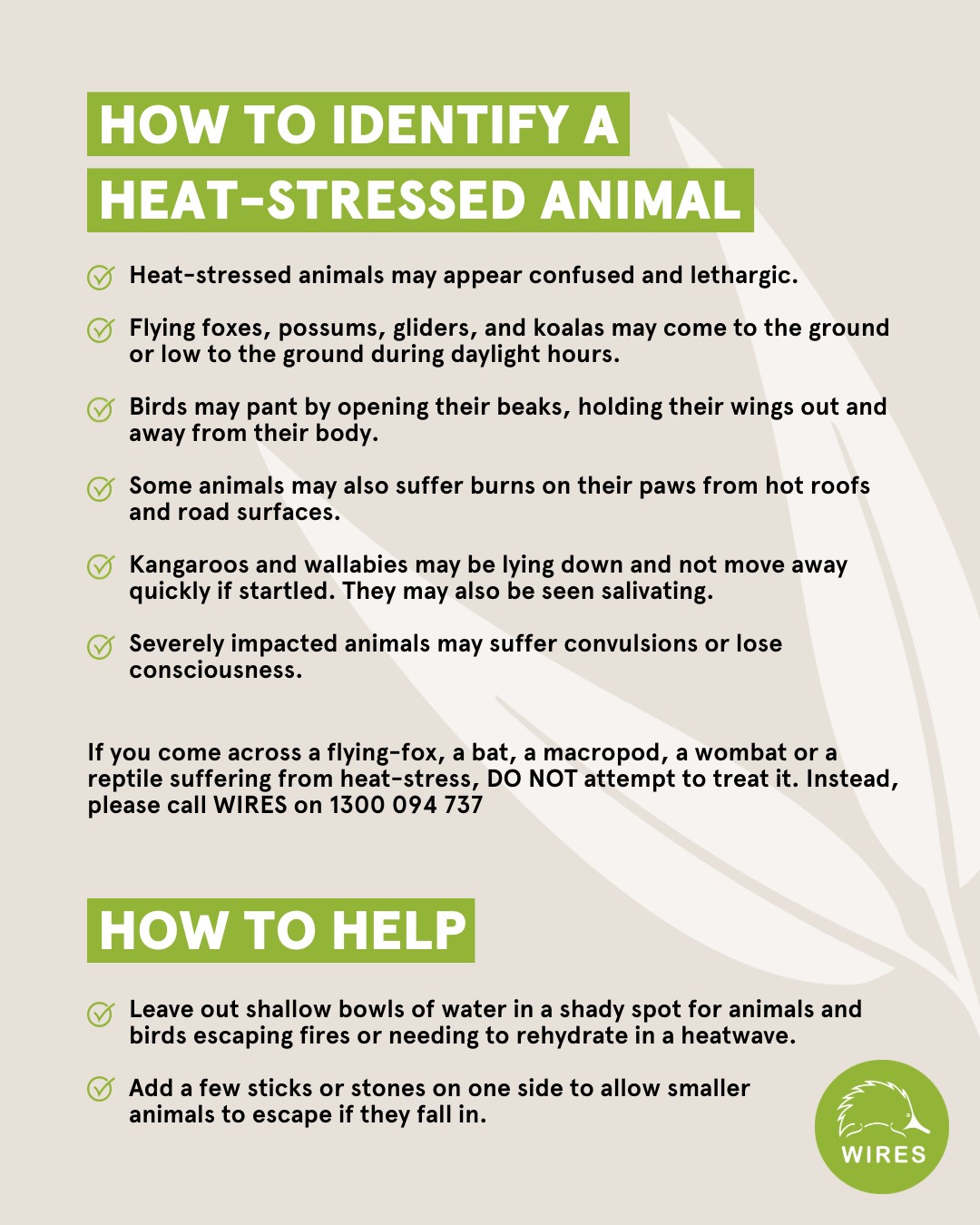
Palmgrove Park Avalon: New Bushcare Group
 Palmgrove Park Avalon is a remnant of the Spotted Gum forest that was once widespread on the lower slopes of the Pittwater peninsula. This bushland’s official name and forest type is Pittwater and Wagstaffe Endangered Ecological Community, endangered because so much has been cleared for suburban development. Canopy trees, smaller trees and shrubs, and ground layer plants make up this community. Though scattered remnant Spotted Gums remain on private land, there is little chance of seedlings surviving in gardens and lawns. More information HERE
Palmgrove Park Avalon is a remnant of the Spotted Gum forest that was once widespread on the lower slopes of the Pittwater peninsula. This bushland’s official name and forest type is Pittwater and Wagstaffe Endangered Ecological Community, endangered because so much has been cleared for suburban development. Canopy trees, smaller trees and shrubs, and ground layer plants make up this community. Though scattered remnant Spotted Gums remain on private land, there is little chance of seedlings surviving in gardens and lawns. More information HERE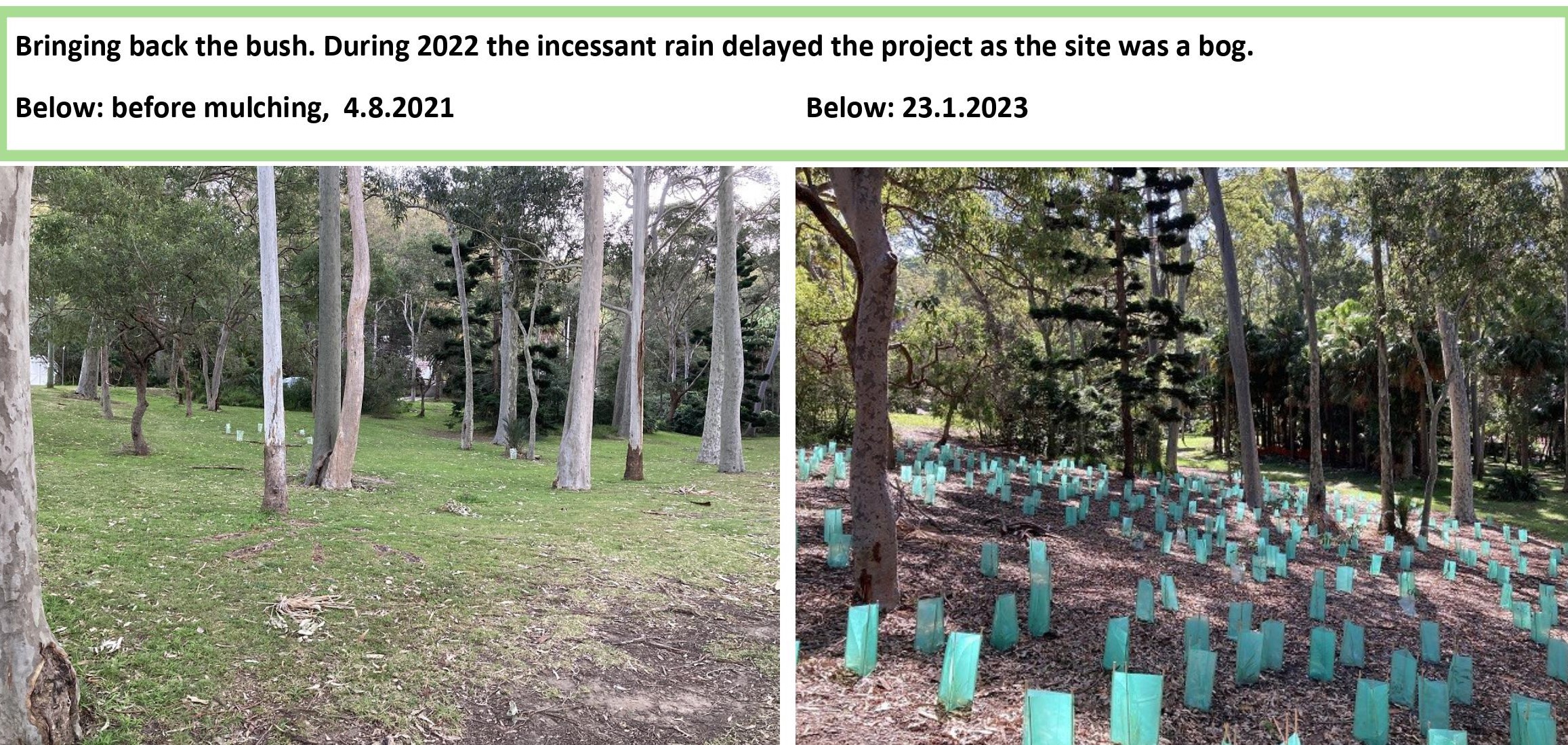
Report Fox Sightings
%20(1).jpg?timestamp=1675893929686)
Marine Wildlife Rescue Group On The Central Coast
A new wildlife group was launched on the Central Coast on Saturday, December 10, 2022.
Marine Wildlife Rescue Central Coast (MWRCC) had its official launch at The Entrance Boat Shed at 10am.
The group comprises current and former members of ASTR, ORRCA, Sea Shepherd, Greenpeace, WIRES and Wildlife ARC, as well as vets, academics, and people from all walks of life.
Well known marine wildlife advocate and activist Cathy Gilmore is spearheading the organisation.
“We believe that it is time the Central Coast looked after its own marine wildlife, and not be under the control or directed by groups that aren’t based locally,” Gilmore said.
“We have the local knowledge and are set up to respond and help injured animals more quickly.
“This also means that donations and money fundraised will go directly into helping our local marine creatures, and not get tied up elsewhere in the state.”
The organisation plans to have rehabilitation facilities and rescue kits placed in strategic locations around the region.
MWRCC will also be in touch with Indigenous groups to learn the traditional importance of the local marine environment and its inhabitants.
“We want to work with these groups and share knowledge between us,” Gilmore said.
“This is an opportunity to help save and protect our local marine wildlife, so if you have passion and commitment, then you are more than welcome to join us.”
Marine Wildlife Rescue Central Coast has a Facebook page where you may contact members. Visit: https://www.facebook.com/profile.php?id=100076317431064
- Ph: 0478 439 965
- Email: marinewildlifecc@gmail.com
- Instagram: marinewildliferescuecc

Watch Out - Shorebirds About
.JPG.opt1460x973o0,0s1460x973.jpg?timestamp=1663629195339)
Possums In Your Roof?: Do The Right Thing

Aviaries + Possum Release Sites Needed

Bushcare In Pittwater: Where + When
Where we work Which day What time
Avalon
Angophora Reserve 3rd Sunday 8:30 - 11:30am
Avalon Dunes 1st Sunday 8:30 - 11:30am
Avalon Golf Course 2nd Wednesday 3 - 5:30pm
Careel Creek 4th Saturday 8:30 - 11:30am
Toongari Reserve 3rd Saturday 9 - 12noon (8 - 11am in summer)
Bangalley Headland 2nd Sunday 9 to 12noon
Bayview
Winnererremy Bay 4th Sunday 9 to 12noon
Bilgola
North Bilgola Beach 3rd Monday 9 - 12noon
Algona Reserve 1st Saturday 9 - 12noon
Plateau Park 1st Friday 8:30 - 11:30am
Church Point
Browns Bay Reserve 1st Tuesday 9 - 12noon
McCarrs Creek Reserve Contact Bushcare Officer To be confirmed
Clareville
Old Wharf Reserve 3rd Saturday 8 - 11am
Elanora
Kundibah Reserve 4th Sunday 8:30 - 11:30am
 Mona Vale
Mona Vale Mona Vale Beach Basin 1st Saturday 8 - 11am
Mona Vale Dunes 2nd Saturday +3rd Thursday 8:30 - 11:30am
Newport
Bungan Beach 4th Sunday 9 - 12noon
Crescent Reserve 3rd Sunday 9 - 12noon
North Newport Beach 4th Saturday 8:30 - 11:30am
Porter Reserve 2nd Saturday 8 - 11am
North Narrabeen
Irrawong Reserve 2nd Saturday 2 - 5pm
Palm Beach
North Palm Beach Dunes 3rd Saturday 9 - 12noon
Scotland Island
Catherine Park 2nd Sunday 10 - 12:30pm
Elizabeth Park 1st Saturday 9 - 12noon
Pathilda Reserve 3rd Saturday 9 - 12noon
Warriewood
Warriewood Wetlands 1st Sunday 8:30 - 11:30am
Whale Beach
Norma Park 1st Friday 9 - 12noon
Western Foreshores
Coopers Point, Elvina Bay 2nd Sunday 10 - 1pm
Rocky Point, Elvina Bay 1st Monday 9 - 12noon
Friends Of Narrabeen Lagoon Catchment Activities

Gardens And Environment Groups And Organisations In Pittwater
- Ringtail Posse: 1 – February 2023; Anna Maria Monticelli: King Parrots/Water Dragons - Jacqui Scruby: Loggerhead Turtle - Lyn Millett OAM: Flying-Foxes - Kevin Murray: Our Backyard Frogs - Miranda Korzy: Brushtail Possums
- Ringtail Posse: 2 - March 2023; Kevin Murray: Tawny Frogmouth - Kayleigh Greig: Red-Bellied Black Snake - Bec Woods: Australian Water Dragon - Margaret Woods: Owlet-Nightjar - Hilary Green: Butcher Bird - Susan Sorensen: Wallaby
- Ringtail Posse 3 - April 2023: Jeffrey Quinn: Kookaburra, Tom Borg McGee: Kookaburra, Stephanie Galloway-Brown: Bandicoot, Joe Mills: Noisy Miner
- Ringtail Posse 4 May 2023 - Andrew Gregory: Powerful Owl, Marita Macrae: Pale-Lipped Or Gully Shadeskink, Jools Farrell: Whales & Seals, Nicole Romain: Yellow-Tailed Black Cockatoo
- Ringtail Posse 5: June 2023 - Lynleigh Greig OAM: Snakes, Dick Clarke: Diamond Python, Selena Griffith: Glossy Black-Cockatoo, Eric Gumley: Bandicoot
- Ringtail Posse 6: July 2023 - Sonja Elwood: Long-Nosed Bandicoot, Dr. Conny Harris: Swamp Wallaby, Neil Evers: Bandicoot, Bill Goddard: Bandicoot
- Ringtail Posse 7: August 2023 - Geoff Searl OAM: Tawny Frogmouth, Peter Macinnis: Echidna, Peter Carter: Ringtail Possum, Nathan Wellings; Kookaburra
- Ringtail Posse 8: September 2023 - Saving Sydney's Last Koalas; Logging Now Stopped In Future Koala Park By Minns Government - ''Is There Time To Save Sydney's Last Koalas Too?'' Asks: John Illingsworth, WIRES, Sydney Wildlife Rescue, Save Sydney Koalas, The Sydney Basin Koala Network, The Help Save The Wildlife & Bushlands In Campbelltown Group, Appin Koalas Animal Rescue Service, Patricia and Barry Durham, Sue Gay, Save Mt. Gilead, Paola Torti Of The International Koala Intervention Group
- Ringtail Posse 9: October 2023 - David Palmer OAM: Bandicoots, Helen Pearce: Brushtail Possum, Amina Kitching: Goanna, David Goudie: Ringtails Possums + Bandicoots + Owls
- Mother Brushtail Killed On Barrenjoey Road: Baby Cried All Night - Powerful Owl Struck At Same Time At Careel Bay During Owlet Fledgling Season: calls for mitigation measures - The List of what you can do for those who ask 'What You I Do' as requested
- Ringtail Posse 10: November 2023 - Stop Wildlife Roadkill Group: You Can Help By Using The Wildlife Incident Mapping Website
More Green Space To Enhance Liveability In NSW Communities: Metropolitan Greenspace Program + Community Gardens Program Grants Now Open
- Metropolitan Greenspace Program. All councils in the Greater Sydney region and Central Coast Council are eligible and encouraged to apply by 29 April 2024. Successful applicants will be announced in June 2024.
- Places to Roam Community Gardens program. Applications close on 29 March 2024.
Wongkumara People – Native Title Act: Have Your Say
- Informal submission
- Mailout
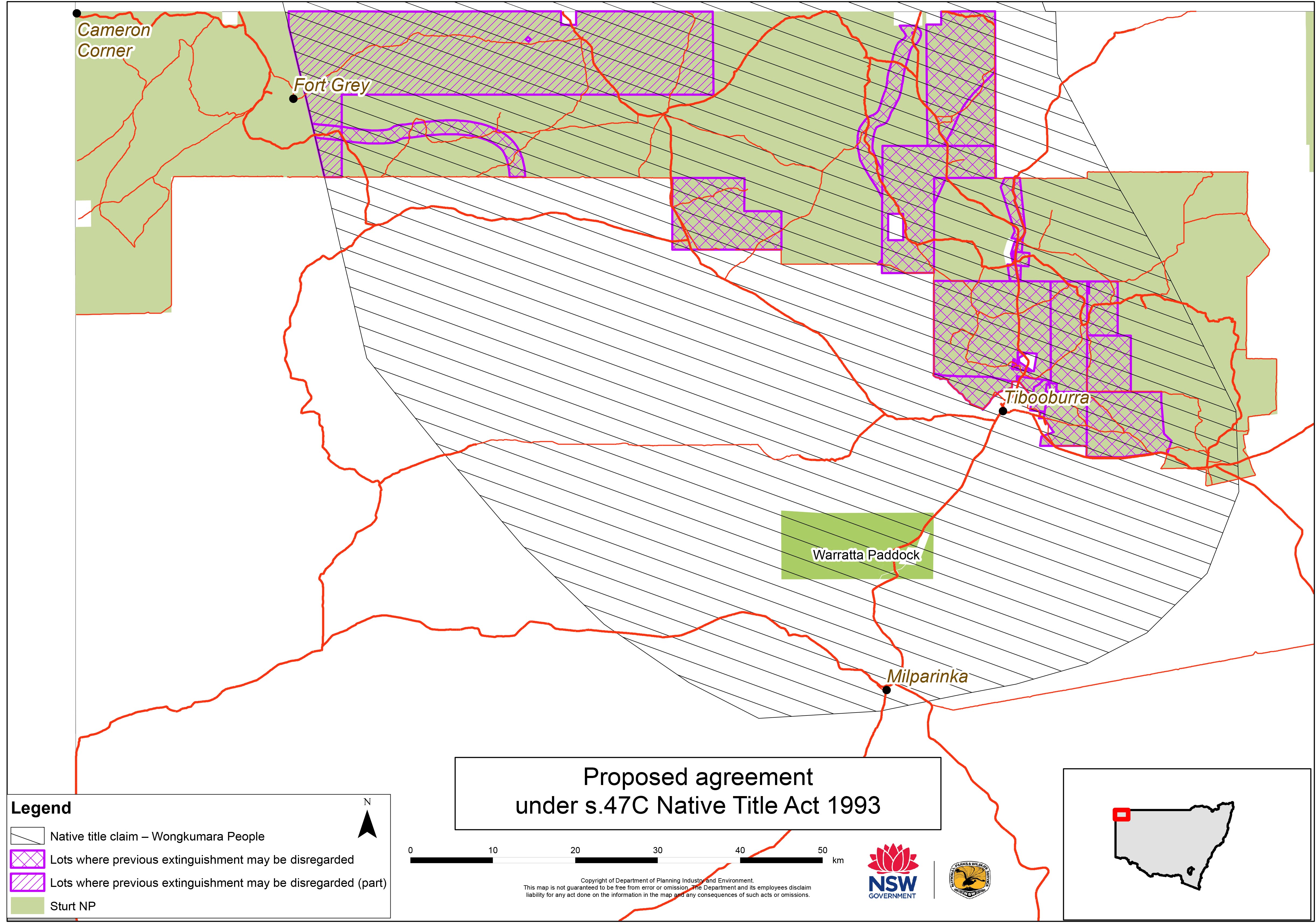
Widjabul Wia-Bal People – Notice Under The Native Title Act: Have Your Say
- Boatharbour Nature Reserve
- Tuckean Nature Reserve
- Muckleewee Mountain Nature Reserve
- Goonengerry National Park
- Victoria Park Nature Reserve
- Mount Jerusalem National Park
- Nightcap National Park
- Davis Scrub Nature Reserve
- Snows Gully Nature Reserve
- Tucki Tucki Nature Reserve
- Andrew Johnson Big Scrub Nature Reserve
- Whian Whian State Conservation Area.
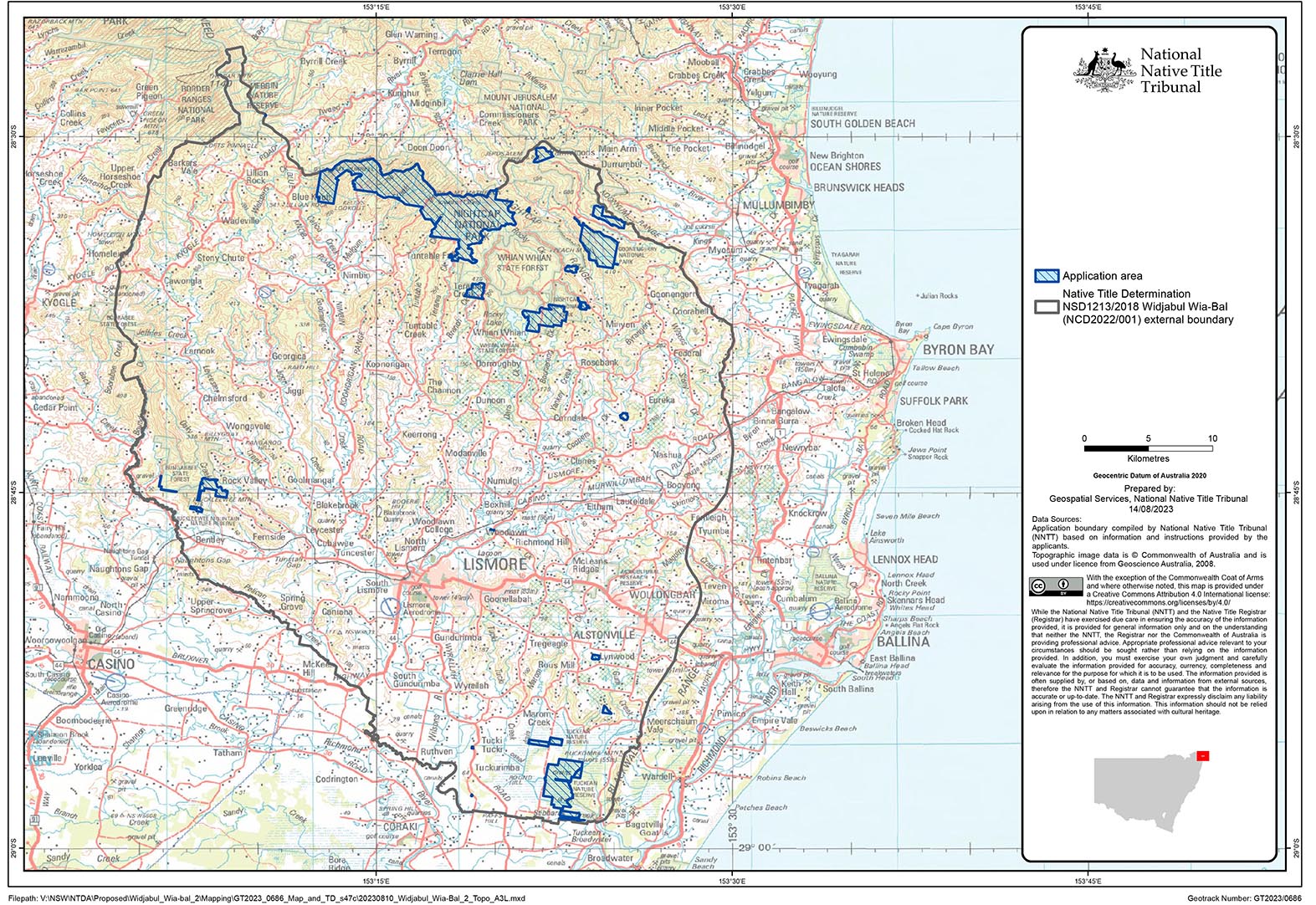
Environmental Grants Connect To Country: Applications Close 2 April 2024
Independent Review Of Small-Scale Titles: Have Your Say
Crown Land Management Act 2016 Review: Have Your Say
.jpg?timestamp=1708537972385)
Coastal Floodplain Drainage Project: Have Your Say
- addressing the complexity, time and costs associated with the approvals process
- reducing the impact of these works and activities on downstream water quality, aquatic ecosystems, communities and industries.
- Option 1: One-stop shop webpage - A single source of information on the various approvals that may be required by government agencies for coastal floodplain drainage works.
- Option 2: Drainage applications coordinator - A central officer(s) to guide the applicant through the approvals processes for all NSW government agencies (Department of Planning and Environment’s Water Group, Planning, Crown Lands, and the Department of Primary Industries — Fisheries) and answer the applicant’s questions about their individual location and proposed works. The drainage applications coordinator would complement both Option 1 and Option 3.
- Option 3: Concurrent assessment - Concurrent assessment of applications by relevant government agencies.
- Option 4: Risk-based approach - NSW Government agencies would use a standardised risk matrix to compare the type and extent of the drainage works against the acidic water and blackwater potential of the drainage area to identify the level of risk associated with the proposed works. The identified level of risk could then be used to determine the level of information required from applicants, the level of assessment required by the approval authority, and the types of conditions applied to any approvals.
- Option 5: Drainage work approvals under the Water Management Act 2000 - Switch on drainage work approvals under the Water Management Act 2000. Two different methods of implementation are possible:
i. a drainage work approval would be required only when works are proposed and for the area of works onlyii. a drainage work approval could apply to existing and new drainage works across the entire drainage network.
Within either of these two methods, one of three different approaches for public authorities could be applied:
a. require public authorities to hold a drainage work approvalb. allow for public authorities to hold a conditional exemption from requiring approvalsc. exempt public authorities from requiring a drainage work approval.
- Option 6: Streamlining of Fisheries and Crown Land approvals through the use of drainage work approvals - Drainage work approvals, particularly under Option 5(ii), have the potential to deliver a catchment-wide consideration of the drainage network. This would provide greater certainty to other agencies such as Fisheries and Crown Land that environmental impacts have been considered and appropriate conditions applied, supporting them to assess and issue approvals more quickly.
- Tuesday 5 March 2024 - Register to attend
- Friday 8 March 2024 - Register to attend
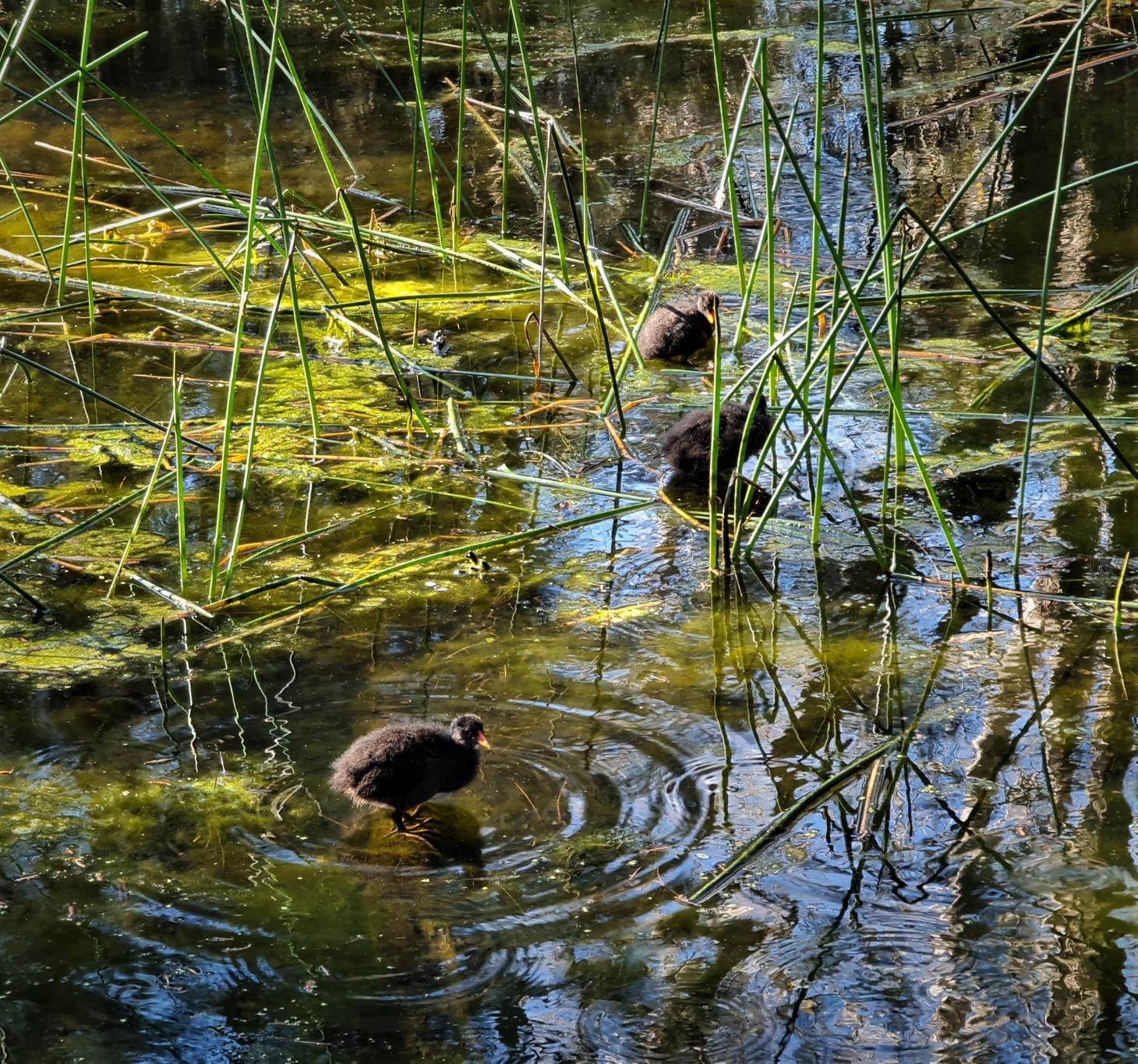
Australia’s Eucalypt Of The Year Voting Opens Today In Your Backyard!
- Dwarf Apple Angophora hispida
- Ghost Gum Corymbia aparrerinja
- Red-flowering Gum Corymbia ficifolia
- Silver Princess Eucalyptus caesia
- Argyle Apple Eucalyptus cinerea
- Yellow Gum Eucalyptus leucoxylon
- Risdon Peppermint Eucalyptus risdonii
- Coral Gum Eucalyptus torquata
- Heart-leaved Mallee Eucalyptus websteriana
- Lemon-flowered Gum Eucalyptus woodwardii
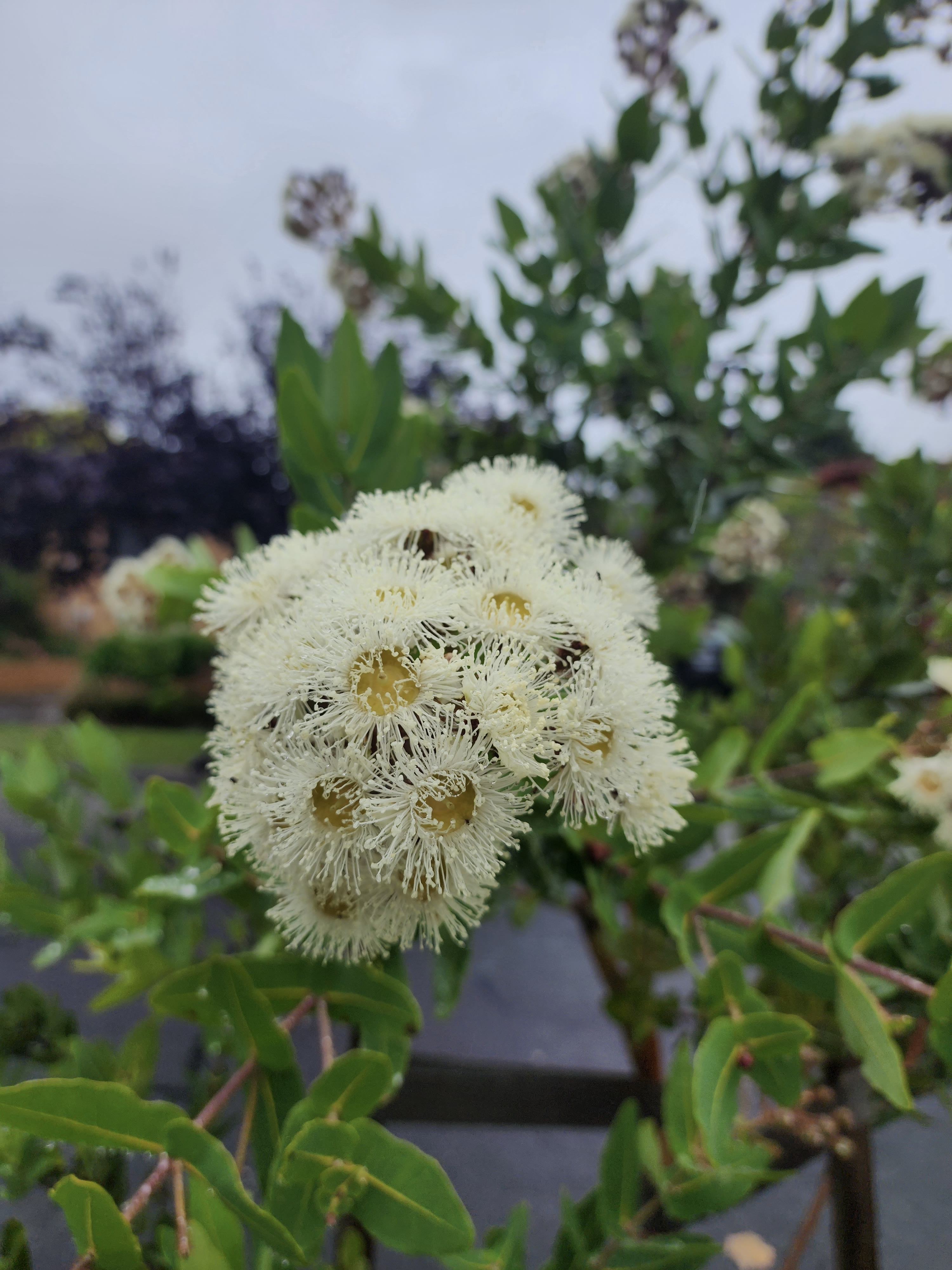
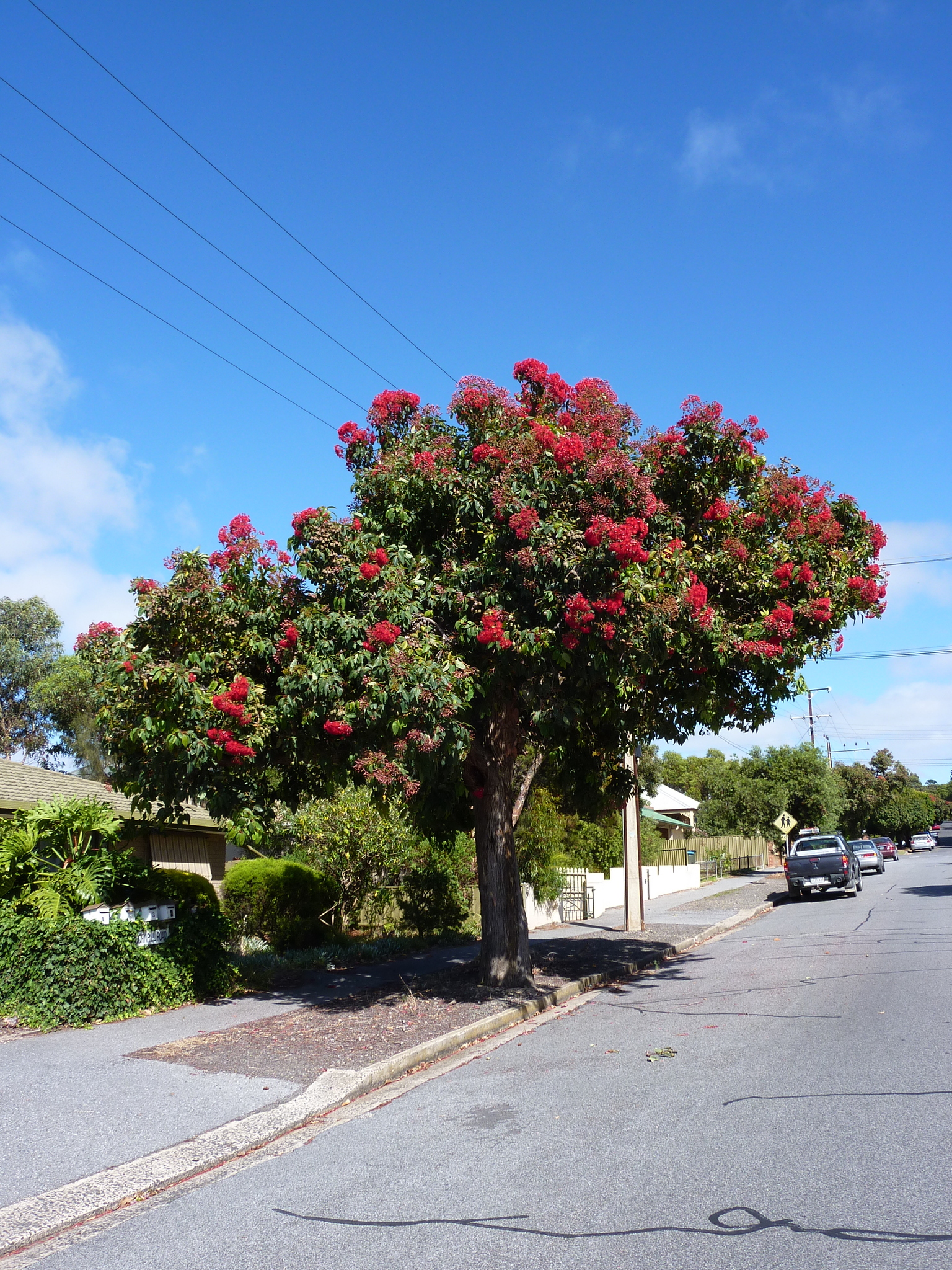
Milestone Reached In Doubling Landcare Funding
- Fund the employment of up to 7.5 full-time equivalent staff to provide centralised support to host organisations and coordinators funded through the Program.
- Establish a Shared Services Hub that provides centralised support to host organisations and coordinators funded under the Local and Regional Coordinators Grants across a range of business services, but specifically administration and human resources.
- Implement and manage a state Community of Practice including Landcare state gatherings, conferences and regional events.
- Implement and manage a Digital Landcare solution to improve reporting processes and knowledge sharing for program participants.
- Develop and maintain strategic partnerships and leverage investment, to increase Landcare’s self-sustenance and reduce reliance on direct NSW Government funding over the medium to longer term.
Cultural burning is better for Australian soils than prescribed burning, or no burning at all
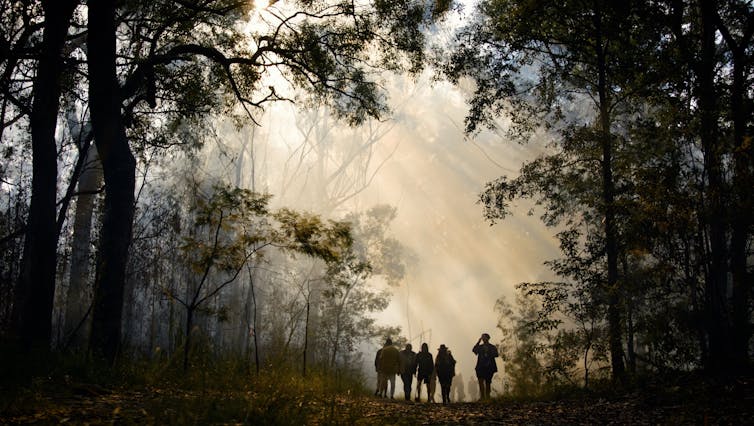
Imagine a landscape shaped by fire, not as a destructive force but as a life-giving tool. That’s the reality in Australia, where Indigenous communities have long understood the intricate relationship between fire, soil and life. Cultural burning has been used for millennia to care for landscapes and nurture biodiversity. In contrast, government agencies conduct “prescribed burning” mainly to reduce fuel loads.
In our new research, we compared cultural burning to agency-led prescribed burning or no burning. We studied the effects on soil properties such as moisture content, density and nutrient levels.
Both fire treatments increased soil moisture and organic matter, while reducing soil density. That means burning improved soil health overall. But cultural burning was the best way to boost soil carbon and nitrogen while also reducing soil density, which improves the soil’s ability to nurture plants.
Understanding the effects of different fire management techniques is crucial for developing more sustainable land management practices. By studying what happens to the soil, we can work out how best to promote healthy, resilient ecosystems while also reducing risks of uncontrolled bushfires.
The Vital Role Of Fire
Fire has shaped Australian landscapes for millions of years, transforming ecosystems and influencing biodiversity.
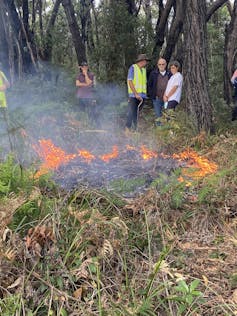
For Indigenous Australians, fire is not just a tool but a way of life. Fire is used to care for Country, for cultural purposes including ceremonies, to promote new plant growth and food resources, and to facilitate hunting and gathering.
Cultural burning is only ever conducted when it will benefit the health of Country. It is a practice deeply rooted in Indigenous knowledge and traditions. Fires are small, slow and cool. Practitioners read signs in the environment in relation to the local flora and fauna that provide guidance on the right time to burn.
In comparison, prescribed burning, conducted by government agencies, is principally conducted to reduce fuel loads and minimise the risk of wildfires. Fires are often larger and burn hotter than cultural burning.
In recent times, bushfires have become more frequent and severe in parts of Australia. So understanding and supporting Indigenous-led fire management practices is becoming increasingly important for sustainable land management.
Unlocking The Secrets Of Soil Health
Our new research sheds light on the impact of fire management techniques on soil properties. The study was conducted on the south coast of New South Wales, on land managed by the Ulladulla Local Aboriginal Land Council. At this plot, one area of land experienced no burn, another was burnt by NSW Rural Fire Service and another experienced a cultural burn.
While the area burnt was relatively small, about 5,000 square metres for each plot, it can still help shed a light on the effect of fire treatments on soil properties.
We found both agency-led prescribed burning and cultural burning increased soil moisture levels. There may be different reasons for this. For soils that experienced the cultural burn, the extra moisture could be explained by the reduction in soil density, which promotes water flow. For soils that experienced the agency-led prescribed burn, where density didn’t decrease much, it’s possible the hotter fire removed the water-repellant layer of soil that sometimes develops following a fire, allowing more moisture to soak in.
Cultural burning had a more pronounced effect on reducing soil density and increasing organic matter content. Having more organic matter in the soil means more nutrients such as carbon and nitrogen are available to plants. Lower density improves soil structure. Both improve the capacity of ecosystems to withstand environmental stress such as drought and wildfire.
These findings suggest cultural burning not only benefits soil health but also helps make ecosystems more resilient, by providing more water and nutrients that native plants need.
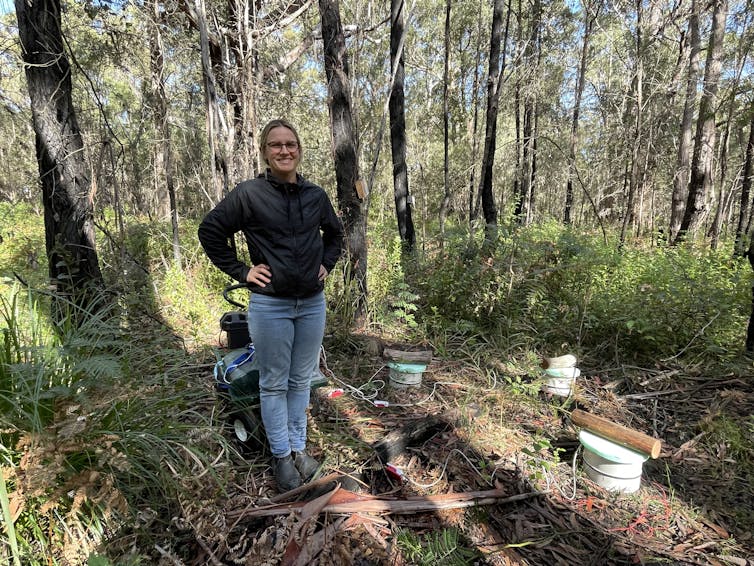
Embracing Indigenous Wisdom
Indigenous communities use cultural land management practices, of which cultural burning is one tool, to care for Country as kin. They do not see themselves as separate to the environment. Instead their practices are guided by place-based knowledge that weaves human, spiritual and ecological needs together in a symbiotic relationship where one cannot thrive without the other.
Supporting Indigenous-led fire practices is not just about what it can do for the environment. It’s also a recognition of the deep cultural and spiritual connections Indigenous communities have with the land.
By learning from and working with Indigenous communities, we can foster a more harmonious relationship with Country, one that benefits both people and the environment.

Rekindling Our Relationships
Indigenous fire management practices offer invaluable wisdom and the potential to transform our approach to land stewardship.
By embracing these practices, we can nurture healthier soils, promote biodiversity, and foster more resilient ecosystems.
Practically, to make this possible, ongoing investment is required to build the capacity of Indigenous communities to fulfil their obligations to care for Country. Policies must be updated to allow greater access to Country and to reduce red tape and bureaucracy.
There is a danger here. Government agencies often want to incorporate or take on some of the principles of cool burns themselves, forgetting the cultural aspects and the need for this to be Indigenous-led. We must understand this is not just about managing fires, it’s about rekindling our relationship with the land and learning from those who have lived in harmony with it for thousands of years. ![]()
Anthony Dosseto, Professor, University of Wollongong; Katharine Haynes, Honorary Senior Research Fellow, University of Wollongong; Leanne Brook, CEO, Ulladulla Local Aboriginal Land Council, Indigenous Knowledge, and Victor Channell, Murramarang and Walbunga Elder, Indigenous Knowledge
This article is republished from The Conversation under a Creative Commons license. Read the original article.
The Gomeroi win puts native title holders in a stronger position to fight fossil fuel projects on their land
Lily O'Neill, The University of Melbourne and Rebekkah Markey-Towler, The University of MelbourneIn a significant win for the Gomeroi People, the Federal Court has ruled climate change impacts must be properly considered when determining whether a fossil fuel project can go ahead on native title land.
This is the latest in a series of disputes involving First Nations people fighting to prevent coal, oil and gas projects on their land. It’s part of the growing trend of First Nations people spearheading climate litigation. For example, cases involving Raelene Cooper, Dennis Tipakalippa, and Pabai Pabai.
This week’s legal decision is the first of its kind because the Court ruled climate change must be part of the public interest test before the National Native Title Tribunal can allow a project to proceed on native title land.
The decision puts native title holders in a stronger position when fighting to prevent future fossil fuel projects. There’s no guarantee of success, but it’s clear climate impacts can no longer be dismissed.
An Uphill Battle For Traditional Owners
The win for the Gomeroi People was about a dispute relating to native title approvals made by the National Native Title Tribunal in 2022. This gave the Australian oil and gas company Santos permission to proceed with plans to extract gas from forest and farmland around Narrabri, in northern New South Wales.
Up to 850 gas wells would be drilled over 20 years to extract coal seam gas. The wells and infrastructure, including gas processing and water treatment facilities, would be located within 1,000 hectares of the 95,000ha project area.
Under the Native Title Act companies like Santos are required to negotiate with the land’s Traditional Owners for at least six months with a view to reaching an agreement.
But an obligation to negotiate does not mean there is an obligation to reach an agreement. Traditional Owners cannot veto the project. And even without an agreement the company can apply to the tribunal to grant native title approvals.
Companies know they are likely to win once they get to the tribunal. The tribunal has only ever sided with native title holders trying to prevent resource extraction project on their Country three times, most recently back in 2011. In comparison, it has sided with the developer 149 times.
The tribunal must look at a range of factors when reaching its decision. This includes the public interest.
The Gomeroi People argued greenhouse gas emissions from the Santos project would cause unacceptable damage to their Country, and also contribute to global climate change, and therefore the project was not in the public interest.
They enlisted an expert witness, the late and highly respected climate scientist Professor Will Steffen, who told the tribunal in 2021 that the project was expected to result in between 109.75 million and 120.55 million tonnes of extra carbon dioxide (or equivalent) into the atmosphere.
The continued expansion of the fossil fuel industry, Steffen said, would result in the Narrabri region experiencing “more extreme heat, further and more intense droughts, harsher fire danger weather, and heavier rainfall when it occurs, all of which will continue to increase in frequency and intensity”.
The tribunal’s then president, John Dowsett, concluded that while he accepted greenhouse gas emissions were warming the planet, it was not in his remit to consider climate change when looking at the public interest. Rather, he said, he had to consider factors such as whether the project was of “economic significance to Australia, the State and the region, as well as Aboriginal people”.
He ruled that it was, and also opined that Steffen should have been more deferential to the NSW Independent Planning Commission’s views that the project would have an acceptable impact on climate. Steffen was just “one scientist”, Dowsett said, and it was “disturbing” that he should dismiss the authority’s view.
Dowsett even referenced the classic climate fallacy about there being two sides to the argument: “there are conflicting views concerning climate change and knowledge is rapidly expanding”.
A Groundbreaking Win
The Federal Court was clearly not impressed, this week delivering the tribunal a judicial slap. The court said the definition of what was in the public interest was wide, and in this case, consideration of climate change impacts clearly fell within that definition.
In her judgement, Federal Court Chief Justice Debra Mortimer pointed out that Steffen was not just one scientist, but rather was on a panel of experts of the United Nations’ Intergovernmental Panel on Climate Change, representing the world’s leading climate scientists.
Gomeroi Traditional Owners reacted to the decision with happiness, pride and celebration.
Gomeroi Elder Maria (Polly) Cutmore released a statement saying:
Santos now have to decide what they are going to do, we strongly encourage them to withdraw their operations from the Pilliga forest and our floodplains for good. That would respect our culture and law and Santos would be better off for it.
Santos responded to the case by saying it has “at all times negotiated with the Gomeroi people in good faith”.
This is not the first time First Nations people have led the way in holding decision makers accountable for the climate consequences of their actions. Indeed, Australia has been a particularly active jurisdiction for climate litigation, the jurisdiction with the second-highest number of cases worldwide. The Australian and Pacific Climate Litigation database we run at the University of Melbourne records these cases.
We expect more of these disputes to arise in the future.
What Comes Next?
For the Gomeroi People, the matter will likely be sent back to the tribunal with instructions to revisit the decision. This time, we hope, climate change will be forefront in the decision-making process.
The broader implications of this latest ruling are still unclear. It is conceivable the tribunal will reconsider the climate impacts and yet still arrive at the same conclusion.
Alternatively, this case could be the start of more significant engagement with climate issues in Australian courts, led by First Nations people.![]()
Lily O'Neill, Senior Research Fellow, Melbourne Climate Futures, The University of Melbourne and Rebekkah Markey-Towler, PhD Candidate, Melbourne Law School, and Research fellow, Melbourne Climate Futures, The University of Melbourne
This article is republished from The Conversation under a Creative Commons license. Read the original article.
Fished for their meat and liver oil, many remarkable deep-water sharks and rays now face extinction

The deep ocean, beyond 200 metres of depth, is the largest and one of the most complex environments on the planet. It covers 84% of the world’s ocean area and 98% of its volume – and it is home to a great diversity of species.
Yet it remains among the least studied places on Earth, with no comprehensive assessments of the state of deep-water biodiversity and no policy-relevant indicators to guide the taking of species targeted by fisheries.
This also applies specifically to deep-water sharks and rays, even though these species make up nearly half of the recognised diversity of all cartilaginous fishes (sharks, rays, and chimaeras) we know today.
Our research highlights how our growing impact on the deep ocean raises the threat to these species.
Using the International Union for Conservation of Nature Red List of Threatened Species, we show that the number of threatened deep-water sharks and rays has more than doubled between 1980 and 2005, following the emergence and expansion of deep-water fishing.
We estimate one in seven species (14%) are threatened with extinction.
Fishing For Meat And Oil
Deep-water sharks and rays are in a group of marine vertebrates that are most sensitive to overexploitation. This is because of their long lifespans (possibly up to 450 years for the Greenland shark, Somniosus microcephalus) and low reproduction rate (only 12 pups in a lifetime for the gulper shark, Centrophorus granulosus).
These biological characteristics make them similar to formerly exploited, and now highly protected, marine mammals.

The Greenland shark and the leafscale gulper shark (Centrophorus squamosus), for example, have population growth rates comparable to the sperm whale (Physeter macrocephalus) and the walrus (Odobenus rosmarus), respectively. Despite their known inherent vulnerability, there are very few species-specific management actions for deep-water sharks.
Our research shows that overfishing is the primary threat to deep-water sharks and rays. They are used for their meat and liver oil, which drives targeted fisheries but also incidental capture, meaning any accidental catches are retained by fisheries targeting other species.
In many nations, deep-water sharks and rays are regarded as a welcome catch because of the high value of their liver oil and high demand for skate meat. These are not new trades, but the global expansion and diversification of use, particularly for shark liver oil, is a relatively new phenomenon.
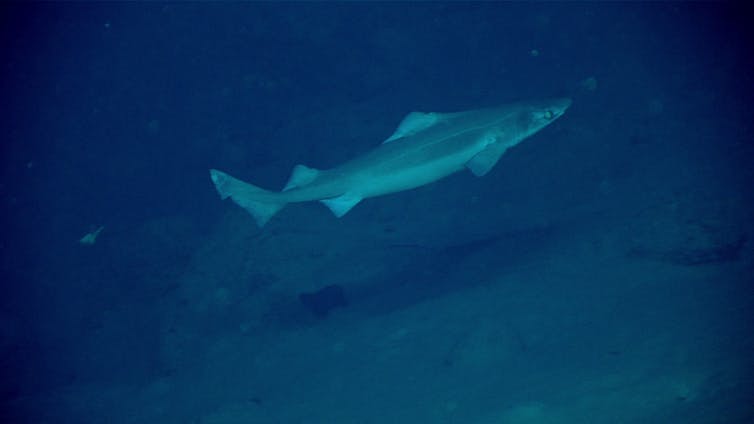
Targeted shark liver oil fisheries are boom-and-bust fisheries. They drive shark populations down and raise the extinction risk over short periods of time (less than 20 years). There is particular interest in shark liver oil for applications in cosmetics and human health products, including vaccine adjuvants.
This is despite a lack of evaluation of possible human health risks of using liver oil for medical purposes (deep-water sharks can bioaccumulate heavy metals and contaminants at concentrations at or above regulatory thresholds).
Need For Global Deep-Water Shark Action
There have been tremendous triumphs in shark conservation, including the regulation of the global trade in fins from threatened coastal and pelagic species. But deep-water sharks have been largely left out of conservation discussions.
The Convention on International Trade in Endangered Species of Wild Fauna and Flora has yet to see a listing proposal for a deep-water shark or ray.
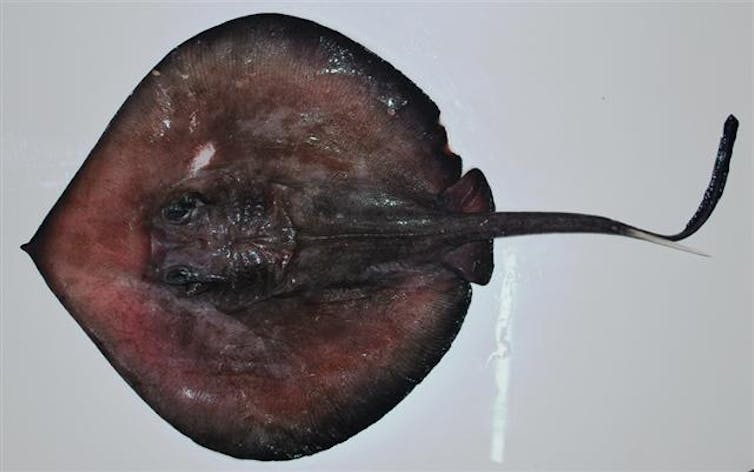
We call for trade and fishing regulations specific to deep-water sharks and rays to ensure legal, traceable and sustainable trade and to prevent their further endangerment.
There are presently limited ways of determining which species comprise internationally traded liver oil. It may be a byproduct of sustainable fisheries but the current lack of regulations could also be masking the trade of threatened species.
We also propose closures of areas important to deep-water sharks and rays to provide refuge from fishing and promote recovery and long-term survival. Nearly every deep-water shark is threatened by incidental capture.
Retention bans have been implemented in some regions as a mitigation strategy, including European waters managed under the International Council for the Exploration of the Sea. But they don’t prevent the mortality of prohibited species that are released after being brought to the surface from great depths.
We need efforts to prevent capture in the first place. There is now a global push to protect 30% of the ocean by 2030 through the Convention on Biological Diversity, which New Zealand has ratified.
Our work shows protecting 30% of the deep ocean (200-2000m) would provide around 80% of deep-water shark species with at least partial spatial protection across their range. If a worldwide prohibition of fishing below 800m were to be implemented, it would provide 30% vertical refuge for one third of threatened deep-water sharks and rays.
Even though the extinction risk for these species is much lower than that of their shallow-water relatives, their potential for recovery from overexploitation is much reduced because of their long lifespans and low fecundity. One study estimated it would take 63 years or more for the little gulper shark (Centrophorus uyato) to recover to just 20% of its original population size.
We know many shark populations around the world are in trouble. Threatened deep-water sharks have little chance of recovery without immediate action. Now is the time to implement effective conservation actions in the deep ocean to ensure half of the world’s sharks and rays have a refuge from the global extinction crisis.![]()
Brittany Finucci, Fisheries Scientist, National Institute of Water and Atmospheric Research and Cassandra Rigby, Adjunct Senior Research Fellow, James Cook University
This article is republished from The Conversation under a Creative Commons license. Read the original article.
The Southern Ocean upwelling is a mecca for whales and tuna that’s worth celebrating and protecting
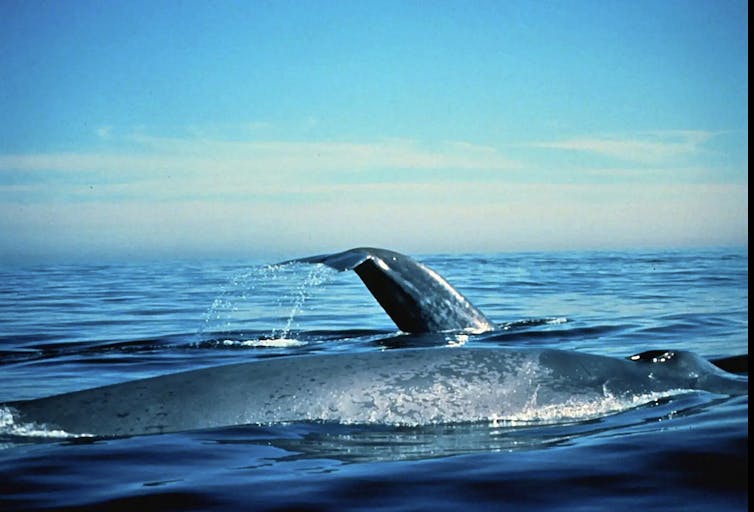
The Great Southern Australian Coastal Upwelling System is an upward current of water over vast distances along Australia’s southern coast. It brings nutrients from deeper waters to the surface. This nutrient-rich water supports a rich ecosystem that attracts iconic species like the southern bluefin tuna (Thunnus maccoyii) and blue whale (Balaenoptera musculus brevicauda).
The environmental importance of the upwelling is one reason the federal government this week declared a much-reduced zone for offshore wind turbines in the region. The zone covers one-fifth of the area originally proposed.
This year marks the 20th anniversary of a research publication that revealed the existence of the large seasonal upwelling system along Australia’s southern coastal shelves. Based on over 20 years of scientific study, we can now answer many critical questions.
How does this upwelling work? How can it be identified? Which marine species benefit from the upwelling? Does the changing climate affect the system?
Where Do The Nutrients Come From?
Sunlight does not reach far into the sea. Only the upper 50 metres of the water column receives enough light to support the microscopic phytoplankton – single-celled organisms that depend on photosynthesis. This is the process of using light energy to make a simple sugar, which phytoplankton and plants use as their food.
As well as light, the process requires a suite of nutrients including nitrogen and phosphorus.
Normally, the sunlight zone of the oceans is low in nitrogen. Waters deeper than 100m contain high levels of it. This deep zone of high nutrient levels is due to the presence of bacteria that decompose sinking particles of dead organic matter.
Upwelling returns nutrient-rich water to the sunlight zone where it fuels rapid phytoplankton growth. Phytoplankton production is the foundation of a productive marine food web. The phytoplankton provides food for zooplankton (tiny floating animals), small fish and, in turn, predators including larger fish, marine mammals and seabirds.
The annual migration patterns of species such as tuna and whales match the timing and location of upwelling events.
What Causes The Upwelling?
In summer, north-easterly coastal winds cause the upwelling. These winds force near-surface water offshore, which draws up deeper, nutrient-enriched water to replace it in the sunlight zone.
The summer winds also produce a swift coastal current, called an upwelling jet. It flows northward along Tasmania’s west coast and then turns westward along Australia’s southern shelves.
Satellites can detect the areas of colder water brought to the sea surface. Changes in the colour of surface water as a result of phytoplankton blooms can also be detected. This change is due to the presence of chlorophyll-a, the green pigment of phytoplankton.
From satellite data, we know the upwelling occurs along the coast of South Australia and western Victoria. It’s strongest along the southern headland of the Eyre Peninsula and shallower waters of the adjacent Lincoln Shelf, the south-west coast of Kangaroo Island, and the Bonney Coast. The Bonney upwelling, now specifically excluded from the new wind farm zone, was first described in the early 1980s.
Coastal upwelling driven by southerly winds also forms occasionally along Tasmania’s west coast.
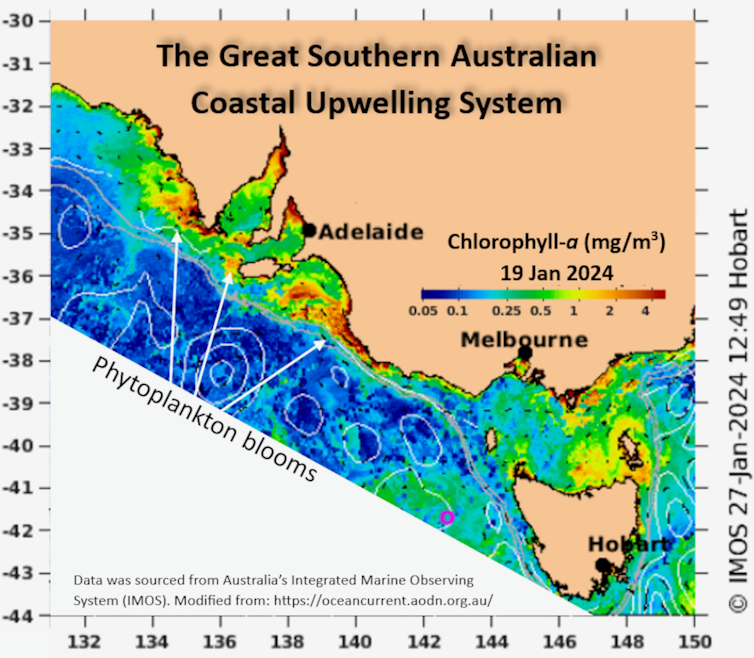
Coastal wind events favourable for upwelling occur regularly during summer. However, their timing and intensity is highly variable.
On average, most upwelling events along Australia’s southern shelves occur in February and March. In some years strong upwelling can begin as early as November.
Recent research suggests the overall upwelling intensity has not dramatically changed in the past 20 years. The findings indicate global climate changes of the past 20 years had little or no impact on the ecosystem functioning.
What Are The Links Between Upwelling, Tuna And Whales?
The Great Southern Australian Coastal Upwelling System features two keystone species – the ecosystem depends on them. They are the Australian sardine (Sardinops sagax) and the Australian krill (Nyctiphanes australis), a small, shrimp-like creature that’s common in the seas around Tasmania.
Sardines are the key diet of larger fish, including the southern bluefin tuna, and various marine mammals including the Australian sea lion (Neophoca cinerea). Phytoplankton and krill are the key food source for baleen whales. They include the blue whales that come to Australia’s southern shelves to feed during the upwelling season.
Unlike phytoplankton and many zooplankton species that live for only weeks to months, krill has a lifespan of several years. It does not reach maturity during a single upwelling season. It’s most likely the coastal upwelling jet transports swarms of mature krill from the waters west of Tasmania north-westward into the upwelling region.
So the whales seem to benefit from two distinct features of the upwelling: its phytoplankton production and the krill load imported by the upwelling jet.
Seasonal phytoplankton blooms along Australia’s southern shelves are much weaker than other large coastal upwelling systems such as the California current. Nonetheless, their timing and location appear to fit perfectly into the annual migration patterns of southern bluefin tuna and blue whales, creating a natural wonder in the southern hemisphere.![]()
Jochen Kaempf, Associate Professor of Natural Sciences (Oceanography), Flinders University
This article is republished from The Conversation under a Creative Commons license. Read the original article.
Yabby traps and discarded fishing tackle can kill platypuses - it’s time to clean up our act
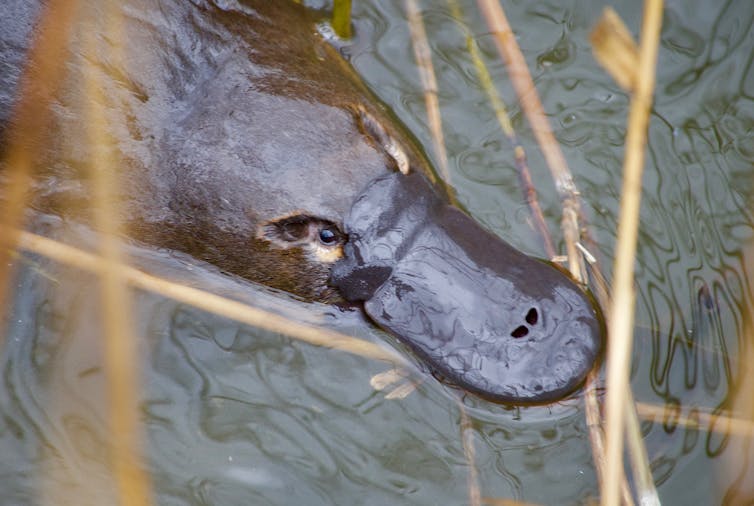
Recreational fishing is a popular pastime in Australia’s inland rivers and streams. Unfortunately in the process, many people are unwittingly killing platypuses.
The animals can become trapped in nets commonly used to catch yabbies such as “Opera House traps” (so-called because their shape resembles the sails of the Sydney Opera House). The enclosed structure stops platypuses swimming back to the surface to breathe, causing them to drown in minutes.
Enclosed traps are banned in most states, but they are still being used. They are sold online and can be shippped across Australia. During our field research, we frequently encounter these traps and clumps of discarded fishing line. We have also conducted research on the bodies of platypuses killed by these hazards.
It’s time for a national ban on these inhumane traps. And recreational fishing waste should be kept out of our waterways. We must save our platypuses, before it’s too late.
A Natural Wonder
The platypus is one of Australia’s most loved and iconic species. These semi-aquatic, air breathing monotremes (egg-laying mammals) can be naturally found in waterways of the east coast, Tasmania and Kangaroo Island.
But there are growing concerns for the species’ survival. Platypuses are becoming scarce and in some areas, completely disappearing from waterways.
The animals spend most of their time foraging in freshwater creeks and rivers. They have very poor eyesight underwater and use special sensors in their duck-shaped bill to locate prey. A trap full of live yabbies can attract platypuses, but this tempting feast may be their last meal.
Closing In On Enclosed Traps
Closed-top traps are baited then submerged in a river or stream for hours or a day, before being hauled out.
The traps funnel creatures into an enclosed space where they can’t escape. They are designed to catch freshwater crayfish (known as yabbies or marron). But they also inadvertently trap aquatic animals such as platypuses, freshwater turtles and the native water rat, rakali.
But there are wildlife-friendly alternatives. For example, some nets are open at the top while others have a hinged lid that can be pushed open by a larger animal, such as a platypus, as it tries to escape.
Opera House style, closed-top yabby traps are now banned in Tasmania, Victoria, the Australian Capital Territory, New South Wales and South Australia.
Queensland allows use west of the Dividing Range, where platypuses are not thought to exist, or on private property. Restrictions around the size of trap entrance holes were introduced in 2015.
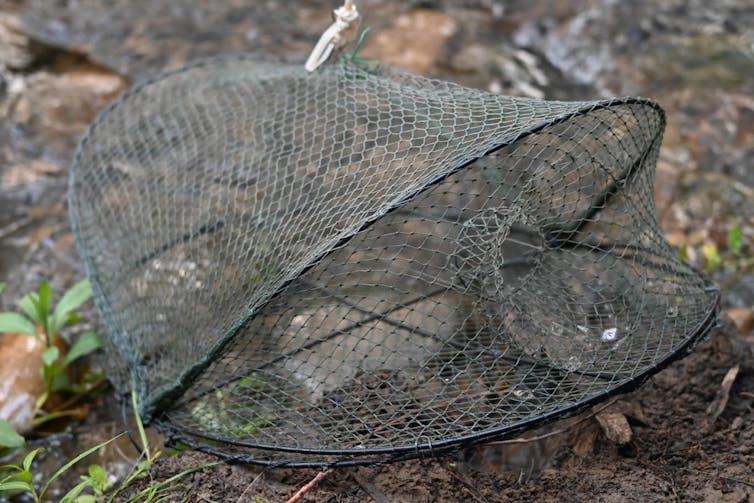
A Litany Of Platypus Deaths
The Australian Platypus Conservancy found 41% of reported platypus deaths from 1980 to 2009 were caused by drowning in enclosed nets.
Meanwhile platypuses have continued to drown in closed-top traps. In 2022, four reportedly died in one trap at Dorrigo on the mid-north coast of New South Wales. In 2021, a platypus died in Queensland’s Broken River and in 2018, one trap drowned seven in Victoria’s Werribee River.
Aside from deaths by closed-top traps, many platypuses become entangled in abandoned fishing line as they search for food along the bottom of waterways.
The animal’s tapered shape, duck-shaped bill and short webbed feet make it hard to free themselves. They are prone to getting wrapped in rings or loops of plastic, rubber or metal rubbish.
In 2021 a Victorian study of 54 cases of platypus entanglement found litter commonly encircled the neck (68%). Almost one in five were wrapped “from in front of a shoulder to behind the opposite foreleg” (22%). Others had plastic around their torso or jaw.
That study also found platypuses in greater Melbourne were up to eight times more likely to become tangled in litter than those in regional Victoria. That’s because urban areas tend to be more polluted.
Fishing line can cut through skin and muscle, causing a slow painful death. Entangled platypuses can also drown after they become caught on underwater debris.
We study how heavy metals and other emerging contaminants accumulate in platypuses. Together with the community, local and state governments and wildlife organisations such as Taronga Zoo, we collect dead platypuses to examine their organs and body tissues.
On a trip this month to regional NSW for water quality testing and sampling, we found multiple instances of tangled fishing line and an abandoned submerged Opera House trap.

Swapping Traps And Binning Trash
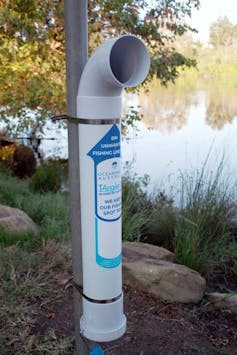
Between December 2018 and February 2019, when the Victorian Fisheries Authority invited people to swap their old closed top nets for a free “wildlife friendly” net, 20,000 traps were exchanged.
OzFish is currently running a Yabby Trap Round Up in NSW and SA. The Opera House traps are recycled and turned into useful fishing products.
Recreational fishers should also round up their used fishing line and hooks. The “TAngler bin” initiative encourages safe disposal. Since 2006, more than 350 TAngler bins have been installed at fishing hotspots in Victoria, NSW and Queensland, collecting more than ten tonnes of discarded fishing line.
A study in known platypus habitat on the Hawkesbury-Nepean River in Greater Sydney found more than 2.5km of fishing line was disposed of correctly in the bins in just three years.
Save Our Platypuses
Closed-top nets should be banned nationwide. This would ensure recreational fishers can no longer buy these traps and then use them in banned areas, as is happening now.
Net exchange programs should continue, in conjunction with a national awareness campaign, so the closed-top traps already sold are all handed in.
And both fishers and the wider community can take action by collecting discarded fishing line and nets.
Platypuses need all the help they can get. With our support, these beloved iconic animals can live on in Australian waterways. ![]()
Katherine Warwick, PhD Candidate, Western Sydney University; Ian A. Wright, Associate Professor in Environmental Science, Western Sydney University, and Michelle Ryan, Senior lecturer, Western Sydney University
This article is republished from The Conversation under a Creative Commons license. Read the original article.
Big businesses will this year have to report their environmental impacts – but this alone won’t drive change

This year, large businesses in Australia will likely have to begin reporting their environmental impacts, climate risks and climate opportunities.
The final draft of Australia’s new mandatory climate disclosure laws are due any day now, following consultation.
These laws are meant to increase transparency about how exposed companies are to risks from climate change, and will require companies to look into and share what impact their activities have on the environment. This, the government hopes, will accelerate change in the corporate sector.
But will it help lower emissions? I don’t think so. We don’t have a carbon tax, which means many companies have no financial incentive to actually lower their emissions. (The strengthened Safeguard Mechanism applies to about 220 big emitters, but they can simply buy offsets and avoid harder change.)
By themselves, climate disclosures will not trigger the change we need.

Why Are These Laws Being Proposed?
In June 2023, the newly formed International Sustainability Standards Board (ISSB) released a set of sustainability standards and climate disclosures.
These standards have influenced Australia’s draft laws.
In planning mandatory corporate disclosures on climate and environment, Australia is following similar efforts overseas. In 2022, the United Kingdom began to roll out mandatory reporting on climate risks and opportunities for the largest UK companies (those with more than 500 employees and A$970 million in turnover).
Once the Australian legislation comes into effect, it will require large companies and asset owners to publish their climate-related risks and opportunities.
In the draft legislation, companies would have to evaluate and report on their direct and indirect greenhouse gas emissions from sources they own or control and from sources such as purchased electricity.
From July this year, the laws would require disclosures from companies with 500 employees, $1 billion in assets or $500 million in revenue. Over time, this would expand to medium-sized companies. From July 2027, companies with 100 employees, $25 million in assets or $50 million in revenue would have to share this information.
Sustainability reports will be subject to external auditing and directors would be personally liable for the accuracy of the disclosures – with one major exception.
For many Australian companies, it’s already proving too hard to account for Scope 3 emissions – the greenhouse gas emissions upstream and downstream in a company’s operations, such as the emissions from gas burned after we export it.
As these emissions occur outside a company’s direct control, accounting for them is a complex task costing time and money. Only some companies have voluntarily started to report their Scope 3 emissions in anticipation of future regulatory change.
The draft legislation exempts companies from the need to report Scope 3 emissions for their first year of reporting and proposes limited liability for these disclosures for a fixed three-year period.
This means companies can simply come up with a best-guess estimate, rather than reporting their actual Scope 3 emissions, which can make up 65–95% of their overall emissions. In some sectors, such as the integrated oil and gas industry, Scope 3 emissions can comprise more than six times the sum of Scope 1 and 2 emissions. Woolworths’ Scope 3 emissions account for 94% of emissions.
What Are Disclosure Laws Meant To Do?
You can see why the government is introducing these laws. To nudge corporate Australia towards a greener future, it helps to know what impact your business has – and what risks it is exposed to. It will also be useful for investors.
But it will not drive rapid decarbonisation. Critics have pointed out that reporting and disclosure alone will not lead to a shift away from carbon-intensive business operations. Disclosures give the appearance of action rather than real action. If there are no stronger policies accompanying, disclosures act as window dressing for global financial markets.
Our existing policies do not require organisations to make genuine changes in terms of their emissions. Unless organisations abandon their reliance on fossil fuels and substantially decarbonise their operations, we are simply not going to get any change.
These laws also come with a cost. The regulatory burden and compliance costs for Australian companies will not be trivial, especially for companies which haven’t reported on climate or sustainability before.
We already have a shortage of trained reporting, auditing and assurance professionals able to do climate and environment work, following years of minimal action on climate change in Australia. To fix this will require substantial and rapid upskilling.
These costs should give us pause. It’s worth thinking through how much emphasis we place on disclosures to drive change versus policies that would actually drive change, such as mandating that large companies have to reduce their direct emissions 10% a year.
Australian companies can only benefit from these laws if they use the data unearthed by disclosure to rethink how they operate, invest and green their supply chains towards sustainability. This may mean investing in clean technology, shifting from polluting transport fleets to electric, or reconsidering how they produce their products.
And to do that, of course, companies will need to see supportive government policies.
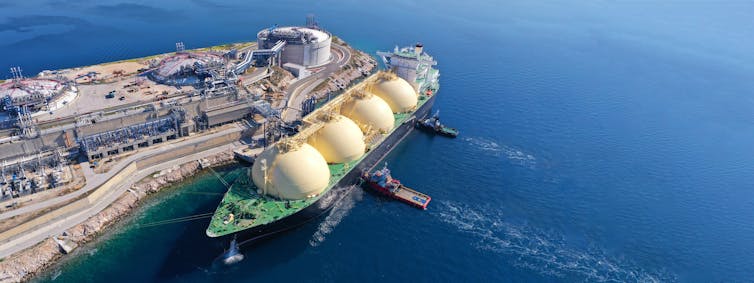
These Laws Can Be Useful – But Not Alone
Assuming the laws pass, big companies will begin assessing and reporting their emissions and environmental impact from July this year.
In doing so, Australia will align itself with international efforts for more transparency. Requiring companies to scrutinise and disclose their environmental impact will give corporate leaders the data needed to look for greener ways to run their business. But this assumes they have the interest and time to do so.
This isn’t a quick fix for climate change. To be worth the cost, Australia will need to link climate-related financial disclosures to clear policies designed to bring down emissions.
Disclosure policies produce disclosures. Emission reduction policies produce emission reductions. ![]()
Martina Linnenluecke, Professor of Environmental Finance at UTS Business School, University of Technology Sydney
This article is republished from The Conversation under a Creative Commons license. Read the original article.
In a dangerously warming world, we must confront the grim reality of Australia’s bushfire emissions
Robert Hortle, University of Tasmania and Lachlan Johnson, University of TasmaniaIn the four years since the Black Summer bushfires, Australia has become more focused on how best to prepare for, fight and recover from these traumatic events. But one issue has largely flown under the radar: how the emissions produced by bushfires are measured and reported.
Fires comprised 4.8% of total global emissions in 2021, producing about 1.76 billion tonnes of carbon dioxide (CO₂). This exceeds the emissions of almost all individual countries except the biggest emitters of China, the United States, India and Russia.
It’s crucial to accurately track the greenhouse gas emissions bushfires produce. However, the modelling and reporting of bushfire emissions is a complex, poorly understood area of climate science and policy.
The University of Tasmania recently brought together leading scientists and policymakers to discuss Australia’s measuring and reporting of bushfire emissions. The resulting report, just released, shows where Australia must improve as we face a fiery future.
Getting A Read On Bushfire Emissions
By the end of this century, the number of extreme fire events around the world is expected to increase by up to 50% a year as a direct result of human-caused climate change.
Emissions from bushfires fuels global warming – which in turn makes bushfires even more destructive. Estimating these emissions is a complicated and technical task, but it is vital to understanding Australia’s carbon footprint.
Australia reports on emissions from bushfires according to rules defined by the United Nations Framework Convention on Climate Change (UNFCCC), and as part of our responsibilities under the Paris Agreement.
Countries estimate bushfire emissions in different ways. Some rely on default data provided by the UNFCCC. In contrast, Australia’s modelling combines the area of burned land with highly specific local data on the types of fuel burned (such as leaves, bark and dead wood) and the amount of different types of gas these fuels emit. This makes it among the most sophisticated approaches in the world.
More Transparency Is Needed
Australia’s modelling may be sophisticated but it can also be confusing – even for those who follow climate policy closely. One reason is the complex way we differentiate between “natural” fires (those beyond human control) and “anthropogenic” or human-caused fires such as controlled fuel-reduction burns.
Emissions from natural fires are reported to the UNFCCC, but do not initially count towards Australia’s net emissions calculations. This is consistent with guidance from the Intergovernmental Panel on Climate Change.
However, we believe that to improve transparency and accountability, the federal government should work with the states and territories to provide a separate breakdown of natural and human-caused fire emissions. This data should be made publicly available to provide a clearer picture of bushfire emissions and the impact of climate change on large fires.
Where We Must Improve
As mentioned above, emissions from natural fires do not initially count towards Australia’s net calculations. Consistent with other countries, our modelling assumes that emissions will be offset after the fires because forest regrowth captures carbon from the atmosphere.
This approach is based on current scientific evidence. For example, within two years of the Black Summer fires, 80% of the burned area was almost fully recovered.
If monitoring of a fire site shows regrowth has not fully offset emissions after 15 years, the difference is retrospectively added to Australia’s net emissions for the year of the original fire.
But this approach may soon need to change. That’s because research sugests we cannot assume forests will recover quickly after bushfires. As bushfires become more frequent and intense, they are more likely to irrevocably change landscapes. Bushfires are also more likely to occur in areas that are not adapted to fire and recover poorly – such as Tasmania’s World Heritage-listed northwest.
This has major implications for Australia’s emissions accounting.
Another significant gap in our modelling is the contribution of soil carbon to bushfire emissions. Large amounts of carbon are present in organic material in soil.
Currently, international rules do not require soil carbon emissions from fire to be estimated. This is despite emerging research showing the release of soil carbon during bushfires in some landscapes, such as peatlands, is likely to create substantial emissions. Other research suggests that depleted soil carbon can slow the recovery of forests after fire.
There is currently insufficient evidence to include soil carbon emissions from bushfires in Australia’s estimates, or to model the effects of soil carbon changes on forest regrowth and carbon capture. More research is urgently needed.
Where To Now?
Australia’s approach to estimating bushfire emissions is credible and sophisticated. However, our modelling and reporting must be refined as technology improves and the climate changes.
Australia is a fire-prone continent. Our bushfire emissions will increase unless we significantly improve our fire preparedness and management. We must also rapidly reduce emissions from other sectors, to ensure our country is playing its part in the struggle to avoid catastrophic global warming.![]()
Robert Hortle, Research Fellow, Tasmanian Policy Exchange, University of Tasmania and Lachlan Johnson, Research fellow, University of Tasmania
This article is republished from The Conversation under a Creative Commons license. Read the original article.
Why move species to islands? Saving wildlife as the world changes means taking calculated risks
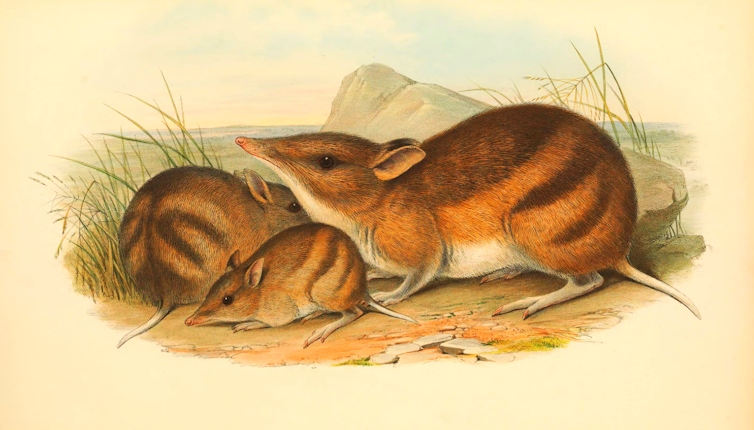
The eastern barred bandicoot was once found in abundance across the basalt plains of western Victoria. But habitat destruction and predation by introduced red foxes drove the species to the brink of extinction on the mainland.
Establishing populations in fenced reserves was critical in providing insurance against extinction. To further increase bandicoot numbers to provide long-term security against extinction, we needed more fox-free land.
A bold plan was hatched: move the species to where the predators weren’t. Introduce them to Victoria’s fox-free Phillip and French islands.
Six years later, the bandicoot made conservation history, as the first species in Australia to be reclassified from extinct in the wild to endangered.
Why don’t we translocate all endangered species to islands? The technique can be effective, but can come with unwanted consequences.
The Surprising Benefits Of Translocation
Eastern barred bandicoots are ecosystem engineers. As they dig for their dinner of worms, beetles, bulbs, fungi and other foods, their industrious work improves soil quality, and in turn, the health of vegetation.
So when we translocate threatened species, we can get a double win – a rapid increase in their populations and restoration of lost ecosystem functions.
Australia’s landscapes look very different than they did before European colonisation around 230 years ago.
Industrialised farming, introduced predators and habitat destruction and fragmentation are driving biodiversity decline and extinctions. As species die out, ecosystems lose the vital functions wildlife perform. Without them, ecosystems might not operate as well or even collapse – a little like a poorly serviced car engine.
We feel the loss most acutely when we lose keystone species on which many other species depend, such as oysters and bees. Restoring these functions can improve biodiversity and the sustainability of food production. For instance, encouraging owls to return to farmland can cut the use of damaging rodent poisons, as owls eat thousands of mice and rats yearly.
Before colonisation, industrious digging mammals and their soil excavations were extremely widespread. Regrettably, introduced foxes and cats have made short work of many of Australia’s diggers. Six of 29 digging species are now extinct, including the lesser bilby, pig-footed bandicoot and desert rat-kangaroo. Many others are endangered.
Could Translocation Save More Species?
Conservationists have successfully translocated species such as the western swamp tortoise, the Shark Bay mouse, and northern quolls.
New environments don’t necessarily need to be predator-free. The eastern barred bandicoot is thriving on Phillip and French Island, in the presence of feral and domestic cats. The key is there are no foxes.
Many islands are now being thought of as conservation arks, able to provide safe havens for several threatened species at once. Dirk Hartog Island, Western Australia’s largest, is now home to reintroduced western quolls, dibblers, mulgaras and other small mammals, as well as two translocated hare-wallaby species.
Why Is Translocation Not More Common?
The technique can work very well – but it can also backfire.
In the 1920s, conservationists undertook the first translocation in Australia by moving koalas to Phillip and French Island – the same Victorian islands now a refuge for bandicoots. While this protected koalas from hunting pressure, koala populations exploded, and the tree-dwelling marsupials ate themselves out of house and home in some areas.
In 2012, conservationists began introducing Tasmanian devils to Maria Island, just off Tasmania’s east coast. They wanted to conserve a healthy population free from the contagious facial tumour which has devastated their populations. On Maria Island, the devils became too successful, wiping out the island’s penguin and shearwater populations.
You can see translocations aren’t a silver bullet. We have to carefully consider the pros and cons of any such conservation intervention. Ecosystems are complex. It’s not easy to predict what will happen to an ecosystem if we introduce a species new to the area.
The decision to translocate a species is a value judgement – it prioritises one species over the broader ecosystem. Opponents of translocation question whether we are doing the right thing in valuing efforts to conserve a single species over the innate value of the existing ecosystem.
What’s The Best Approach In Future?
Translocation is not the end goal. Islands cannot support the vast array of threatened species in Australia.
The end goal is to establish and expand threatened species populations on the mainland in fenced reserves before eventually reintroducing them to the wild where they will encounter introduced predators.
Research is being done to explore how we can make this work, such as:
1) Predator-savvy wildlife: some native species may be able to adapt to living alongside introduced predators – with some help. For example, conservationists have exposed semi-captive bilbies to small numbers of feral cats with the aim of increasing their wariness and ultimately boosting their chances of survival. Results have been encouraging.
2) Building ecosystem resilience: we know more intact native ecosystems can reduce the chance of damage from invasive species . That means re-establishing native ecosystems could boost their resilience.
Moving a species from its home is a bold and risky decision. It’s critical local communities and First Nations groups are consulted and able to guide discussions and any eventual actions.
For their part, governments, land managers and conservationists must think more broadly about how we might best conserve species and ecosystems in a rapidly changing world. ![]()
Anthony Rendall, Lecturer in Conservation Biology, School of Life and Environmental Sciences, Deakin University; Amy Coetsee, Threatened Species Biologist, The University of Melbourne; Aviya Naccarella, PhD Candidate, Deakin University, and Euan Ritchie, Professor in Wildlife Ecology and Conservation, School of Life & Environmental Sciences, Deakin University
This article is republished from The Conversation under a Creative Commons license. Read the original article.
The National Electricity Market wasn’t made for a renewable energy future. Here’s how to fix it
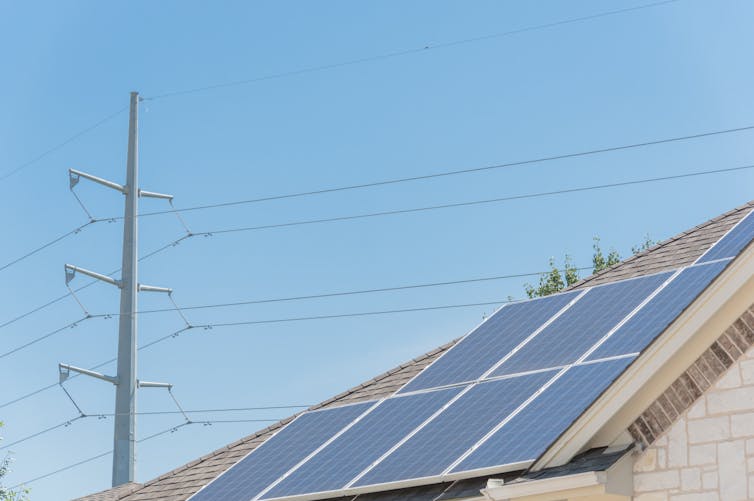
Rooftop solar is Australia’s cheapest source of electricity. The consumer can get electricity from rooftop solar at less than a fifth of the average cost per kwh of buying it from a retailer.
Unsurprisingly, rooftop solar output is growing fast. In 2022, one-in-three homes had solar panels. Total rooftop solar capacity exceeded 30 gigawatts, compared to the remaining 21GW of coal generation.
Rooftop solar photovoltaic (PV) systems will soon supply half of our electricity demand. At times of the day, they already supply close to 100% of electricity demand and in some regions can briefly meet all demand.
This means renewable energy is displacing the electricity traded through the wholesale market and supplied via the transmission system. The National Electricity Market (NEM) is the wholesale market where large generators and retailers buy and sell electricity to supply the eastern and south-eastern states. It was never designed to cope with large amounts of renewable energy feeding into the grid at large, medium and small scales.
The market’s design doesn’t allow for harnessing the full economic and technical potential of the millions of consumer-owned generators, known as distributed energy resources (DERs). Comprehensive market reforms are urgently needed to achieve an energy transition at least cost to energy users.
What Are The Challenges Of Reform?
The National Electricity Market has operated largely in its current form since the 1990s. It was designed for large fossil-fuelled power stations, but many of these are on the way out.
Millions of rooftop solar systems are now connected to the grid. The market needs to change to a system that can manage and co-ordinate these small renewable energy generators.
To minimise disruption, a reformed market has to be able to accommodate and value the electricity and power system services that these millions of distributed energy resources can provide. They offer flexibility and can help balance supply and demand, thus improving grid stability.
Between 2019 and 2023, the former Energy Security Board (ESB) and regulators were tasked with delivering a new market design for the clean energy transition. Reforms to better integrate variable renewable generation included:
the Wholesale Demand Response Mechanism to allow demand-side (or energy consumer) participation in the market.
The Energy Security Board also proposed a two-sided market to allow energy users to actively trade electricity. The design of the reform fell short, but the intent remains valid. This reform needs to be revisited.
The electricity market rules define what commodities are valued and traded, how they are to be traded and by whom. These rules are embedded in thousands of pages of legislation. Each change takes about two years to progress.
These incremental market and policy patches fall short of the systemic change needed for a clean energy future. The whole National Electricity Market and its processes must be redefined.
The current focus of attention is on the large scale. What is being overlooked is the potential of small-scale and local generation to supply electricity where it is needed. This oversight creates a risk of building too much transmission infrastructure at great cost.
The opportunity of energy market reform is that the millions of small, privately owned, behind-the-meter generators could economically provide a big share of Australia’s future electricity and power system services.

Government Must Lead The Transformation
The clean energy transition is a national priority. Change on this scale requires governments to work together to deliver economic productivity, affordable energy and climate action.
A clear set of principles is needed to guide these changes. The principles from the National Energy Transformation Partnership agreement between federal, state and territory governments are a good place to start. It recognises consumers’ needs as central to the transformation, and that a strong economy depends on affordable, clean and secure energy sources.
The agreement also recognises the role electricity networks and demand-side participation will play in the energy transition. The demand side includes all the small, behind-the-meter, grid-connected, rooftop solar systems and interruptible uses of electricity such as hot-water systems.
Reforming the electricity market is complex work. It requires an in-depth knowledge of governance and regulatory frameworks, commercial realities and consumer needs.
Putting energy users at the heart of these complex reforms requires a holistic systems thinking approach to policy and regulatory design. Such an approach takes into account how all parts of a complex system interact.
With the consumer having such a key role, the focus, planning and investment in these smaller energy sources must be on par with that given to the large generators.
Renewable Energy Zones – areas with the greatest potential to develop renewable energy projects – have shown that, with the right policy settings, billions of dollars of investment can be mobilised. The same level of focus on policy settings and market reforms is needed at the small scale of “Community Energy Zones”.
Each zone must be able to accommodate the unique characteristics of its energy users. It must create an investment environment that supports a local ecosystem of skills, trades and community benefit, ultimately leading to a zero-emission community. It must also support technological and business innovation and allow distribution networks to transition to a smart grid at low risk and low cost.
Learning from successful examples overseas such as smart local energy systems (UK) and Viable Cities (Sweden) will be crucial.![]()
Vikki McLeod, PhD Graduate, Centre for Clean Energy Technologies and Practices, Queensland University of Technology and Marcus Foth, Professor of Urban Informatics, Queensland University of Technology
This article is republished from The Conversation under a Creative Commons license. Read the original article.
Lumpy skin disease is a threat to Australia and could decimate our cattle industries – we need to know how it could enter and spread

Australian authorities are on high alert amid the spread of lumpy skin disease in cattle and buffalo across South-East Asia. While Australia remains free of the disease, the virus is likely to breach our borders at some stage.
Detection of the disease in Australia’s livestock industries would lead to restrictions on cattle, meat and dairy exports, with serious consequences for the economy.
The federal government has a plan to detect and respond to an outbreak. But we need to go one better – to predict where the disease is likely to appear and how it might spread.
Our team is developing a model we hope will provide this vital information. It will help Australia prepare and respond not just to the current threat, but to any future biosecurity breach.
What Is Lumpy Skin Disease?
Lumpy skin disease is a viral disease that affects cattle and buffalo, not humans. The incubation period is up to 28 days.
First reported in Zambia in 1929, the disease has spread across Africa, the Middle East, Eastern Europe and Asia. It reached Indonesia in 2022.
Early symptoms include fever and increased tear production. Lumps then appear on the skin and can cover the entire body, gradually hardening as the disease develops. Sometimes the lumps slough off, leaving holes on the skin that are susceptible to infections.
Typically only 1-5% of cattle die from the disease, but those that recover may not return to full health.
Milk production is reduced in cows. Meat yield from infected cattle is likely to be reduced, although it does not contain lumps and is safe to eat. Temporary or permanent infertility in both cows and bulls can also develop during the first month of infection.
The virus is mainly spread by biting insects such as mosquitoes, stable flies and ticks. Higher temperature and increased rainfall can increase insect populations and activity, and have triggered outbreaks of disease overseas.
The disease can also be transmitted by close contact between cattle, such as exposure to body fluids.
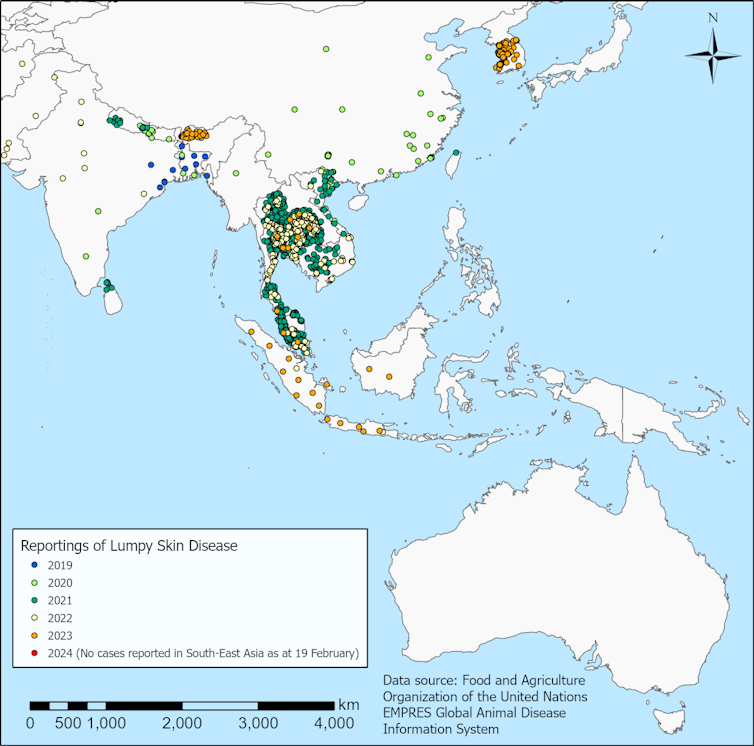
A Testing Time With Indonesia And Malaysia
In July last year, Indonesian authorities claimed 13 cows from Australia had tested positive days after arrival. At the time, Australian authorities demonstrated that the nation was free of the disease.
Nonetheless, trade between Indonesia and four of Australia’s cattle export holding yards was suspended immediately. Then Malaysia went further and stopped accepting any Australian live cattle and buffalo.
Malaysia and Indonesia each lifted their restrictions in early September, after more than 1,000 cattle were tested across Western Australia, Queensland and the Northern Territory. The Australian government also agreed to boost surveillance and biosecurity measures, including testing on farms and disinfecting departing export vessels.
Since the lifting of restrictions, the Indonesian government has reportedly rejected Australian cattle with skin blemishes – in some cases, this comprised up to 30% of cattle in a shipment.
How Could Lumpy Skin Disease Enter Australia?
The Australian government has introduced strict biosecurity measures at international ports to minimise the risk of infected animals entering the country. These include disinfection and disinsection (spraying to remove insects) of vessels and cargo.
However, there’s a high risk of infected insects entering Australia through international ports or by travelling across the sea to northern Australia. Some infected flying insects may be able to cover long distances, aided by strong winds.
Another possible mode of entry for infected insects is through illegal fishers landing on the Australian coast.
What Can Be Done To Prevent The Spread Of Lumpy Skin Disease?
In countries where lumpy skin disease is common, live vaccines have been used to control the disease. However, this is not practical in disease-free countries such as Australia, because vaccinated animals cannot be distinguished from infected animals. This means Australia could not be confirmed free of disease, leading to international trade restrictions.
The Australian government secured a supply of lumpy skin disease vaccines in October. These are being securely stored overseas in case of an outbreak. The vaccines will also be available to neighbouring Papua New Guinea and Timor-Leste.
Preventing the spread of lumpy skin disease requires early detection of the disease, isolation of potentially infected animals and restrictions around their movement. Once initial diagnosis is confirmed, culling of infected animals and insect control would likely follow.
What Can Be Done To Prepare Australia?
Australia has a veterinary emergency response plan to enact if the disease enters the country. The federal government has also boosted surveillance and begun offering training for veterinarians, industry and government staff on how to prevent and control the spread of the disease.
However, innovative models are needed to assess the likely introduction and spread of the disease in Australia. Our team is developing a framework to carry out such modelling. Our model will include data describing the current status of reports of the disease outside of Australia, Australia’s landscape and climate, distribution and movement of cattle, and local insect populations.
These models will produce maps that can be used to identify areas in Australia more suitable to receiving the disease, such as areas with favourable environmental conditions for the survival of imported infected insects. These maps will inform decisions around surveillance and response plans, and help farmers prepare for a potential outbreak of the disease.
Maintaining a high level of preparedness and awareness of the disease among cattle producers, farmers, veterinarians and other relevant individuals is paramount if we are to maintain our disease-free status as an international exporter. ![]()
Kei Owada, Postdoctoral Research Fellow, The University of Queensland; Ben Hayes, Director, Centre of Animal Science, University of Queensland, The University of Queensland; Ricardo J. Soares Magalhaes, Professor, The University of Queensland, and Timothy J. Mahony, Professor, The University of Queensland
This article is republished from The Conversation under a Creative Commons license. Read the original article.
The frantic pace of modern life is damaging our sense of time, but nature can help us heal – new study

“How did it get so late so soon?” ― Dr. Seuss
In an increasingly competitive world, time is of the essence. Notions of productivity and timeliness have accelerated contemporary lifestyles to a dizzying, sometimes overwhelming pace, and our dependence on technology is doing little to help. As the clock grows to dominate the tempo of life, time itself seems to be increasingly fleeting. This is particularly true in large cities, where hours, days, and even weeks can sometimes seem to fly by in an instant.
Indeed, an increasing number of people report constantly feeling short of time. Such feelings of “time scarcity” emerge from how time is both used and perceived by people. Long working hours inevitably limit the time that people have available for other activities, but leading fast-paced lifestyles while packed into noisy, dynamic and crowded urban environments is mentally exhausting, and this can also influence how we perceive time.
In a recent publication, I propose that nature experiences offer a potential solution to the increasingly widespread feelings of time scarcity caused by contemporary urban lifestyles. This emerges from the unique nature of human time perception, which is highly subjective, and moulded by the experiences and environments in which we immerse ourselves.
Human Sense Of Time
Human time perception — our sense of time — is made up of three key dimensions. One of these is temporal succession, meaning the way we perceive the order and overlap of different events. For instance, pressing a light switch and the light turning on may seem like simultaneous events, but we have the capacity to perceive the order in which they happen, and this helps us to make sense of the world around us.
Another dimension is temporal duration, or how we perceive and estimate the duration of an event. An afternoon spent in the tax office, for example, can seem to last forever, while the same amount of time spent in the company of friends can seem short and swift. Popular expressions such as “time stood still” or “time flies when you’re having fun” reflect our nuanced perception of temporal duration.
The third dimension is called temporal perspective, and it refers to the way we regard the past, present and future. Humans have a unique capacity to mentally “time travel” and focus on representations of the past, present and future. Most people have a natural tendency towards certain perspectives, either dwelling on the past or focusing on the future, but maintaining a balanced and dynamic time perspective is a sign of psychological wellbeing.
Together, these dimensions help humans make sense of time. However, the way we perceive them can be profoundly influenced by our own characteristics, what goes on around us, and what we do during a given period of time. Our perception of time changes hugely when, for example, work captures our attention, when we are stuck in traffic, or when we find ourselves in the dentist’s chair undergoing a painful procedure.
In contrast, nature experiences can be mentally, physically and emotionally restorative, and this is reflected in our perception of time.
How Nature Experiences Help Regulate Human Time Perception
Evidence from psychological experiments suggests that there are at least two ways natural surroundings can have a positive impact on human time perception.
One of these is expanding our perception of temporal duration. For example, one study reports that when people are inquired how long they have been walking in natural or urban settings, they tend to overestimate the time spent strolling in nature, but not in the city. In other words, time feels longer when we are immersed in natural settings in comparison to urban environments.
The other way nature experiences can influence our time perception is by promoting a shift in perspective. In one experiment, participants spent a short period of silence either indoors or outdoors, and were later asked how this experience influenced their temporal orientation towards the past, present and future. People who experienced the natural setting reported feeling more focused on the present, and less on the past.
Other studies have provided similar evidence suggesting nature experiences can help us shift our perspective on time, and induce a more positive outlook of the present moment.
While there is plenty of evidence that nature experiences have various physical and mental benefits, the idea that such experiences can help people uplift their relationship with time is new, and provides a unique perspective on the importance of nature for human well-being.
Further enhancing our understanding of how nature benefits human sense of time can help us design cities and other urban environments in healthier and more sustainable ways.![]()
Ricardo Correia, Assistant professor, University of Turku
This article is republished from The Conversation under a Creative Commons license. Read the original article.
Australian homes are getting bigger and bigger, and it’s wiping out gains in energy efficiency
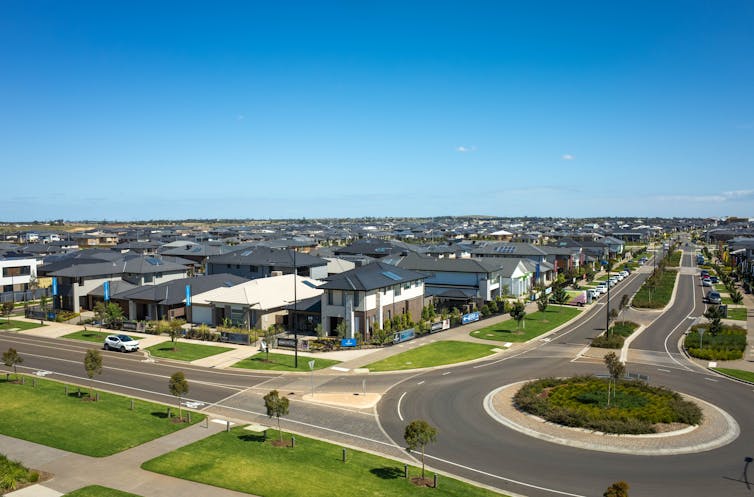
New Australian homes are being designed bigger and so require more energy for heating and cooling, wiping out potential gains in energy efficiency, according to our new research. The increasing energy demand is inconsistent with global efforts to tackle climate change and suggests Australia’s housing energy policy requires a radical rethink.
For more than 20 years, Australia’s building energy regulations have focused on energy efficiency. This reflects policy trends around the world.
In building regulations, energy efficiency is measured as the energy required to heat or cool one square metre of floorspace. Energy efficiency can be improved with features such as good orientation, insulation and double-glazing on windows. Homes designed to a higher energy efficiency standard do indeed require less energy for heating and cooling.
But what happens if we build a bigger house, or more houses: does energy efficiency policy still encourage less energy use in homes? Our research shows in Australia, the answer is no. A policy focus on energy efficiency has not led to falls in the predicted energy requirements for heating and cooling – either for individual homes or the new home sector as a whole.

Increasing Floor Areas
Around the world, apartment living is becoming more common. But detached homes remain the dominant housing type in many developed nations, including Australia, the United States and Canada.
House size differs markedly around the world, ranging from 9m² per person in India, to about 84m² per person in Australia. Globally, floor area per person is increasing.
Our study set out to examine the significance of this increase when it comes to home heating and cooling energy requirements in Australia.

What We Found
Our study involved more than 580,000 new homes in Australia designed between 2018 and 2022.
First, we looked at official dwelling approval data. We then examined certificates issued under the Nationwide House Energy Rating Scheme or NatHERS. This gave us the thermal performance star-ratings of the new homes, their energy efficiency for heating and cooling and their conditioned floor areas – that is, floor areas typically heated and cooled, excluding spaces such as laundries and garages.
From this, we calculated the predicted energy each home would require each year for heating and cooling.
We found a home designed in 2022 had a 7.6% larger conditioned floor area than a home designed in 2018. And a home designed in 2022 was predicted to require 10% more energy for heating and cooling than a home designed four years earlier.
This differed between jurisdictions. For example, predicted energy requirements for a new home in Western Australia fell by 11% over the period, while in Queensland and the Australian Capital Territory it increased by 17%.
Collectively, we found the predicted energy requirement for heating and cooling of all new homes in Australia was 5.6% more in 2022 than in 2018. This figure ranged from a fall of 21% in the Northern Territory to an increase of 34% in South Australia.
These increases occurred despite 97.5% of new homes meeting the state-based minimum energy efficiency regulations.
Understanding The Star-Rating System
Between 2018 and 2022, new homes had to be designed to a minimum 6-star energy rating under the NatHERs scheme. However, the policy is implemented by state-based regulations, which in some jurisdictions allows homes to be designed below 6-stars.
In the study period, 18% of new homes in Australia were designed to a 5-5.9 star rating, as permitted within the jurisdictions of Queensland, the Northern Territory and New South Wales. In all other states and territories, the majority of new homes were designed at 6-star or above.
Nationally, just 11% of new homes were designed at a higher standard of 7-10 stars. This ranged from 35% in the Australian Capital Territory to just 5% of new homes in Victoria.
Improvements to Australia’s housing energy efficiency policy came into effect in 2023. However these do not directly address the impact of floor area on heating and cooling energy requirements, and state-based regulations remain inconsistent.
Aussie Homes Are Getting Bigger
Our analysis showed new Australian homes continue to get bigger. New homes in Victoria and NSW had the largest conditioned floor areas, while Tasmania had the smallest.
New homes with lower a star-rating tended to be bigger: the average 5-star home in NSW had more than double the conditioned floor area of the average 7-star home in Tasmania.
Larger homes also inherently require more materials to build than smaller homes – and these materials require energy to produce. However this concept, known as embodied energy, was beyond the scope of our study.
Time For A Rethink
Our research showed at a household, state and national scale, the emission reduction benefits of improving a home’s energy efficiency may be undermined if policy does not consider floor area.
Demand for new housing in Australia will continue to rise as the population grows. So it’s even more important to ensure we get the settings right on home energy policy. Such an overhaul will be complex, involving building regulations, urban planning and social policies.
Renewable energy can significantly reduce greenhouse gas emissions from energy used by new homes. However, to make our net-zero goals feasible, achieving reductions in the energy required by each home is a crucial first step.
Work is also needed on how to encourage people to build smaller homes – a home sufficient for their needs, but no larger. Unless Australia re-examines the scale of its new homes, energy efficiency policy will fail to deliver genuine reductions in energy use.![]()
Kate Wingrove, PhD Candidate at the Sustainable Buildings Research Centre, University of Wollongong and Emma Heffernan, Associate Professor in Architecture, University of Sydney
This article is republished from The Conversation under a Creative Commons license. Read the original article.
Ever heard of the Maritime Continent? It’s not far from Australia – and channels heat around the world

Africa, Asia, Australia, Antarctica, North and South America, Europe – and the Maritime Continent.
Never heard of the last one? That’s because it’s not a continent made of land. In fact, it’s the largest warm tropical sea in the world, lapping against the shores of Indonesia, Malaysia, Papua New Guinea, the Philippines and smaller countries.
Why call it a continent? The name comes from the way the seas and land in this region interact. This single region is the main heat engine pushing heat around the world. The Maritime Continent is home to large expanses of warm, shallow seas bigger than Australia. Known as the tropical warm pool, these seas – the warmest on Earth – sustain warm sea temperatures and act as a engine for the Earth’s climate system.
As the world heats up under climate change, more heat pours into the seas. That means the Maritime Continent’s warm pool is growing. It’s roughly doubled from 22 million (1900-1980) to 40 million square kilometres (1981-2018).
Why Is This Area Special?
Start with the sun. The midday sun is mostly directly overhead in the tropics. Incoming radiation from the sun is at its peak along the equator, which bisects Indonesia. In this region, the seas are relatively shallow – the Java Sea, for instance, averages a depth of just 46 metres. Sunlight can penetrate to the seabed and so shallow water depths allow for more efficient heating of the water. As a result, the surface temperatures of this enormous warm pool of water are over 28°C.
Then there’s the wind. The prevailing winds here are the southeasterly trade winds, which blow along the surface of the Pacific near the equator. As they blow, they push the water below, pooling warm water in the western Pacific and around the islands of the Maritime Continent. These waters are usually the warmest oceans in the world.
Heat is energy, and energy makes things happen. Some of the heat leaves the seas and enters the atmosphere in a process known as convection. As the Earth rotates, the rising hot air spins away from the equator towards the poles. In this way, it spreads heat around the planet. The heat also drives evaporation, leading to high humidity rates and making the region climatically unstable. Intense storms driven by convection – rising hot air from the seas – can form at any time of the year.
Land heats and cools faster than water. As the land surface heats up, it can drive the development of convective storms on a near daily basis in some places. Other large storms can form as warm, moist air is blown over terrain and pushed upwards when it hits mountains.
This potent combination of heat, moisture and wind act to transfer huge amounts of heat to the upper reaches of the atmosphere, which then spreads around the world.
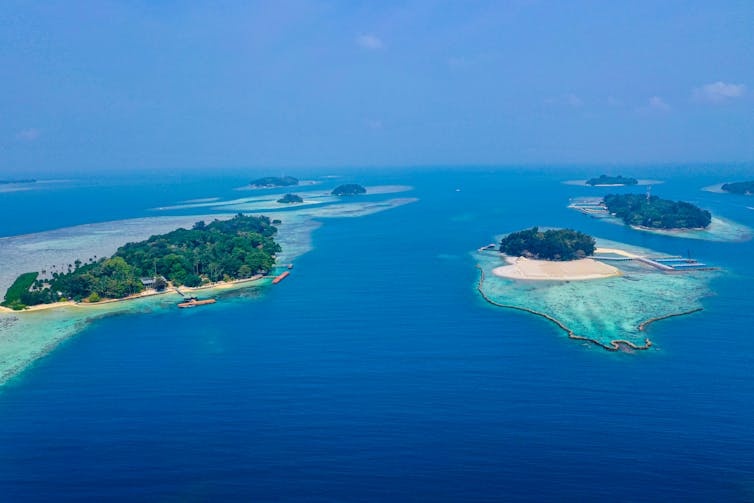
Keeping A Lid On It
You might not know it, but the atmosphere has a lid of sorts. You and I spend our lives in the troposphere, the lowest part of the atmosphere where ground and air meet. Here, the temperature generally falls as you get higher, which is why mountains are colder. In the stratosphere, by contrast, the air usually gets warmer with height.
Between the troposphere and the stratosphere lies the tropopause. This “lid” acts to keep most clouds and rain closer to Earth.
In Melbourne, the tropopause is about 11km above the city. But the warm, expanding atmosphere of the Maritime Continent pushes the tropopause as high as 18km above the surface.
This means there’s more space for heated and unstable air to rise and give birth to huge and seriously energetic cumulonimbus stormclouds. From here, heat is diverted towards the poles in global air circulation currents within the troposphere.
But when you’re at sea level in the Maritime Continent, you can have a totally different experience. Because so much of the heat rises, low atmospheric pressure develops and the equatorial winds at the surface can be very calm. In the age of sail, sailors called these conditions “the doldrums”.
Australia’s Bureau of Meteorology pays close attention to the Maritime Continent, because it has great influence over our weather – and not just for the tropical north.
When sea surface temperatures change up here, we know changes are coming to Australia’s weather patterns. Like India, northern Australia is monsoonal. Little rain falls during the dry season, April to October. When the wind patterns change in tropical Australia and freshening westerlies converge with the trade winds very late in the year, the monsoon arrives, bringing torrential rain.
It’s not just the north – temperature changes in the tropical warm pool can influence atmospheric pressure systems and drive changes in weather patterns in southern Australia too.
What Does The Future Hold?
The Maritime Continent is a weather engine, concentrating heat in warm seas and spreading it around the world.
In recent months, sea surface temperatures around the world are higher than ever recorded, and getting higher still. What will happen to it as more trapped heat pours into the oceans?
Certainly, the warm pool of water unpinning the Maritime Continent will keep expanding, as it has for decades. What that means for us isn’t as clear.
We don’t know yet whether a bigger tropical warm pool will allow more tropical cyclones to develop, or whether it will change how intense the monsoon will be.
Some research suggests higher sea temperatures can actually dampen down the formation of clouds from convection, which could mean regional droughts for countries of the Maritime Continent.
To help find out, I helped other researchers operate an instrument-packed aircraft which flew many measurement missions from Cairns earlier this year, including heading for the seas of the Maritime Continent. We measured concentrations of atmospheric molecules. The data we gathered will, we hope, help weather modellers better gauge what hotter tropical seas mean for the world.
This uncertainty means the Maritime Continent is worth watching. ![]()
Michael Hewson, Senior Lecturer Geography, CQUniversity Australia
This article is republished from The Conversation under a Creative Commons license. Read the original article.
Frozen in time: old paintings and new photographs reveal some NZ glaciers may soon be extinct
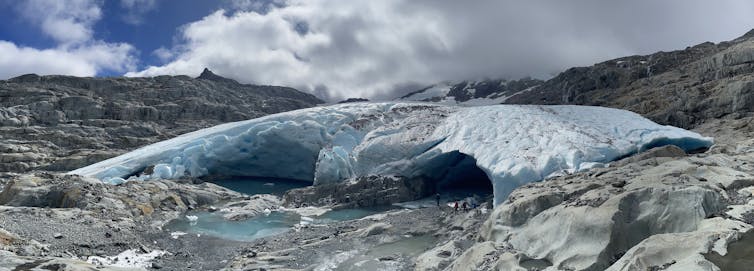
As the austral summer draws to a close, we are preparing to fly over the Southern Alps to survey glaciers. This annual flight supports the longest scientific study of Aotearoa New Zealand’s icescapes – and it shows that all of our glaciers have retreated since 1978.
This year’s survey comes on the heels of the warmest year on record globally and the second warmest for New Zealand, which produced extreme weather events and impacts that still cut deep for many local communities.
Despite strong El Niño conditions in the Pacific this season, which typically boost ice volume, we expect the recent heat grilling the glaciers will have had a grim effect.
The 46-year record of end-of-summer glacier images is incredibly valuable because it contains irrefutable visual evidence of climate change. We can see how glaciers are changing from year to year, with extremely hot years such as 2023 standing out clearly.
But our insights aren’t limited to images of glaciers taken from light aircraft. We can also learn from historic paintings of New Zealand’s mountain landscapes.
Portraits Of Past Climate
Old paintings with glaciers are common for the European Alps, where many artists lived and visited. But similar offerings are relatively rare for our part of the world.
What’s remarkable for New Zealand is that some of these works of art were produced without the artist ever seeing the glaciers.
We recently scrutinised the artistic vistas painted by John Gully to see if they were true to the real landscapes. Gully based his works on field sketches by Julius Haast, one of the first scientists to formerly recognise widespread glaciation in New Zealand.
Gully’s paintings show features that can be linked to glacial landforms we can see today, including moraines (rocks deposited by a glacier, typically at its edges), outwash fans (sediment deposited by braided rivers fed by a melting glacier) and trimlines (lines that mark a glacier’s earlier, higher position in a valley).
Many of those features in the paintings have ice in direct contact with them, showing how accurately field scientists and artists depicted glaciers at the time.
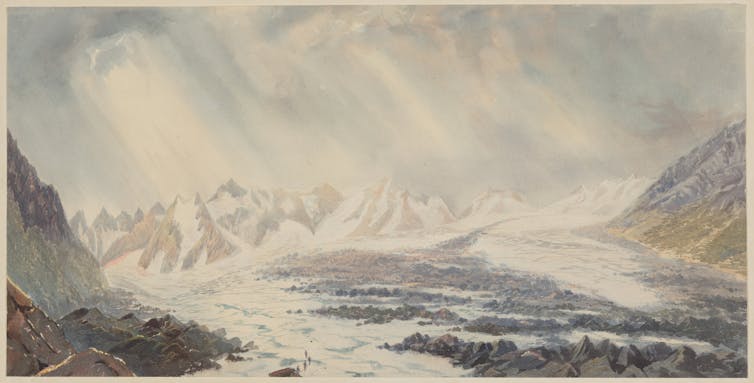
Gully’s paintings were intended to convey the dramatic scale of a mysterious land located far away from industrialised 19th-century society. Serendipitously, for contemporary scientists, comparing these artworks with current photos vividly shows the magnitude of ice loss that has occurred since the mid-1800s.
The perspective we get from Gully’s paintings concurs with studies that place the timing of ice retreat as being already underway in the mid-1800s. Prior to this time, known commonly as the Little Ice Age, New Zealand experienced cooler temperatures between about 1450 and 1850.
Modelling ice volume loss using these Little Ice Age landforms provides a benchmark. It illustrates that recent changes have occurred in a geological instant and that the peak summer flows from glaciers that helped create the braided river systems so typical of the South Island landscape are in the past.
Accelerating Pace Of Glacier Retreat
Recent glacier changes are occurring ever more quickly. The long-term photographic record from the Southern Alps shows an acceleration of the pace at which snowlines rise due to climate warming.
For a glacier to exist, average summer temperatures must be cool enough for the summer snowline to remain below mountain tops so ice can accumulate. We now observe that ice is disappearing from mountains which held small amounts during the late 1970s. Glaciers there are going extinct.
Combining long-term snowline observations with direct field measurements of glacier mass balance and 3D models of ice volume change gives a good synopsis of how things have changed and a sense of things to come.
We estimate at least 13 trillion litres of water (in the form of ice) has been lost from the Southern Alps since 1978. This is equivalent to the basic water needs for all New Zealanders during that time.
The regions around the central Southern Alps that hold many small glaciers are experiencing accelerated ice loss. Some areas, like Southland and Otago, have small glaciers that are rapidly approaching an extinction horizon. And once they pass it, we are not likely to see them again.
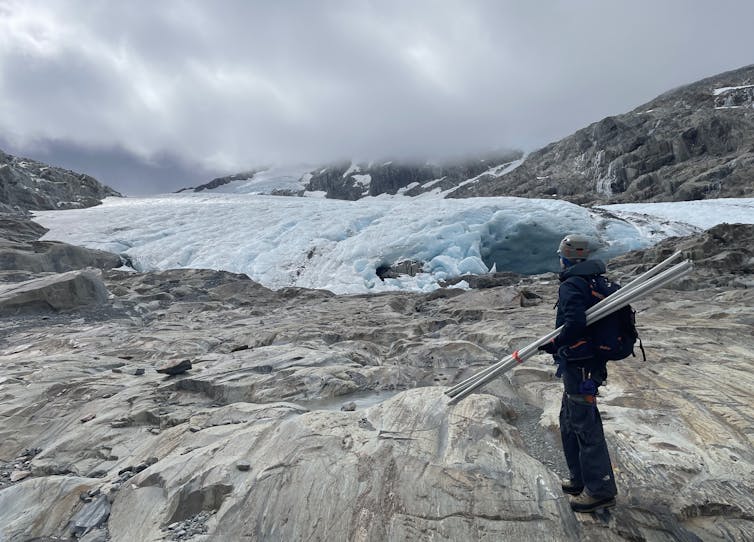
The central North Island also hosts a number of small glaciers on Mt. Ruapehu that feed into the headwaters of the Waikato and Whanganui rivers. Glaciers there were originally mapped in the mid-20th century, and again in 1978, 1988 and 2016. A recent photographic capture of Mt Ruapehu reflects a dire situation, indicating glaciers are fast approaching extinction.
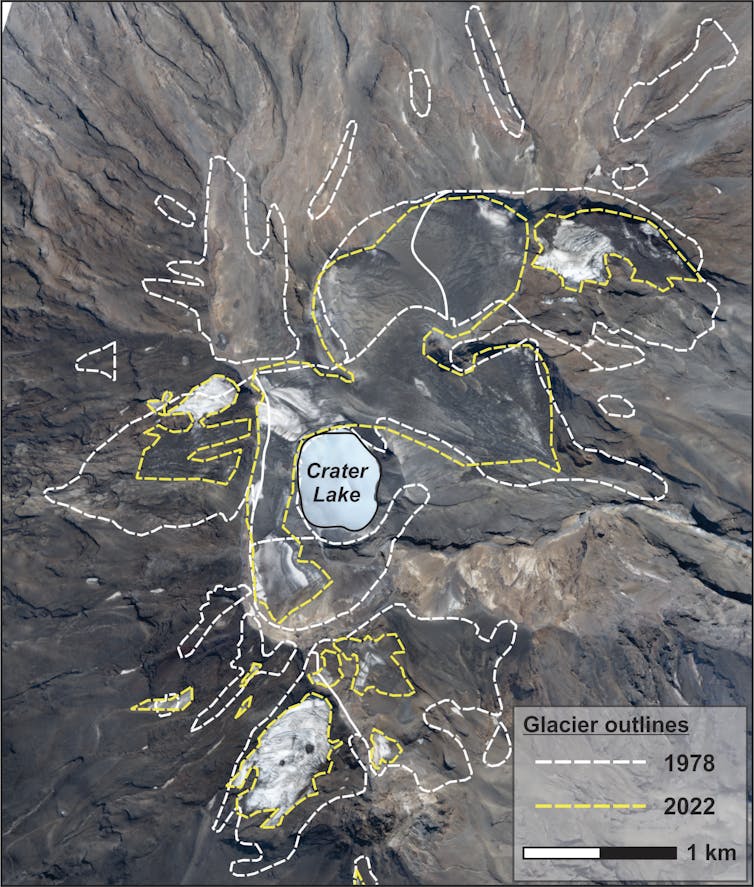
Environments And Ethics
New Zealand’s diminishing glaciers and loss of ice across Earth are largely carrying on unabated. These changes are primarily caused by rising temperatures driven by human activities that produce greenhouse gas emissions.
The global increase in atmospheric carbon dioxide continues undiminished. This needs to change soon and rapidly to protect many of our glaciers.
We face particularly serious ethical questions with respect to Mt Ruapehu’s glaciers. They help sustain the Whanganui River Te Awa Tupua, which has been granted the rights of a living entity. The glaciers’ ongoing retreat – and possible extinction – highlights our collective responsibilities for doing simultaneous harm to the environment and people.
The authors acknowledge Rebekah Parsons-King at NIWA for her work on the Glacier Extinction Horizons video. We also thank Brian Anderson for his long-term leadership on the Brewster Glacier snowstakes programme, and Pascal Sirguey for his work calculating mass balance for Brewster Glacier. ![]()
Andrew Lorrey, Principal Scientist & Programme Leader of Southern Hemisphere Climates and Environments, National Institute of Water and Atmospheric Research; George Hook, Research Associate (in process), Canterbury Museum; Lauren Vargo, Research Fellow, Antarctic Research Centre, Te Herenga Waka — Victoria University of Wellington, and Shaun Eaves, Senior Lecturer in Physical Geography, Te Herenga Waka — Victoria University of Wellington
This article is republished from The Conversation under a Creative Commons license. Read the original article.
Five hotspots where floating plastic litter poses the greatest risk to North Atlantic marine life – new study
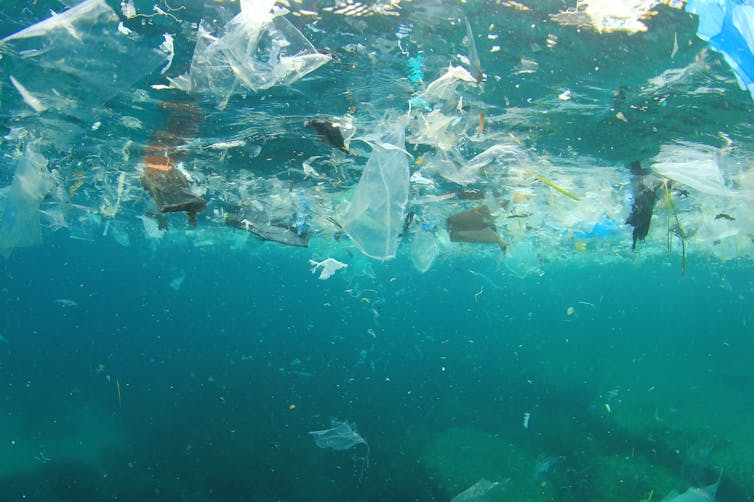
Plastic has been found in every single part of the ocean, from the surface to the seafloor and from the tropics to the poles. Land-based sources of plastic account for the majority of this pollution, with plastic bags, bottles, wrappers, food containers and cutlery among the most common items found.
These items are often buoyant and float on the sea surface. As they travel long distances, they get pushed by the wind, waves and currents. This means they have the potential to cause harm far beyond the country from which they originated. For example, land-based plastic waste from Indonesia has been shown to travel over 4,000km to the Seychelles.
As it travels, plastic litter can cause harm to wildlife. Megafauna (large marine animals) can eat or become entangled in it. Consuming plastic litter can block or damage the gastrointestinal tract of animals, causing significant health impacts or death.
While ghost fishing gear (lost fishing nets that float freely) is the most common entanglement threat to marine megafauna, they can also become entangled in land-sourced plastics such as plastic bags, frisbees, potato nets, elastic bands and other circular plastics. This can cause severe trauma to the animal, and in some cases entanglement causes death.
If plastic is transported towards the shore, it can get caught or lodged in shallow environments where it can entangle or cover plant or animal habitats, causing damage. Plastic entanglement can cause breakage, and if it covers a habitat it will restrict access to food or light.
At Plymouth Marine Laboratory, our team of marine researchers have developed a risk assessment approach to understand where this plastic litter could cause the most harm in the North Atlantic, and which countries that plastic originated from. Our research highlighted five areas of high risk – the US Atlantic, the US Gulf of Mexico, the UK, French Atlantic and Portuguese Azores.
Reducing Risk
In our new study, we assessed the risk of land-sourced plastic litter to marine megafauna. That includes seabirds, whales and dolphins, seals and sea lions, manatees and dugongs, sharks and rays, tuna and billfish. We also assessed the risk to shallow water habitats including coral reefs, mangroves, seagrass beds, saltmarsh and kelp seaweed beds.
Using a particle tracking model, we tracked the flow of buoyant plastic litter released from the rivers of 16 countries bordering the North Atlantic between 2000 and 2015 using the most recent data available. Billions of virtual particles were released at the mouths of the rivers each month, with surface currents and wind used to drive their movement. After 15 years of tracking, our model showed us where plastic was likely to accumulate.
We also assessed the vulnerability of each of the megafauna groups and shallow water habitats to this plastic. For marine megafauna, we developed vulnerability scores by quantifying the amount of scientific evidence of ingestion or entanglement in land-sourced plastic. For habitats, we developed vulnerability scores by quantifying the scientific evidence available for this plastic causing harm by entanglement or smothering.
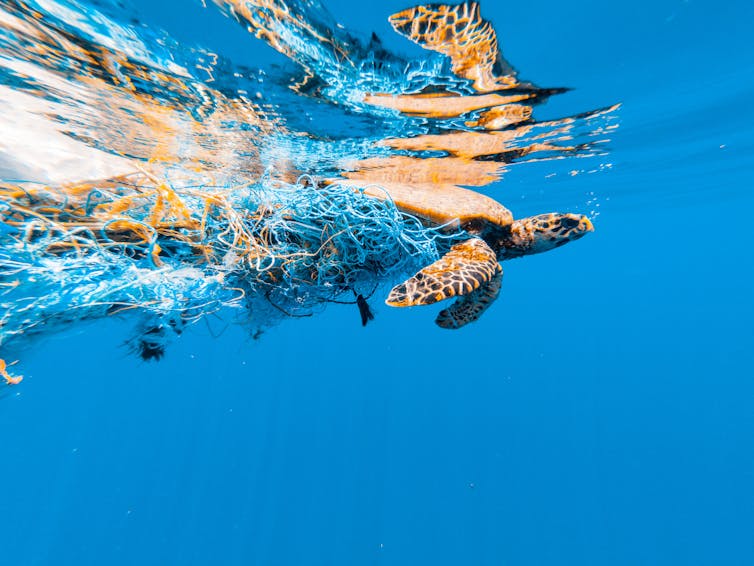
To assess risk, we mapped the vulnerability and distribution of each megafauna group or habitat against the abundance of plastic. Each point within the map was given a risk score from zero to five. The greatest risk occurred in areas where high numbers of vulnerable megafauna or habitats overlapped with high concentrations of plastic.
Managing The Plastic Problem
We found that much of the modelled plastic litter causing risk in the UK originated from UK rivers. In other high-risk zones such as the Azores and the US Gulf of Mexico, plastic primarily originated from other regions. More than 99% of plastic litter in the Azores was estimated to come from the other countries, mainly Caribbean islands and the US.
The potential of this plastic to travel vast distances across the ocean makes management of this pollutant particularly difficult. More than 90% of plastic waste in the Dominican Republic and Haiti are estimated to be mismanaged. This waste has the potential to cause ecological harm across both sides of the Atlantic.
UN member nations have agreed to forge an international legally binding agreement to tackle plastic pollution, called the Global Plastics Treaty, with negotiations expected to be completed by the end of this year. This study highlights the importance of the treaty in ensuring international cooperation to reduce plastic consumption and waste, including the provision of financial support to help lower-income nations such as the Caribbean islands implement measures. Identification of high-risk zones will also help prioritise areas where interventions and monitoring should be targeted.
Even if all plastic intervention measures are implemented, it is likely that substantial amounts of plastic will still enter our oceans. The production, sale and distribution of many of single-use items are likely to be phased out under the Global Plastics Treaty, as nations move to restrict avoidable plastic products.
While global measures are hugely important in the fight against plastic, the choices of consumers also play a significant role. Reducing, re-using and recycling plastic are powerful ways to cut your plastic footprint. At both ends of the spectrum, the choices made at international and household level can be good news for marine wildlife.

Don’t have time to read about climate change as much as you’d like?
Get a weekly roundup in your inbox instead. Every Wednesday, The Conversation’s environment editor writes Imagine, a short email that goes a little deeper into just one climate issue. Join the 30,000+ readers who’ve subscribed so far.![]()
Samantha Garrard, Senior Marine Ecosystem Services Researcher, Plymouth Marine Laboratory
This article is republished from The Conversation under a Creative Commons license. Read the original article.
River pollution is causing harmful outbreaks of sewage fungus in the UK
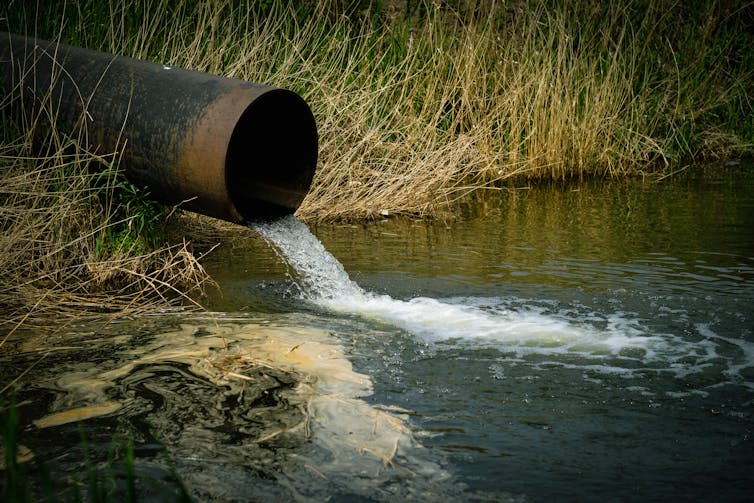
The pollution of the UK’s waterways and coastlines with sewage is throwing its ecosystems out of balance. One well documented example is the spread of microscopic bacteria that can multiply rapidly into algal blooms, causing extensive dead zones once oxygen in the water has been used up.
But there’s another pollution problem that has been largely overlooked, until now. Dangerous outbreaks of sewage fungus are becoming a big problem for the UK’s rivers, ponds and lakes.
While working at the University of Oxford with associate professor Michelle Jackson, my aquatic ecology colleagues and I studied how to detect sewage fungus in polluted rivers. We also investigated how changes in a river’s chemical and physical characteristics might be related with the spread of sewage fungus, for example, the high concentration of nitrates from fertilisers coming from farmland.
Healthy rivers are crucial for ecosystems, drinking water, biodiversity and our wellbeing. But sewage pollution, and the sewage fungus within it, threaten all of this, endangering aquatic life, human health and our economy.
Frequent sewage fungus outbreaks indicate how badly polluted our environment is. Our rivers are in trouble and governments, water companies and regulators need to act fast to protect them before it is too late.
Sewage fungus isn’t actually a fungus. It’s a mix of microscopic bacteria, viruses and organisms that can form visible masses in water. Despite their fungus-like appearance, these masses of threads are made up of tiny single rod-shaped cells.
These bacteria multiply quickly in nutrient-rich environments, such as rivers contaminated with sewage effluent. More than 100 types of sewage fungus have been identified, with two known as Sphaerotilus natans and Beggiatoa alba commonly found in most English rivers.
Sewage fungus predominantly lives in polluted waters with high levels of nutrients. That’s typically in areas with poor water quality or inadequate sewage treatment.
That includes ponds and reservoirs near urban areas with high levels of sewage run-off or polluted rivers and streams where untreated or treated sewage is discharged regularly. Sewage fungus also grows naturally in wastewater treatment plants due to the high concentrations of organic material present.
Sewage fungus, although not always visible to the naked eye, is likely to be present in rivers that receive sewage discharge. Most common methods used to detect it rely on visual inspection of the river, so it is hard to identify early or smaller growth, and we don’t have accurate figures on how widespread the problem is.
However, more hi-tech approaches such as machine learning combined with microscopy can detect and quantify sewage fungus filaments, even before they become visible. We have applied one such technique, using a machine called FlowCam which made it possible to quickly identify and count fungus filaments.
Dangerous For Wildlife And Humans
High levels of sewage fungus indicate poor water quality. Sewage fungus can harm freshwater environments by reducing oxygen levels in the water, affecting aquatic life, reducing the numbers of sensitive organisms and disrupting the natural balance of rivers.
Fish and shellfish can become stressed due to low oxygen levels, making them more prone to disease and ultimately leading to their death.
High levels of sewage fungus can also have negative effects on human health. If contaminated water is used for swimming or fishing this can lead to human sickness, because some of the microorganisms can include human parasites
Sewage fungus effects can interact with other types of human pollution, including agricultural and urban runoff. The full impact of these interactions is not yet well understood.
But it is important to consider all sources of pollution, from sewage to agricultural run-off, when estimating the effect sewage fungus might have on ecosystems. By doing so, water companies and environmental groups can work towards more effective management and protection of rivers and freshwater resources.
What To Do About It
By using more advanced detection methods, regulatory bodies and water companies can monitor rivers more efficiently. More timely action could help limit the source of pollution and prevent future outbreaks of sewage fungus, protecting both freshwater ecosystems and human health.
On a local level, people can report pollution incidents, including sewage fungus outbreak, to the respective authorities: Environment Agency in England, Natural Resources Wales, the Scottish Environment Protection Agency or the Department of Agriculture, Environment and Rural Affairs for Northern Ireland.
Before calling those authorities, it is useful to collect details about the date, time and precise location of the sewage fungus. Passing this information on to the authorities will hopefully encourage more comprehensive monitoring in the future.![]()
Dania Albini, Postdoctoral Research Fellow, Aquatic Ecology, University of Exeter
This article is republished from The Conversation under a Creative Commons license. Read the original article.
Arctic rivers face big changes with a warming climate, permafrost thaw and an accelerating water cycle − the effects will have global consequences

As the Arctic warms, its mighty rivers are changing in ways that could have vast consequences – not only for the Arctic region but for the world.
Rivers represent the land branch of the earth’s hydrological cycle. As rain and snow fall, rivers transport freshwater runoff along with dissolved organic and particulate materials, including carbon, to coastal areas. With the Arctic now warming nearly four times faster than the rest of the world, the region is seeing more precipitation and the permafrost is thawing, leading to stronger river flows.
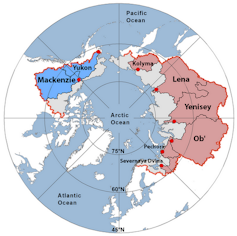
We’re climate scientists who study how warming is influencing the water cycle and ecosystems. In a new study using historical data and sophisticated computer models of Earth’s climate and hydrology, we explored how climate change is altering Arctic rivers.
We found that thawing permafrost and intensifying storms will change how water moves into and through Arctic rivers. These changes will affect coastal regions, the Arctic Ocean and, potentially, the North Atlantic, as well as the climate.
Thawing Permafrost: Big Changes In Arctic Soils
Permafrost thaw is one of the most consequential changes that the Arctic is experiencing as temperatures rise.
Permafrost is soil that has been frozen for at least two years and often for millennia. It covers approximately 8.8 million square miles (about 22.8 million square kilometers) in Earth’s Northern Hemisphere, but that area is shrinking as the permafrost thaws.
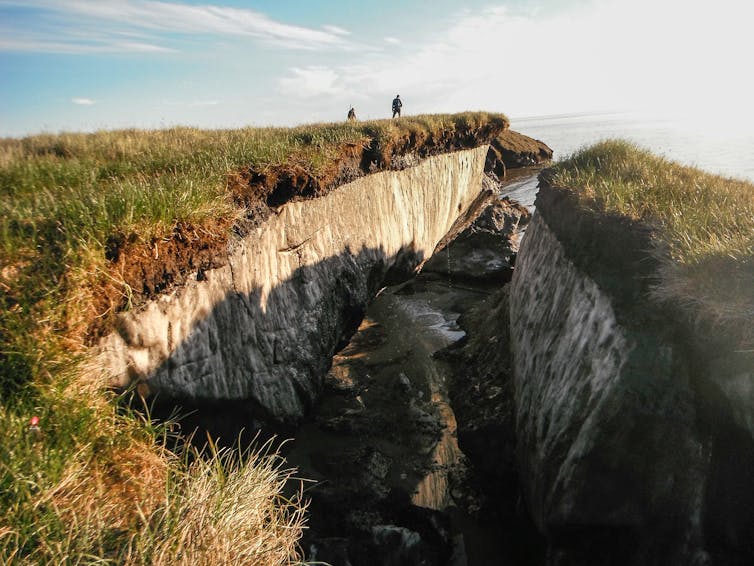
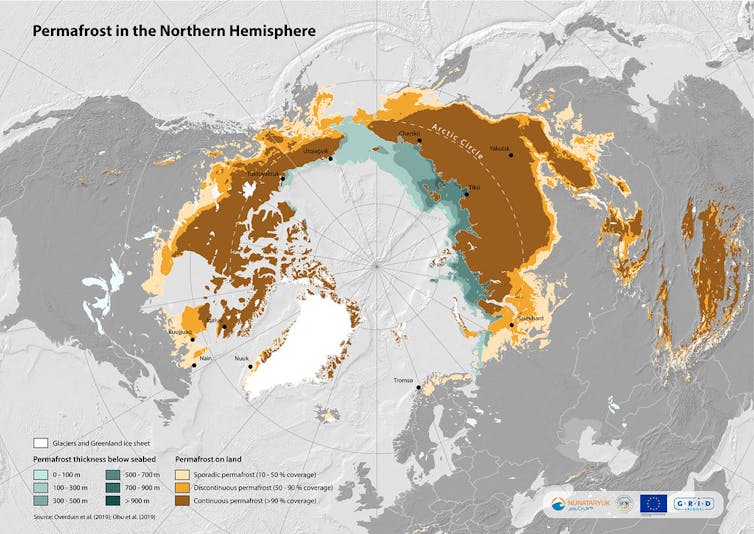
Historically, most water going into Arctic rivers flows atop frozen permafrost soils in spring. Scientists call this “overland runoff.”
However, our results suggest that as warming continues, an increasing fraction of annual river flow will come from under the surface, through thawed soils in the degrading permafrost. As the overall flow increases with more precipitation, as much as 30% more of it could be moving underground by the end of this century as subsurface pathways expand.
When water flows through soil, it picks up different chemicals and metals. As a result, water coming into rivers will likely have a different chemical character. For example, it may carry more nutrients and dissolved carbon that can affect coastal zones and the global climate. The fate of that mobilized carbon is an active area of study.
More carbon in river water could end up “outgassed” upon reaching placid coastal waters, increasing the amount of carbon dioxide released into the atmosphere, which further drives climate warming. The thaw is also revealing other nasty surprises, such as the emergence of long-frozen viruses.
More Rain And Snow, More Runoff
The Arctic’s water cycle is also ramping up as temperatures rise, meaning more precipitation, evaporation, plant transpiration and river discharge. This is primarily due to a warmer atmosphere’s inherent ability to hold more moisture. It’s the same reason that bigger snowstorms are occurring as the climate warms.
Our study found that the bulk of the additional precipitation will occur across far northern parts of the Arctic basin. As sea ice disappears in a warming climate, computer models agree that a more open Arctic Ocean will feed more water to the atmosphere, where it will be transported to adjacent land areas to fall as precipitation.
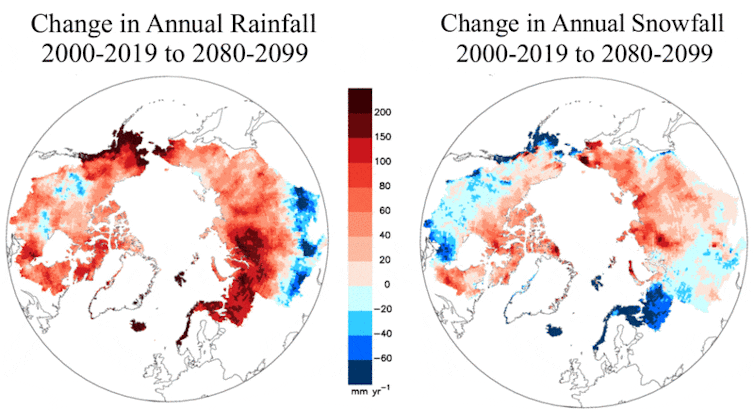
More snow in northern Alaska, Siberia and Canada will lead to more water flowing in rivers, potentially up to 25% more under a high-warming scenario based on our research. There is more carbon in the soil in northern parts of the Arctic compared with the south. With permafrost thaw, those regions will also see more water coming into rivers from below the surface, where additional soil carbon can leach into the water and become dissolved organic carbon.
More old carbon is already showing up in samples gathered from Arctic rivers, attributed to permafrost thaw. Carbon dating shows that some of this carbon has been frozen for thousands of years.
Impacts Will Cascade Through Arctic Ecosystems
So, what does the future hold?
One of the most notable changes expected involves the transport of fresh water and associated materials, such as dissolved organic carbon and heat energy, to Arctic coastal zones.

Coastal lagoons may become fresher. This change would affect organisms up and down the food chain, though our current understanding of the potential affects of changes in fresh water and dissolved organic carbon is still murky.
River water will also be warmer as the climate heats up and has the potential to melt coastal sea ice earlier in the season. Scientists observed this in spring 2023, when unusually warm water in Canada’s Mackenzie River carried heat to the Beaufort Sea, contributing to early coastal sea ice melting.
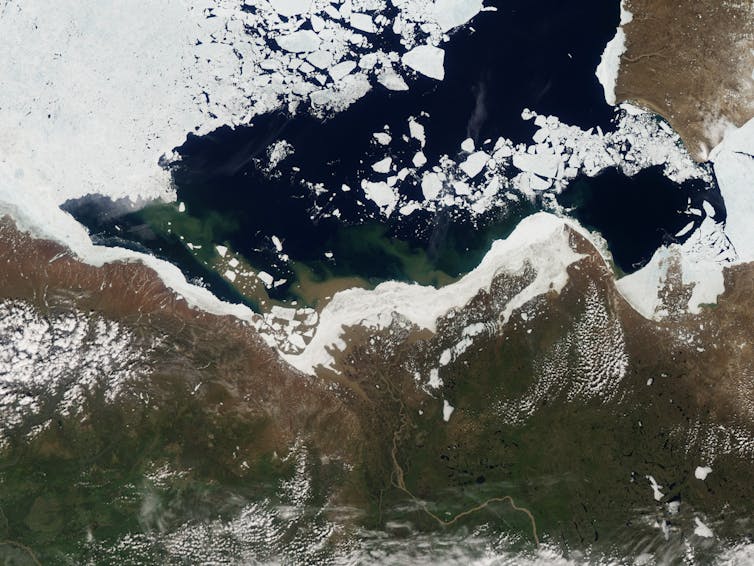
Finally, more river water reaching the coast has the potential to freshen the Arctic Ocean, particularly along northern Eurasia, where big Russian rivers export massive amounts of fresh water each year.
There are concerns that rising river flows in that region are influencing the Atlantic Meridional Overturning Circulation, the currents that circulate heat from the tropics, up along the U.S. East Coast and toward Europe. Evidence is mounting that these currents have been slowing in recent years as more fresh water enters the North Atlantic. If the circulation shuts down, it would significantly affect temperatures across North America and Europe.
At the coast, changing river flows will also affect the plants, animals and Indigenous populations that call the region home. For them and for the global climate, our study’s findings highlight the need to closely watch how the Arctic is being transformed and take steps to mitigate the effects.![]()
Michael A. Rawlins, Associate Director, Climate System Research Center and Associate Professor of Climatology, UMass Amherst and Ambarish Karmalkar, Assistant Professor of Geosciences, University of Rhode Island
This article is republished from The Conversation under a Creative Commons license. Read the original article.
Sharks, turtles and other sea creatures face greater risk from industrial fishing than previously thought − we estimated added pressure from ‘dark’ fishing vessels
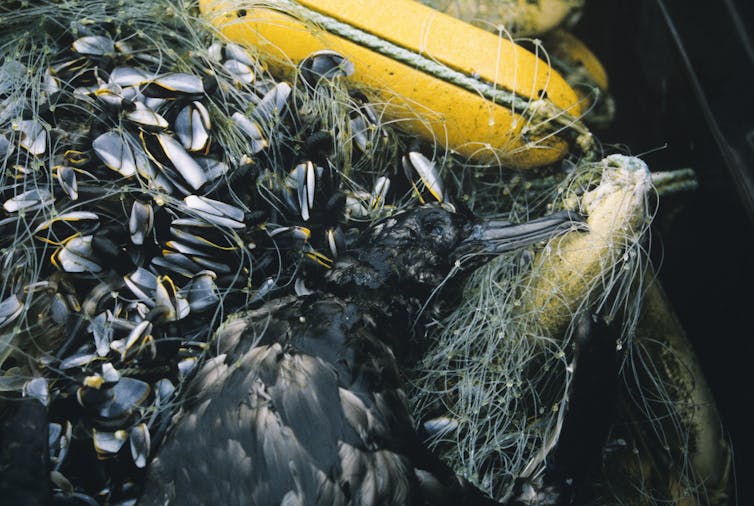
My colleagues and I mapped activity in the northeast Pacific of “dark” fishing vessels – boats that turn off their location devices or lose signal for technical reasons. In our new study, we found that highly mobile marine predators, such as sea lions, sharks and leatherback sea turtles, are significantly more threatened than previously thought because of large numbers of dark fishing vessels operating where these species live.
While we couldn’t directly watch the activities of each of these dark vessels, new technological advances, including satellite data and machine learning, make it possible to estimate where they go when they are not broadcasting their locations.
Examining five years of data from fishing vessel location devices and the habitats of 14 large marine species, including seabirds, sharks, turtles, sea lions and tunas, we found that our estimates of risk to these animals increased by nearly 25% when we accounted for the presence of dark vessels. For some individual predators, such as albacore and bluefin tunas, this adjustment increased risk by over 36%. The main hot spots were in the Bering Sea and along the Pacific coast of North America.
How We Did Our Work
Fishing boats use Automatic Identification System, or AIS, to avoid colliding with each other. Their AIS signals bounce off satellites to reach nearby ships.
This data is a valuable tool for mapping risk at sea and understanding the footprints of fishing fleets. AIS data captures an estimated 50% to 80% of fishing operations occurring more than 100 nautical miles from shore.
But in some areas, vessels’ AIS signals can’t reach the satellites, either because reception is poor or many boats are crowded together – much as cellphones can have difficulty sending text messages in remote wildness or in crowded stadiums. And just as location tracking can be disabled on phones, fishing vessels can intentionally disable their AIS if they want to hide their location. Boats that do this may be engaged in criminal activities, such as illegal fishing or human trafficking.
We calculated how much risk dark vessels pose to marine life by overlapping their activity with the modeled habitats of 14 highly mobile marine predators. Using the same method, we also calculated how much risk observable fishing vessels that broadcast their locations pose to marine life. These two calculations allowed us to understand the additional risk from dark fishing vessels.
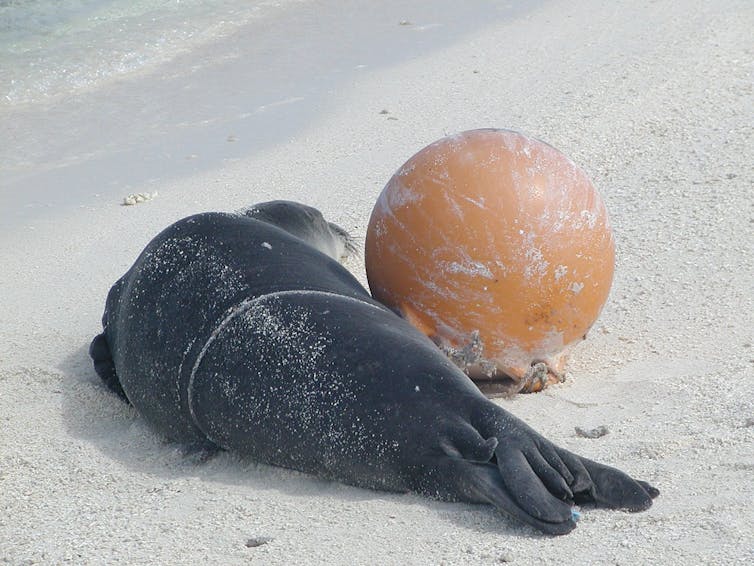
Why It Matters
We know that many sea creatures, including endangered species, are killed by overfishing, accidental catch and entanglement in fishing gear. More overlap between wildlife and fishing boats means that those harmful impacts are more likely to happen.
Even considering only observable fishing boats broadcasting their positions, the presence of boats signals considerable risk for marine life. For example, California sea lions forage in Pacific coastal waters from the Canadian border to Baja California and are accidentally caught by boats fishing for hake and halibut. We found observable fishing activity in over 45% of the sea lions’ habitat.
In another example, migratory salmon sharks feed on salmon near Alaska’s Aleutian Islands during the summer and breed in warmer waters off the coasts of Oregon and California during the winter. Along their journey, salmon sharks are accidentally caught in fishing nets and longlines. We detected observable vessel fishing activity in nearly one-third of salmon shark habitat.
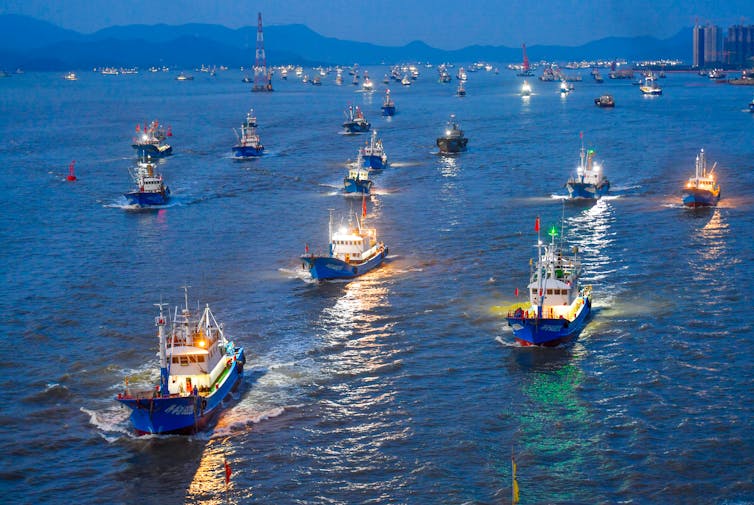
Our findings indicate that such threats are higher when dark fishing boats are present. Estimates of risk to California sea lions and salmon sharks increased by 28% and 23%, respectively, when we accounted for dark vessels.
This information could affect fishery regulation. For example, regulators use risk information to set catch limits for species such as tuna; higher risk could mean that catch limits need to be lower.
For species such as sea lions and salmon sharks that are accidentally caught by fishermen, higher risk levels could indicate that fishing boats should use more selective gear. California is currently acting on this issue by helping fishermen phase out use of large-mesh drift gill nets in state waters. These nets, which hang like curtains in the water, catch many other fishes along with the target species.
Accounting for dark vessels is particularly important in international waters where boats from multiple countries operate, because AIS data is one of the most complete sources of fishing activity across nations. Tracking dark vessels can help make this information as comprehensive as possible and provide insights into the multinational impacts of fishing.
Our study does not account for vessels that do not use any vessel tracking system, or that use systems other than AIS. Therefore, our risk calculations likely still underestimate the true impact of fisheries on marine predators.
What’s Next
The world’s oceans are rich in life but poor in data, although this is changing. High-resolution satellite imagery may soon offer even more information on risk from dark vessels.
President Joe Biden and other global leaders have pledged to protect 30% of the ocean by 2030. Better data on human-wildlife interactions at sea can help ensure that new protected areas are in the right places to make a difference.![]()
Heather Welch, Researcher in Ecosystem Dynamics, University of California, Santa Cruz
This article is republished from The Conversation under a Creative Commons license. Read the original article.
Orcas Demonstrating They No Longer Need To Hunt In Packs To Take Down The Great White Shark
AOC And ASICS Reveal Australian Olympic Team Uniforms For Paris 2024


- Alex Purnell - Rowing, Olympic champion
- Brandon Starc - High Jump, dual Olympian
- Charlotte Caslick - Rugby 7s, Olympic champion, dual Olympian
- Eddie Ockenden - Hockey, 4-time Olympian and Olympic silver & 2 x bronze medallist
- Eileen Cikamatana - Weightlifting, Oceania record holder, aiming for Olympic debut
- Grae Morris - Sailing (iQFOiL windsurfing), selected to make Olympic debut in Paris
- Izzi Batt-Doyle - Athletics, Tokyo Olympian
- Kelsey-Lee Barber - Javelin, Olympic bronze medallist & 2-time World Champion
- Lydia Williams - Football, dual Olympian and Noongar woman
- Mariah Williams - Hockey, dual Olympian and Wiradjuri woman
- Maurice Longbottom - Rugby 7s, Tokyo Olympian and Dharawal man


Sally Fitzgibbons Wins Gold At The 2024 ISA World Surfing Games
Monday 4th March, 2024 (Australian Time): Sally Fitzgibbons has charged her way through seven heats to win gold and make history, at the ISA World Surfing Games in Puerto Rico overnight.
Fitzgibbons defeated defending gold medallist Tatiana Weston-Webb (BRA) by 0.86 points to claim victory on a day of challenging conditions.
"Paddling out for that final, I had a really calm feeling wash over me," she said.
"I knew that it was gonna take the bigger, taller sections and attacking surfing, and I had to find that in myself going toe to toe with opponents from Brazil and France that I’ve surfed with for 10 plus years on the world tour. There’s sometimes a lot of scar tissue of some instances where it’s just been so tight, and they’ve got me and pipped me at the post. Just to know that I still lean into that and it's possible to win one back on them, that's the exciting thing about surfing and why I still show up to the Games."
Fitzgibbons made history by becoming the first athlete to ever earn individual gold four times at the World Surfing Games. She first accomplished the feat in 2008 before earning her second gold in 2018 and third in 2021.
She said she was spurred on by the Irukandjis team spirit.
"To navigate through and not have the best opportunities in terms of waves, it was all about the grit and the digging deep and hearing my team on the beach cheering and just that encouragement and belief everyone had around me.
"I just have an immense amount of pride thinking about the people I’m representing back home and everyone that's put into my journey and my career. And then everyone’s doing the ring of fire and saying Aussie Aussie Aussie, it’s just crazy, the biggest shots of adrenaline through my system.
"It’s just topped off going to the closing ceremony and standing on top of the podium and hearing your anthem. That emotion wells up, the tears come out and it's just that childhood dream you're living out. That's why I wake up every day and try and keep doing my process, so I have the opportunity to keep showing up and experiencing things like I did today. It's a proud moment to be leaving Puerto Rico with the gold medal. And just stinging good efforts form everyone from coaching staff and Team Australia and I’m leaving here with very high spirits."
Sally's win wasn't enough for Australia to secure the extra Paris 2024 Olympic Games slot, with Brazil the highest-ranking women's team on the scoreboard at the end of the event.
Women's final results:
1st - Sally Fitzgibbons (AUS)
13.10 (6.83 + 6.27)
2nd - Tatiana Weston Webb (BRA)
12.24 (6.77 + 5.47)
3rd - Johanne Defay (FRA)
12.00 (6.00 + 6.00)
4th - Nadia Erostarbe (ESP)
9.57 (4.90 + 4.67)
Final team's standings (top 5):
Brazil - 1755 pts
Australia - 1720 pts
Spain - 1495 pts
France -1460 pts
Peru - 1350 pts




Photos: Sally Fitzgibbons has won gold at the ISA World Surfing Games. Images: ISA / Jersson Barbozaan and ISA/Pablo Franco
The Irukandjis name was generously gifted to Surfing Australia by the local Yirrganydji people of North Queensland, driven by the efforts of Indigenous athlete and former World Tour surfer, Soli Bailey. Our namesake and tagline is ‘The Irukandjis: Deadly in the Water’, after the Irukandji jellyfish – an extremely venomous species of jellyfish that inhabit Australian marine waters.
Australian representatives across all surfing genres, including Junior, Open, Masters, Olympic, Longboard, Big Wave, Stand Up Paddleboard (SUP) and Adaptive disciplines, compete under The Irukandjis national identity and united colours at international events such as the Olympics, International Surfing Association (ISA), World Surfing Games, WSL World Juniors and Longboard Championships.
History Of The Narrabeen Tramline
by BackTracks
Youth Advisory Group Formed To Represent The Local Youth Voice
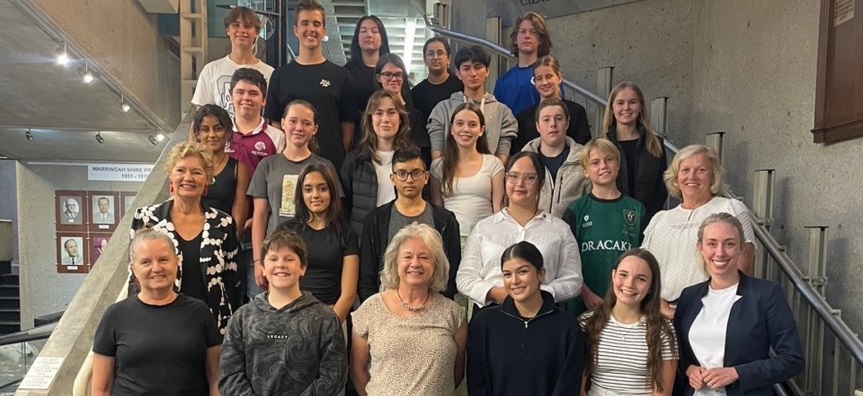
Early Autumn Moth + Caterpillar That Will Become A Moth
Lichen Moths (Arctiidae: Lithosiinae) - Alternative Name/S: Footman Moths
Painted Apple Moth Caterpillar
- Dahlia ( Dahlia pinnata, ASTERACEAE ),
- Cypress ( Cupressus, CUPRESSACEAE ),
- Lupins ( Lupinus, FABACEAE ),
- Geranium ( Pelargonium x zonale, GERANIACEAE ),
- Gladiola ( Gladiolus byzantinus, IRIDACEAE ),
- Albizia ( Albizia species, MIMOSACEAE ),
- Banana Fruit ( Musa acuminata, MUSACEAE ),
- Passionfruit ( Passiflora edulis, PASSIFLORACEAE ),
- Primrose ( Primula, PRIMULACEAE ),
- Roses ( Rosa odorata, ROSACEAE ),
- Gardenia ( Gardenia jasminoides, RUBIACEAE ),
- ( Gardenia jasminoides, RUTACEAE ),
- Willow ( Salix, SALICACEAE ),
- Native Cherry ( Exocarpus cupressiformis, SANTALACEAE ),
- Lantana ( Lantana camara, VERBENACEAE ).
- Coral Pea ( Hardenbergia species, FABACEAE ),
- Wattles ( Acacia species, MIMOSACEAE ),
- Bottlebrush ( Callistemon species, MYRTACEAE ),
- Ferns ( POLYPODIOPHYTA ), and
- Spider Flowers ( Grevillea species, PROTEACEAE ).
NSW Youth Week 2024: Express. Empower. Get Loud!
- share ideas
- attend live events
- have your voice heard on issues of concern to you
- showcase your talents
- celebrate your contribution to the community
- take part in competitions
- have fun!
- Express – Youth week is a chance for every young person from across NSW to be themselves! It gives young people the opportunity to showcase their talents and getting involved.
- Empower – It’s time for young people in NSW to have their voices heard on issues that matter to you. Register here to participate in the Advocate for Children and Young People’s opportunities to have your say.
- Get loud! – Get loud and celebrate together at local community events happening in your local community and across NSW.
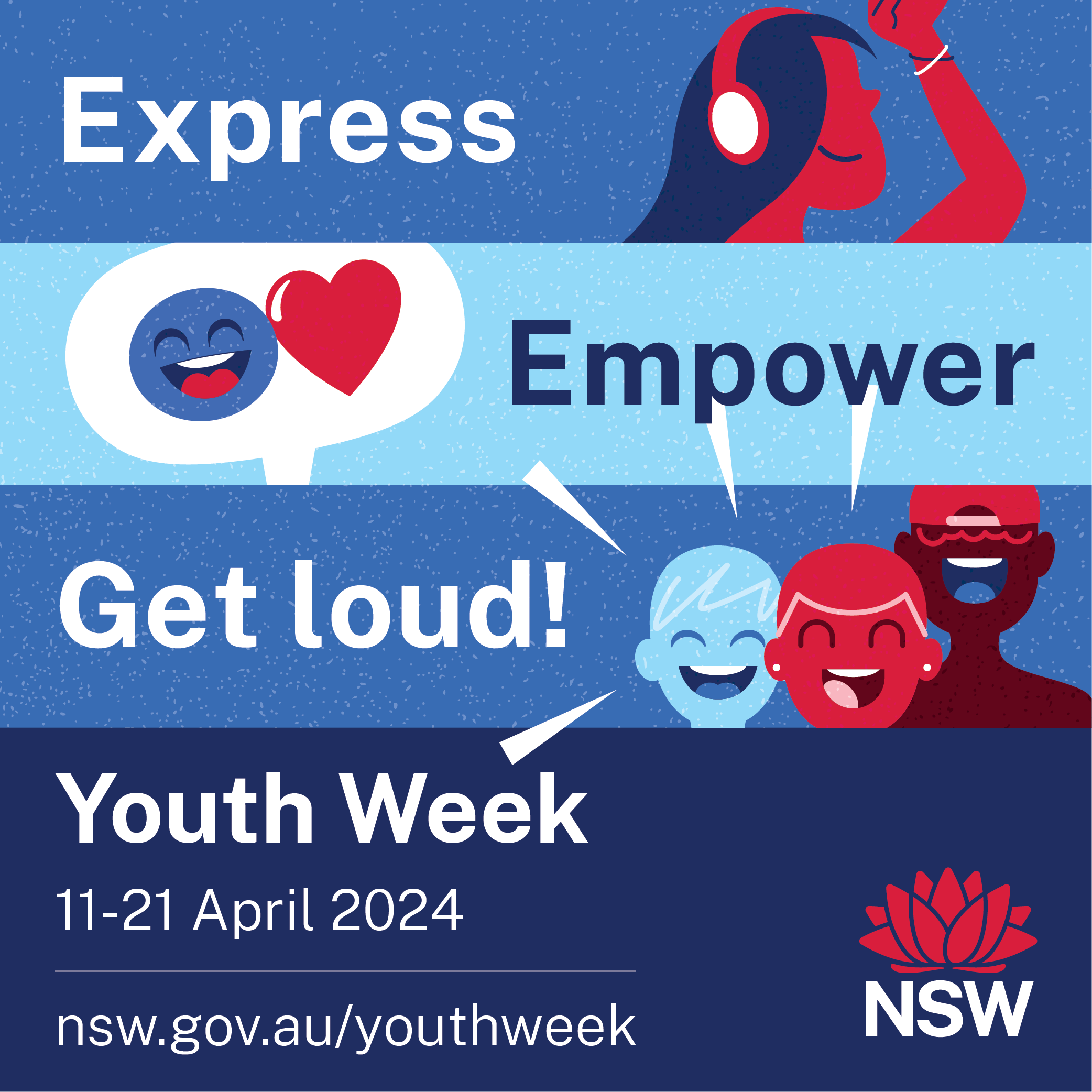
Northern Composure Band Competition: Entries Open Until March 17
- Ocean Alley
- Lime Cordiale
- Dear Seattle
- The Rions
- Crocodylus
- C.O.F.F.I.N
- Edgecliff
- A Triple J announcer plus a wide range of industry professionals
- Entries open: Thursday 22 February - Sunday 17 March
- People's choice voting open for online heats: Monday 18 March – Sunday 24 March
- Band workshop: Wednesday 20 March - Location TBC
- Semi final 1: Saturday 6 April, YoYo’s, Frenchs Forest
- Semi Final 2: Saturday 13 April, Mona Vale Memorial Hall
- Grand Final: Saturday 20 April, PCYC Dee Why
- Ensure you have read the Eligibility Criteria and all Key Information below
- Upload you video entry onto a hosting platform (eg YouTube, Vimeo)
- Fill out the registration form
- Ensure all band members are available for this year's key dates

Girls Rugby Open Day
When: Sunday, March 17th, 2-4pm
Where: Rat Park, Warriewood
Local Clubs are uniting for the ultimate girls rugby event!
We are hosting a girls' rugby union open day at Rat Park, grab your friends and head down to see what the game is all about.
Get ready to redefine what it means to be strong. It's not just about tackles and tries, it's about building unshakable confidence and making lifelong friends. We can show you that the field will be your new playground.
GUEST SPEAKERS, GAMES AND PRIZES
We've got the incredible Wallaroo, Waratah and Rat's Women joining us!
Listen to their inspiring journeys, learn from the best, and discover how rugby shaped their fearless path.
We have prize giveaways lined up, so this is your chance to score big on and off the field.
Join us for an action-packed afternoon featuring drill sessions, top Aussie female player guest speakers, and amazing prize giveaways.
Curious about the game? This is your chance to dive in and discover! Don't miss out!

Expressions Of Interest For The 2024 RPAYC Youth Development Program Are Now Available!
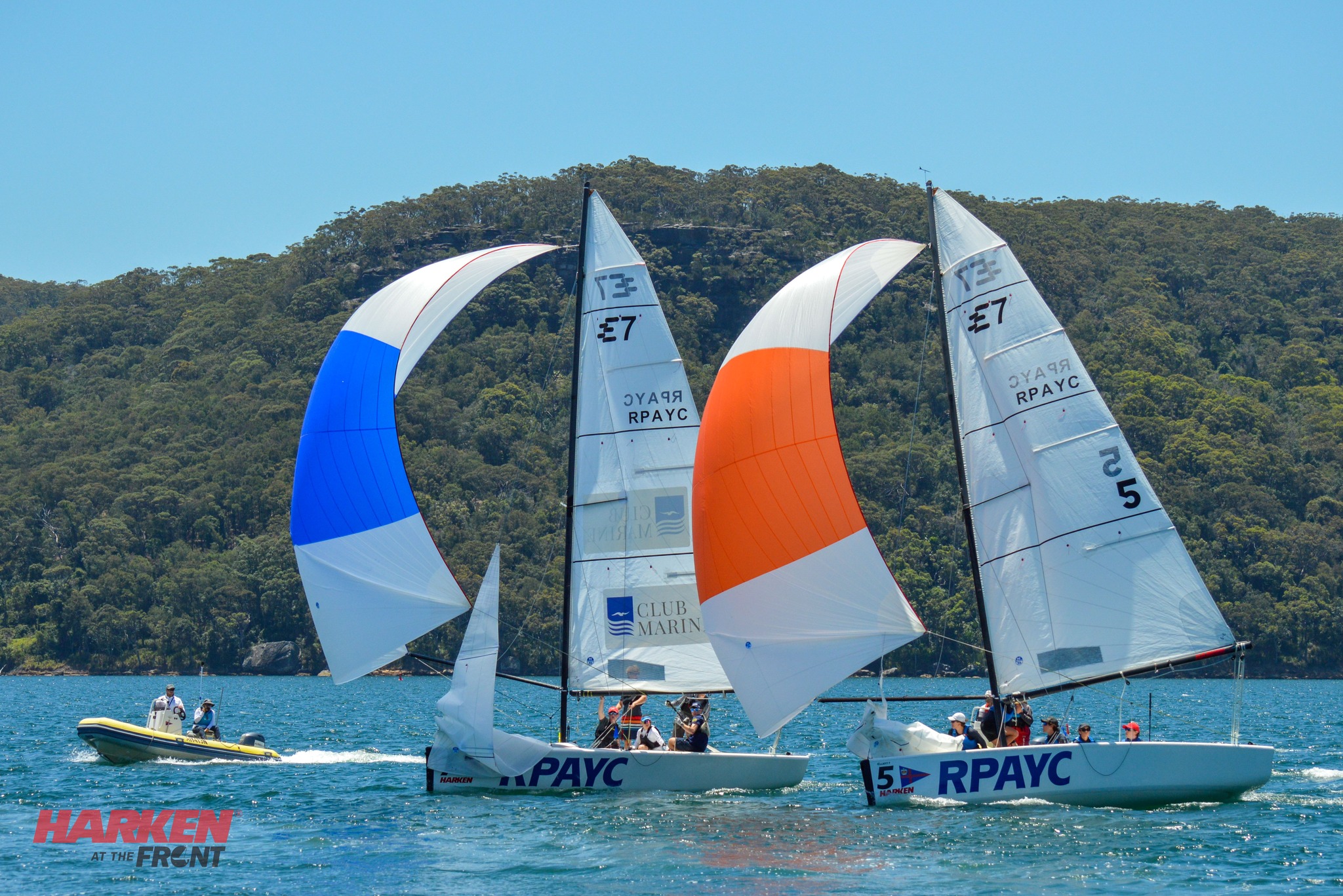
Early Childhood Workforce Given $17 Million Boost After Record Number Of Scholarship Applications
- Up to $25,000 for early childhood teaching (ECT) qualifications.
- Up to $5,000 for diploma and certificate III ECEC and OSHC qualifications.
Calling All High School Student Video Makers
.jpg?timestamp=1707430256057)
School Leavers Support
- Download or explore the SLIK here to help guide Your Career.
- School Leavers Information Kit (PDF 5.2MB).
- School Leavers Information Kit (DOCX 0.9MB).
- The SLIK has also been translated into additional languages.
- Download our information booklets if you are rural, regional and remote, Aboriginal or Torres Strait Islander, or living with disability.
- Support for Regional, Rural and Remote School Leavers (PDF 2MB).
- Support for Regional, Rural and Remote School Leavers (DOCX 0.9MB).
- Support for Aboriginal and/or Torres Strait Islander School Leavers (PDF 2MB).
- Support for Aboriginal and/or Torres Strait Islander School Leavers (DOCX 1.1MB).
- Support for School Leavers with Disability (PDF 2MB).
- Support for School Leavers with Disability (DOCX 0.9MB).
- Download the Parents and Guardian’s Guide for School Leavers, which summarises the resources and information available to help you explore all the education, training, and work options available to your young person.
School Leavers Information Service
- navigate the School Leavers Information Kit (SLIK),
- access and use the Your Career website and tools; and
- find relevant support services if needed.
Word Of The Week: Thought
Noun
1. an idea or opinion produced by thinking, or occurring suddenly in the mind. 2. the action or process of thinking. 3. idea, concept, conception, notion, impression mean what exists in the mind as a representation (as of something comprehended)
Verb
1. past participle: thought; past tense: thought

Tattoo regret? How to choose a removal service

About one in four people regret at least one of their tattoos. Almost half of those go on to have their unwanted tattoo removed or camouflaged with a new one.
So it’s no wonder people are searching for laser tattoo removal services.
Here’s what to consider when choosing the best clinic and what to expect when you get there.
Why Are Tattoos Permanent?
You can still see tattoos on the 5,300-year-old ice mummy Ötzi. That’s because tattoo artists use needles to deposit ink in the dermis, the layer of skin under the outer layer (or epidermis).
When this happens, the body recognises ink particles as “foreign”. So immune cells in the dermis, such as macrophages, take them up.
But the particles are too large for these specialised cells to break down and remove via the lymphatic system. Instead, the particles remain “locked” permanently in macrophages in the dermis.

How Do Lasers Remove Tattoos?
To remove a tattoo, a laser device delivers high-intensity laser pulses to the ink. These incredibly short pulses are delivered in a billionth or trillionth of a second (nanosecond or picosecond pulses), confining the laser energy to the tiny ink particles, minimising damage to the surrounding skin.
Once the ink particles absorb the laser energy, a thermal reaction takes place, increasing the particles’ internal pressure and causing them to expand, then fragment.
The macrophages can now remove these smaller particles via the lymphatic system. That’s when your tattoo starts to fade.
Can All Inks Be Removed?
Most inks can be removed, but several factors affect the result.
Colours
Each colour absorbs a different wavelength of light, so each colour requires a specific laser to be removed effectively. This may require using several different machines over the course of the treatment.
Some colours are much more challenging to remove than others. For instance, black ink is much easier to remove than yellow, which is easier to remove than white. This is because different pigments (such as black) are more likely to absorb the laser’s energy than others (yellow or white).
As a result, tattoos with white ink particles often need extra therapies. These include ablative laser treatments, which vaporise the tissue containing the tattoo ink, and tattooing over the original tattoo with a saline solution, which helps to draw the tattoo out of the skin.

Combination of colours
Tattoo inks can also be made up of many colours to achieve the desired shade.
For example, a red ink may have touches of yellow ink to create a poppy red. As the red particles are broken down, the yellow appears and must be treated with a different wavelength, sometimes requiring a different machine and extra sessions.
Your skin colour
Any laser that can target and destroy an ink particle can also target natural skin pigment and the cells that produce them. This can result in overheating of the skin, and in severe cases, damage or destruction of the cells that produce pigment. This causes the skin to either darken or lighten in response to the injury, sometimes permanently.
So it’s important to choose a tattoo removalist who not only knows how to operate the laser, but how to choose the right wavelengths and modify the treatment plan as the tattoo changes.
Choosing A Tattoo Removalist
Laser tattoo removal creates a controlled wound in your skin, so it’s important to choose the right service to get the result you want, without increasing your risk of complications.
But in Australia, there is no national regulation for laser tattoo removal services, so standardising practitioners’ education and the treatments they offer is an ongoing challenge. Instead, each state and territory either licenses its own practitioners, or has no licensing at all.
As there are no licensing requirements in Victoria, New South Wales, Australian Capital Territory, South Australia and the Northern Territory, anyone can legally own and operate laser devices to remove tattoos there.

But in Queensland, Tasmania and Western Australia, tattoo removal providers need a licence to operate and must have studied infection control, laser safety and tattoo removal. They also need to have many hours of supervised practical experience.
In unregulated states and territories, look for a practitioner with similar education and extensive practical experience, such as a bachelor-qualified dermal clinician.
How Long Will It Take And How Much Will It Cost?
Most tattoos require multiple sessions to be effectively removed. The inks and art style, as well as the tattoo size, play a big role in how many sessions it will take – and how much it will cost.
An experienced practitioner will use the Kirby-Desai scale – which includes noting your skin colour, body site, scarring, ink colour and density, and layering of ink – to estimate how many sessions your specific tattoo will need.
Typically, black fine-line tattoos are easier to remove than coloured high-density tattoos, such as a portrait or sleeve.
You’ll also need to allow time between sessions for your tattoo to recover, since the wound needs to heal before the next treatment.
After your laser treatment, your practitioner will advise you on how to manage the health of your skin. In many circumstances you will be asked to keep the area cool, and depending on the tissue response, you may need topical aftercare products (such as emollient creams and a protective hydrogel dressing) to keep the area clean and hydrated.
There are many variables that influence how quickly your tattoo will heal after treatment. This includes where the tattoo is (for instance, a chest tattoo heals faster than an ankle tattoo), the devices used, and your general health. The more compromised your health, the longer it will take to heal.
Watch Out For Allergies
Depositing tattoo ink in the dermis can cause acute and chronic skin reactions, including allergic or inflammatory reactions, infections, and hypersensitivity responses. So it’s important to tell your practitioner how your skin responded to the initial tattoo. That’s because you might be at risk of the same response again when the laser breaks down the tattoo ink.
An experienced practitioner will conduct a thorough consultation to ensure they identify any treatment risks. If necessary, they will work with your GP or dermatologist to ensure the safe removal of your tattoo.![]()
Katie Lee, PhD Candidate, Dermatology Research Centre, The University of Queensland; Claire Coulstock, Lecturer in dermal science, Victoria University, and Samantha Reeve, Course Chair and Lecturer, Bachelor of Dermal Sciences, Victoria University
This article is republished from The Conversation under a Creative Commons license. Read the original article.
NBN upgrade: what a free speed increase for fast broadband plans would mean for consumers and retailers
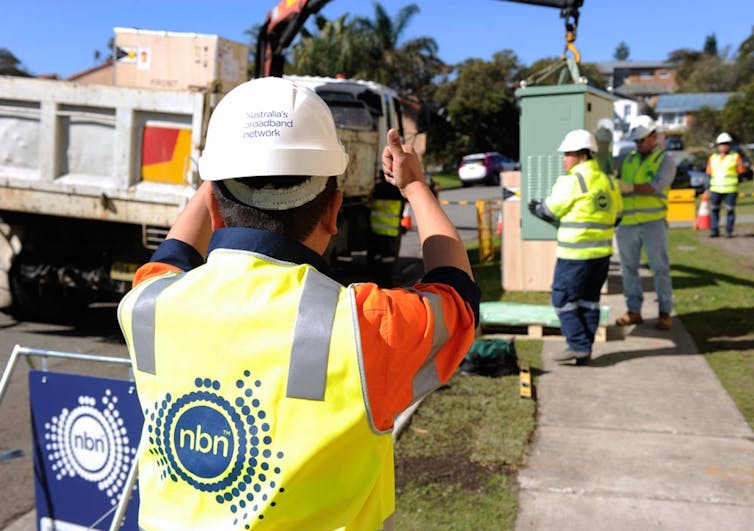
The National Broadband Network may offer a significant speed boost to many users, if a plan from NBN Co, the operator of the network, is implemented. NBN Co’s proposed upgrade would provide download speeds up to five times faster for users on its three fastest home services (Home Fast, Home Superfast and Home Ultrafast).
The speed boost would come at no extra wholesale cost to retailers. On its face, this is an exciting announcement that aims to meet consumer demand for higher speed broadband connections to the internet.
NBN Co has highlighted the rationale for this move. The average Australian household now has around 22 internet-connected devices, and this is expected to grow to 33 by 2026. Data usage per household has doubled in the past five years, and now averages 443 gigabytes per month.
Why Do People Want More Data?
Higher data usage is being driven by new applications, entertainment and online gaming. For example, game updates can be as large as 30 or more gigabytes today. If games update regularly, the amount of data used each month increases quickly.
Entertainment too is using more data. Most streaming video today is provided in a 720p format, but newer televisions can display content at the higher-resolution 4K format. With faster broadband speeds becoming more common, consumers should anticipate more 4K content becoming available.
Likewise, virtual reality and augmented reality are relatively new technologies that are slowly becoming integrated with gaming and business systems. These high data usage technologies are likely to become more present in our daily lives over the next decade.
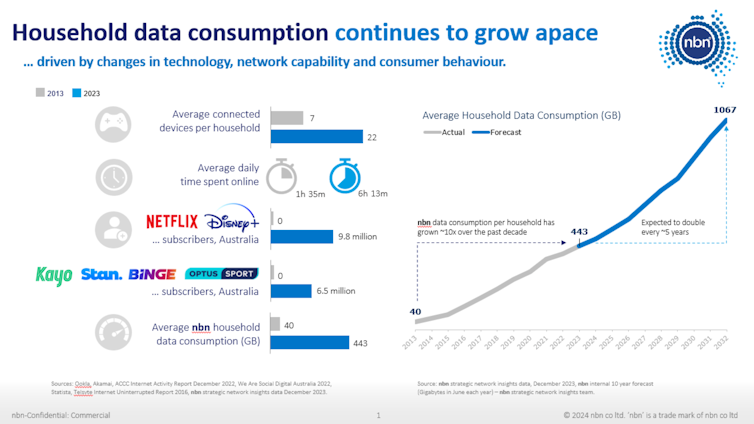
When Would The Upgrades Happen?
NBN Co has indicated it would like to start providing the new higher speed products later this year, or early next year. The upgrade would be achieved by increasing the overall capacity of the NBN, which could then be “shared out” to consumers.
The NBN Co announcement is something the service providers should have expected at some point soon.
NBN Co’s announcement, coming only months after the Australian Competition and Consumer Commission (ACCC) approved a proposal for major annual price increases, may not be welcomed by all broadband retailers.
A spokesperson for the second largest broadband retailer, TPG Telecom, told CommsDay yesterday:
It took more than two years to finalise [the new pricing approved by the ACCC] and only three months for NBN Co to undermine the certainty it was supposed to create. We will always welcome opportunities to deliver greater service and speed to our customers, but NBN’s monopolistic whims make genuine collaboration with them very difficult.
Retailers understandably want certainty in wholesale pricing. One difficulty in achieving this is the high cost of “backhaul” in Australia: this is an intermediate connection between service providers and the NBN itself. Larger retailers have their own backhaul infrastructure, but smaller retailers must pay a third party.
If the NBN offers higher speed broadband connections, smaller retailers may end up paying more for backhaul – and will be faced with a dilemma over whether to pass these extra costs to consumers.
Telstra and Optus have broadly supported the plan by NBN Co to move to new technologies that offer the higher speed capabilities.
A Faster Network May Entice Consumers
Aussie Broadband Group managing director Phillip Britt told Gizmodo Australia:
Aussie Broadband is still understanding the detail of NBN Co’s speed proposal, but on the face of it, it could represent one of the most exciting steps in technology adoption for Australian households and businesses.
For NBN Co, the boost for the higher-speed plans may entice consumers to move from basic 50 Mbps plans to the upgraded Home Fast plan (which will offer download speeds of 500 Mbps, up from the current 100 Mbps).
NBN Co may also hope this encourages the remaining consumers with copper “fibre to the node” connections to move to “fibre to the premises” by taking advantage of one of the low or no cost upgrade offers available through retailers.
NBN Co has issued a consultation paper to retailers, asking for their feedback on the proposed changes to the high speed products by April 19 2024.![]()
Mark A Gregory, Associate Professor, School of Engineering, RMIT University
This article is republished from The Conversation under a Creative Commons license. Read the original article.
The first Europeans reached Ukraine 1.4 million years ago – new research

During warm periods in Earth’s history, known as interglacials, glaciers the size of continents pulled back to reveal new landscapes. These were new worlds for early humans to explore and exploit, and 1.4 million years ago this was Europe: a Terra nullius unoccupied by humans.
Long before it emerged as the epicentre of global colonialism, Europe was itself colonised for the first time by humans migrating from the east.
A new study, led by a team from the Czech Academy of Sciences and Aarhus University and published this week in Nature, reports the earliest human presence in Europe, at a site on the Tysa River in western Ukraine known as Korolevo.
Buried Stone Tools At Korolevo, Ukraine
We studied a layer of stone tools left on a river bed by the people who crafted them. These “core-and-flake” tools were made in the Oldowan style, the most primitive form of tool-making, first classified by the palaeoanthropologist Mary Leakey in east Africa. Similar tools have also been found at the oldest known sites of human occupation in Europe, the Levant, and Asia.
The tools at Korolevo had been buried by river sediment and later by wind-blown dust, and then eventually uncovered by workers at a stone quarry. Evidence of prehistoric people at this site was first discovered in 1974 by the Ukrainian archaeologist, V. N. Gladilin.
Early efforts to date the tools proved troublesome. Measurements of remnant magnetism in the overlying sediments indicated that the lowermost tools predate the most recent reversal in the Earth’s magnetic field 0.8 million years ago, an event known as the Matuyama-Brunhes reversal. This timing is well beyond the limits of commonly used dating methods, such as radiocarbon (useful back to about 50 thousand years) and luminescence dating (usually limited to the last 300 thousand years or so).
A Dating Method Based On Cosmic Rays
To solve this problem, we applied an innovative dating method using cosmogenic nuclides that can reach back 5 million years, the critical timeframe for human evolution. This method has already yielded definitive ages at other key sites, such as the 3.4 million year old Australopithecus at Sterkfontein in southern Africa, and the 0.77 million year old Zhoukoudian Homo erectus, also known as ‘Peking Man’.
It works like this: exploding stars (supernovae) outside our Solar System release streams of cosmic rays that enter Earth’s upper atmosphere, sending showers of secondary cosmic rays down to Earth, where they react with minerals in rocks and soils to produce radioactive nuclides in tiny but measurable quantities.
We measured two such nuclides, beryllium-10 and aluminium-26, to calculate the burial age. A date was obtained by observing the ratio of these two nuclides, which changes over time during burial due to their differing radioactive decay half-lives: 1.4-million-years for beryllium-10 and 0.7-million-years for aluminium-26.
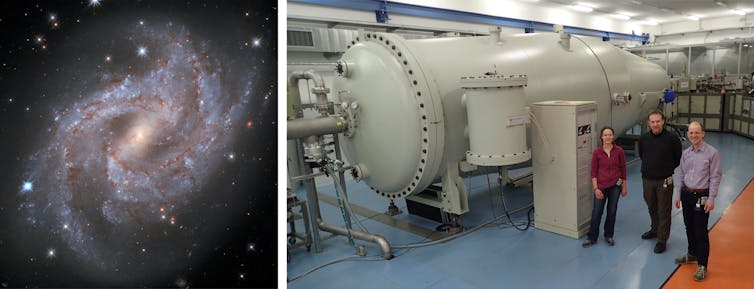
By applying this approach to the sediment layer containing the stone tools at Korolevo, we were able to calculate a burial age of 1.5 to 1.3 million years (the 1-sigma uncertainty range), making this Europe’s earliest securely dated human occupation.
Who Lived At Korolevo?
The absence of fossils at Korolevo means we cannot definitively say who these pioneers were. However, the tools are too old and too primitive to be the work of either anatomically modern humans (Homo sapiens), or Neanderthals. The tool makers were likely some variety of Homo erectus, a remarkably successful ancestor of humans that appeared around 2 million years ago, and spread across diverse habitats in Africa, Asia, and Europe.
On their journey from Africa into Eurasia, early humans passed through the Levant region, where they left signs of occupation as early as 2.5 million years ago at Zarqa Valley. Further north, numerous Homo erectus fossils have been found at Dmanisi in the Caucasus Mountains, dating to 1.8 million years ago.
Europe Colonised From The East
Once into Eurasia, people migrated eastward at a remarkable pace, reaching as far as the island of Java, southeast Asia, by around the same time we find them in western Ukraine. It is not known what caused the delayed westward incursion into Europe, but it appears that Korolevo bridges the migration gap between the Caucasus (1.8 million years ago) and sites in southwestern Europe dated to 1.2 to 1.1 million years at Atapuerca and Vallonnet. One proposal is that people entered Europe from the east via the Danube Valley and Pannonian Plain.
What they found was very different to the present day. 1.4 million years ago, Europe was home to megafauna such as the mammoth, hippopotamus, giant species of hyena, cheetah, beaver, sabre-toothed cat, scimitar-toothed cat, and the European jaguar — among others that have long since disappeared from the continent.
Interglacial Warmth Posed Opportunities
Korolevo is the northernmost known presence of whom we assume to be Homo erectus. Our burial age of around 1.4 million years ago corresponds to three interglacial periods that were among the warmest of the last few million years. We propose that people exploited these warm intervals to disperse into higher latitudes.
The intervening glacial periods in this region were bitterly cold, ruling out any possibility of a suitable habitat for humans. We reason that climate was a major influence on human behaviour back then, just as it is today.
Europe’s Origin Story
Our discovery in Ukraine adds a new and unexpected layer to the story of Europe. Differing opinions on the meaning of these ancient tools will no doubt arise, not least because their discovery in such a contested location brings questions of human history directly into the geopolitical firing line.
And yet an alternative view also exists. It is one that marvels at human enterprise and reminds of the common ground from which all humanity sprang: a salve for transcending these dark times.![]()
John Jansen, Senior researcher, Institute of Geophysics, Czech Academy of Sciences
This article is republished from The Conversation under a Creative Commons license. Read the original article.
Gifts that live on, from best bodices to money for bridge repairs: Women’s wills in medieval France give a glimpse into their surprising independence

In medieval Europe, views of women could often be summed up in two words: sinner or saint.
As a historian of the Middle Ages, I teach a course entitled Between Eve and Mary: the two biblical figures who sum up this binary view of half of humanity. In the Bible’s telling, Eve got humans expelled from the Garden of Eden, unable to resist biting into the forbidden fruit. Mary, meanwhile, conceived the Son of God without human intercourse.
Either way, they’re daunting models – and either way, patriarchy considered women in need of protection and control. But how can we know what medieval women thought? Did they really accept this vision of themselves?
I do not believe that we can totally understand someone who lived and died hundreds of years ago. However, we can try to somewhat reconstruct their frame of mind with the resources we have available.
Few documents that survive from medieval Europe were written by women or even dictated by women. Those that do are often formulaic, full of legal and religious language. Yet the wills and censuses that survive, and which I study, open a window into their lives and minds, even if not produced by women’s hands. These documents suggest that medieval women had at least some form of empowerment to define their lives – and deaths.
A Centuries-Old Census
In 1371, the city of Avignon, in present-day France, organized a census. The resulting document is ripe with the names of more than 3,820 heads of household. Of these, 563 were female – women who were in charge of their own household and did not shy away from declaring it publicly.
These were not women of high social status but individuals scarcely remembered by history, who left only traces in these administrative documents. One-fifth of them declared an occupation, including both single and married women: from unskilled laborer or handmaid to innkeeper, bookseller or stonecutter.
Nearly 50% of the women declared a place of origin. The majority came from around Avignon and other parts of southern France, but some 30% came from what is now northern France, southwest Germany and Italy.
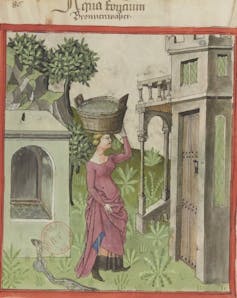
The majority of ladies who arrived from faraway regions arrived alone, suggesting medieval women were not always necessarily “stuck” at home under the domination of a father, brother, cousin, uncle or husband. Even if they wound up that way, they seemed to show some guts by leaving in the first place.
New Cities, New Lives
In cities like Avignon, with a large proportion of immigrants, long-lasting lineages disappeared. As historian Jacques Chiffoleau has suggested, most late medieval Avignonese were “orphans” who lacked extended family networks in their new surroundings – and this was reflected in the culture.
Since the 12th century, women in the south of France had been considered “sui iuris” – capable of managing their own legal affairs – if they were not under a father or husband’s control. They could dispose of their own possessions and distribute them at will, both before and after death. Married daughters’ dowries often prevented them from inheriting parents’ property, but they could when no male descendants could be found.
In the late Middle Ages, women’s legal rights expanded as urbanization and immigration changed social relationships. They could become legal guardians of their children. What’s more, judging by women’s testaments, widows and older daughters did make legal decisions of their own without the “required” male guardianship.

In addition, married women could make legally binding decisions as long as their husbands were present with them in front of a notary. Although husbands were technically considered their wives’ “guardians,” they could declare them legally free of guardianship. Wives would then be allowed to name their witnesses, appoint their universal heir and list donations and bequests to individuals and the church, which they hoped would save their soul.
Speaking Beyond The Grave
European archives literally overflow with legal documents that are awaiting discovery in musty boxes. What is lacking is a new generation of historians who can analyze them and paleographers who can read the handwriting.
Everyone high and low used notaries’ services for contractual forms, from an engagement and marriage to the sale of property, business transactions and donations. In this mass of documentation, wills provide a refreshing perspective into medieval women’s agency and emotions as they contemplated the end of their lives.
In the 60 or so women’s testaments kept in Avignon, women named where and with whom they wanted to be buried, often choosing their children or parents over their husbands. They named which charities, religious orders, hospitals for the poor, parishes and nunneries would benefit from their generosity, including bequests for repairs on Avignon’s famous bridge.
These women may have dictated their last wishes lying in bed, waiting for death, with the notary guiding their decisions. Still, given the things they dictated – donations for the dowries of poor girls, for their relatives and friends, to have their names remembered in Catholic Masses for the dead – I would argue that we are hearing their own voices.
Rosaries, Repairs And Furs
In 1354, Gassende Raynaud of Aix asked to be buried with her sister, Almuseta. She left a house to her friend Aysseline, while Douce Raynaud – who may have been another sister – received six dishes, six pitchers, two platters, a pewter jug, a cauldron, her best cooking pot, a cloak of fur with muslin, a big blanket, two large sheets, her best bodice, a little coffer, and all the mending thread and hemp that she possessed. She left a coffer, a copper warmer, the best trivet of the house and four new sheets to her friend Alasacia Boete.
Gassende’s generosity didn’t stop there. Jacobeta, Alasacia’s daughter, received a rosary of amber; Georgiana, Alasacia’s daughter-in-law, a bodice; and Marita, Alasacia’s granddaughter, a tunic. To her friend Alasacia Guillaume, Gassende left the unusual gift of a portable altar for prayers and an embroidered blanket. To Dulcie Marine, she bequeathed a choir book called an antiphonary and the best of her cloaks or furs.
In another Avignon will, written in 1317, Barthélemie Tortose made bequests to several Dominican friars, including her brother. She left funds to the prior of the order, her brother’s supervisor: perhaps rewarding the “boss” in order to keep her brother in his favor. She provided for charities and repairs for two bridges over the violent Rhône River, but also substantial support to provide food and clothing to all nuns’ convents of the city.

More especially, she supported her female kin, such as leaving rental income to her niece, a Benedictine nun. She then requested that her clothes be cut into habits for nuns and liturgical garments.
We can get a glimpse at just how personal these bequests were: These women assumed that what they had touched, or what had touched their skin, would also touch another’s. Most of all, they expected that their possessions would transmit their memory, their existence, their identity.
What’s more, medieval women could be pretty radical.
At least 10 women whose wills I’ve read asked to be buried in monks’ cassocks, including Guimona Rubastenqui. Widow of an Avignon fishmonger – usually a profitable occupation – she requested that Carmelite brother Johannes Aymerici give her one of his old habits, for which she paid him six florins.
Asserting Their Will
So, what do we make of all this?
It is impossible to completely reconstruct how people lived, loved and died centuries ago. I have spent my adult life thinking “medieval,” yet know I will never get there. But we certainly have clues – and what I call an educated intuition.
By modern standards, these women faced real limits on their power and independence. However, I have argued that they “freed” themselves at death – their wills presenting a rare opportunity to make personal legal decisions and to live on in written records.
Medieval women could have agency. Not all of them, not all the time. But this small sample shows that they could choose whom they wanted to reward and whom they could help.
As for the burial in men’s garb, I have no way of knowing whether their wishes were followed. But from my perspective, there is something extremely satisfying in knowing that at least they tried.![]()
Joelle Rollo-Koster, Professor of Medieval History, University of Rhode Island
This article is republished from The Conversation under a Creative Commons license. Read the original article.
How the Academy Awards became ‘the biggest international fashion show free-for-all’

The Oscars are no longer just a celebration of movies. They’ve also become a fashion show, with fans, designers and the media celebrating and critiquing Hollywood celebrities as they stroll, pause and pose on the red carpet of the annual awards ceremony.
A sharp look can be a story in and of itself.
Take actress Lupita Nyong’o. After she wore a powder blue Prada dress to the 2014 Oscars, she became the new “It girl” overnight. She was named People magazine’s Most Beautiful Woman, became the first Black ambassador for beauty giant Lancôme and landed on the covers of Vogue, Vanity Fair and Glamour.
But fashion wasn’t always so central to the ceremony.
In my book about the history of the Oscars red carpet, I point to two essential figures that turned the Oscars into the fashion spectacle we know today.
TV Puts The Oscars In The Spotlight
At the end of the 1940s, the Hollywood film industry was facing economic headwinds.
More and more households were buying television sets, which impacted movie-going. The studios also saw their revenues decline when they were forced to sell their theater chains after losing an antitrust case in 1948.
Financial struggles continued to mount when, in 1949, the motion picture companies refused to fund the Academy Awards after the Academy of Motion Picture Arts and Sciences, the organization that puts on the awards, allowed British films to compete head-to-head with American productions.
The organization found temporary solutions to keep the event going. But when faced with the possibility of discontinuing the Oscars ceremony altogether due to financial constraints, the academy weighed the advantages and disadvantages of airing the program on television, which was seen as film’s main competitor. Eventually, the academy approached NBC and requested that the network cover the expenses to put on the event in exchange for the rights to broadcast the show in 1953.
Until then, the studios had carefully crafted and controlled their stars’ public image. Television was a new medium – and a more spontaneous one. Studio executives feared how their stars would appear on screen and behave during the broadcast. Furthermore, many nominees were skeptical of appearing at the event since there was no stipulation in their contracts about television appearances.
Edith Head, Guardian Of Glamour
So the academy hired Edith Head as a fashion consultant to supervise the stars’ appearance.
At the time, Head was Hollywood’s most famous costume designer. She’d been working since the days of silent cinema, and she was accustomed to the media spotlight through her promotional work for Paramount.
Head was responsible for making sure that everyone dressed appropriately, abiding by the “decency and decorum” guidelines suggested by the Code of Practice for Television Broadcasters. She also had to ensure that no two dresses were the same and that the outfits worn by presenters and nominees looked good on camera and complemented the set.

One of her most important roles ended up being talking up fashion in media interviews leading up to the Oscars, which she frequently referred to as a fashion show.
“This is a very competitive night from a fashion point of view because, as I said, the stars are presenting themselves as themselves,” Head explained on one of her radio shows. “For me, as a fashion designer, the most exciting question is who will wear what.”
The postwar growth of the international fashion industry paved the way for Hollywood stars to wear the latest creations by European designers, including Christian Dior, Hubert de Givenchy and Pierre Balmain.
However, by the mid-1960s, new fashion trends such as miniskirts, shapeless dresses, pants and bohemian styles threatened to upend the formal attire of the Oscars and the feminine ideals preferred by Head.
In 1968, she felt compelled to remind young actresses of the event’s stature with a press release after actress Inger Stevens wore a mini dress to the ceremony in 1967. To Head, this was no informal social gathering; it was a glamorous, upscale fashion parade.
Two years later, in 1970, she reiterated the importance of formal attire while announcing the nominees for the Oscar for best costume design. She reminded young actresses that the Oscars was “the most important time of the year in Hollywood” and advised them to avoid wearing “the freaky, far-out, unusual fashions.”
Fred Hayman Rights The Ship
After Head said goodbye to her position at the conclusion of the 1971 ceremony, celebrities blew through the boundaries of decorum, inaugurating an era of questionable fashion choices: Edy Williams’ shocking bikini looks, Bob Mackie’s memorable transparencies for Cher and Armani’s over-the-top informality for Diane Keaton.

Fashion order was restored in 1989 when Beverly Hills impresario Fred Hayman became the event’s new fashion coordinator.
Lucky for him, in the 1990s, fashion was in fashion.
New successful designers such as Giorgio Armani, Thierry Mugler and Gianni Versace elbowed into the spotlight alongside established conglomerate brands like Louis Vuitton and Givenchy. Supermodels had become celebrities on par with actors and actresses, and cable television launched specialized international networks dedicated entirely to fashion and celebrity culture.
Hayman was eager to capitalize on this momentum to promote Rodeo Drive as the luxury shopping mecca of the West Coast.
Hayman had begun his career in the hospitality industry. But in 1961, he switched to fashion after investing in a friend’s boutique, Giorgio Beverly Hills. Hayman would eventually become the boutique’s sole owner. In 1989, the same year he joined the Oscars as fashion coordinator, he rebranded his store as Fred Hayman Beverly Hills after selling the Giorgio brand to cosmetics conglomerate Avon to commercialize his perfume line.
Giorgio Beverly Hills catered to the rich and famous by retailing garments from various designers and brands from Europe and New York City. As fashion coordinator of the Oscars, Hayman became the official go-to resource for what to wear to the event, attracting more celebrities, brands and media attention to Rodeo Drive.
Building off Head’s media strategy, Hayman introduced the fashion previews. These were runway shows for the press organized at the Samuel Goldwyn Theatre on Wilshire Boulevard to anticipate each year’s red-carpet trends.

Fashion at the Oscars took a giant leap forward with Hayman. Thanks to his efforts, the West Coast enhanced its fashion profile, prompting luxury brands to open flagship stores along Rodeo Drive.
He continued in his role for a decade until he was replaced by stylist L’Wren Scott for the ceremony in 2000.
Through their media savvy, Head and Hayman were able to recast the Academy Awards ceremony as a dazzling spectacle of glamour – what Head frequently described as “the biggest international fashion show free-for-all.”![]()
Elizabeth Castaldo Lundén, Fulbright Scholar and Sweden-America Foundation Research Fellow, University of Southern California
This article is republished from The Conversation under a Creative Commons license. Read the original article.
The Anthropocene is not an epoch − but the age of humans is most definitely underway

When people talk about the “Anthropocene,” they typically picture the vast impact human societies are having on the planet, from rapid declines in biodiversity to increases in Earth’s temperature by burning fossil fuels.
Such massive planetary changes did not begin all at once at any single place or time.
That’s why it was controversial when, after over a decade of study and debate, an international committee of scientists – the Anthropocene Working Group – proposed to mark the Anthropocene as an epoch in the geologic time scale starting precisely in 1952. The marker was radioactive fallout from hydrogen bomb tests.
On March 4, 2024, the commission responsible for recognizing time units within our most recent period of geologic time – the Subcommission on Quarternary Stratigraphy – rejected that proposal, with 12 of 18 members voting no. These are the scientists most expert at reconstructing Earth’s history from the evidence in rocks. They determined that adding an Anthropocene Epoch – and terminating the Holocene Epoch – was not supported by the standards used to define epochs.
To be clear, this vote has no bearing on the overwhelming evidence that human societies are indeed transforming this planet.
As an ecologist who studies global change, I served on the Anthropocene Working Group from its start in 2009 until 2023. I resigned because I was convinced that this proposal defined the Anthropocene so narrowly that it would damage broader scientific and public understanding.
By tying the start of the human age to such a recent and devastating event – nuclear fallout – this proposal risked sowing confusion about the deep history of how humans are transforming the Earth, from climate change and biodiversity losses to pollution by plastics and tropical deforestation.
The Original Idea Of The Anthropocene
In the years since the term Anthropocene was coined by Nobel Prize-winning atmospheric chemist Paul Crutzen in 2000, it has increasingly defined our times as an age of human-caused planetary transformation, from climate change to biodiversity loss, plastic pollution, megafires and much more.
Crutzen originally proposed that the Anthropocene began in the latter part of the 18th century, as a product of the Industrial age. He also noted that setting a more precise start date would be “arbitrary.”
According to geologists, we humans have been living in the Holocene Epoch for about 11,700 years, since the end of the last ice age.
Human societies began influencing Earth’s biodiversity and climate through agriculture thousands of years ago. These changes began to accelerate about five centuries ago with the colonial collision of the old and new worlds. And, as Crutzen noted, Earth’s climate really began to change with the increasing use of fossil fuels in the Industrial Revolution that began in the late 1700s.
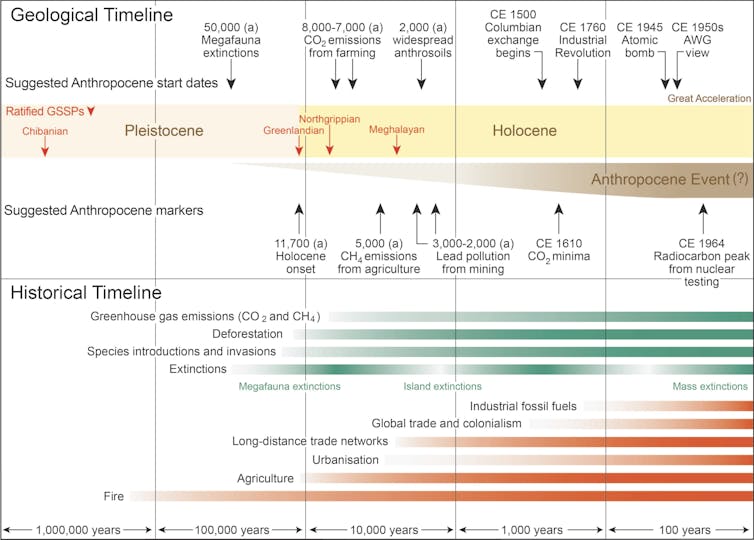
The Anthropocene As An Epoch
The rationale for proposing to define an Anthropocene Epoch starting around 1950 came from overwhelming evidence that many of the most consequential changes of the human age shifted upward dramatically about that time in a so-called “Great Acceleration” identified by climate scientist Will Steffen and others.
Radioisotopes like plutonium from hydrogen bomb tests conducted around this time left clear traces in soils, sediments, trees, corals and other potential geological records across the planet. The plutonium peak in the sediments of Crawford Lake in Ontario, Canada – chosen as the “golden spike” for determining the start of the Anthropocene Epoch – is well marked in the lake bed’s exceptionally clear sediment record.
The Anthropocene Epoch Is Dead; Long Live The Anthropocene
So why was the Anthropocene Epoch rejected? And what happens now?
The proposal to add an Anthropocene Epoch to the geological time scale was rejected for a variety of reasons, none of them related to the fact that human societies are changing this planet. In fact, the opposite is true.
If there is one main reason why geologists rejected this proposal, it is because its recent date and shallow depth are too narrow to encompass the deeper evidence of human-caused planetary change. As geologist Bill Ruddiman and others wrote in Science Magazine in 2015, “Does it really make sense to define the start of a human-dominated era millennia after most forests in arable regions had been cut for agriculture?”
Discussions of an Anthropocene Epoch aren’t over yet. But it is very unlikely that there will be an official Anthropocene Epoch declaration anytime soon.
The lack of a formal definition of an Anthropocene Epoch will not be a problem for science.
A scientific definition of the Anthropocene is already widely available in the form of the Anthropocene Event, which basically defines Anthropocene in simple geological terms as “a complex, transformative, and ongoing event analogous to the Great Oxidation Event and others in the geological record.”
So, despite the “no” vote on the Anthropocene Epoch, the Anthropocene will continue to be as useful as it has been for more than 20 years in stimulating discussions and research into the nature of human transformation of this planet.
This article was updated to clarify that a new attempt at an official Anthropocene Epoch declaration is unlikely soon.![]()
Erle C. Ellis, Professor of Geography and Environmental Systems, University of Maryland, Baltimore County
This article is republished from The Conversation under a Creative Commons license. Read the original article.
Early Hollywood was financed by Italian immigrants – as our new documentary shows

What do Charlie Chaplin, Walt Disney and Frank Capra have in common? The same Italian banker.
Early Hollywood movies have been widely studied and investigated. But surprisingly little is known about their financing, and how the contributions of low-income immigrants helped shape the Hollywood film industry – especially Italians.
Approximately 4 million people from disadvantaged backgrounds had arrived in the US via Ellis Island by 1920. They have often been portrayed in film as delinquents of New York’s Lower East Side. This stereotypical character assigned to Italians persisted for decades, and was revived by the popularity of mafia movies and TV shows such as The Sopranos.
These portrayals have progressively influenced public perceptions and attitudes toward Italian immigrants and their descendants. But in reality, early Italian immigrants were central to the establishment and growth of the American economy. One visionary financier, whose name is not (yet) as well known as it should be (and that our upcoming documentary research aims to spotlight) saw an opportunity to change the narrative.
AP Giannini
Amadeo Peter Giannini (1870-1949), commonly known as AP, was a popular figure in San Francisco. He was the son of Italian immigrants and the founder of the Bank of Italy, which he progressively grew into the Bank of America. Through this institution, Giannini contributed to the birth of projects such as the Golden Gate Bridge (1937), the 1948 Marshall Plan (in which the US provided western European countries with economic aid following the second world war). He was also an important player in the birth of Hollywood.
Sometimes known as the “people’s banker” or the “gentleman banker”, Giannini started out working in agriculture through his small family business. Having inherited some shares from his father-in-law in a small bank he was able to see that the system was constructed by and for the wealthy.

Giannini believed that immigrants chasing the American dream, like his own father and mother from Liguria, could be an important resource for the US. He believed that ethical banking would allow general social mobility, and with it the opportunity to finance young industries – such as cinema.
Giannini founded the Bank of Italy in 1904 as a small bank in San Francisco. There, minorities who were traditionally excluded from any form of financing, such as Italian, Chinese, Irish, Mexican and Portuguese people, could deposit their savings – no matter how modest. The bank was more than a place where to put your salary. It was an entry way into American institutions enabling such migrants to borrow money ethically, often on a handshake, and grow.
Not only did these deposits allow the migrant community to settle and flourish, but it meant that employment could be created by investing in immigrant businesses.
Changing The Game
The most promising of these businesses was the movie studio system. The Bank of Italy began to lend money to young filmmakers and producers in Hollywood. Many of these filmmakers didn’t qualify for business loans, but as Giannini believed in building not only an industry, but a community, the bank would extend personal loans.
Producer Sol Lesser, best known for his Tarzan movies, is a case in point. While still a minor, he received a private loan undersigned by Giannini himself to buy seats for his first Nickelodeon movie theatre. This was the beginning of his path towards becoming an influential producer.
Giannini’s little bank figured out the lending system that has since become the industry standard. As Warren Sherk of the Margaret Herrick Library at the Academy of Motion Pictures Arts and Sciences explains in our upcoming documentary AP Giannini: Bank to the future, banks initially used film negatives as collateral, believing they held value since they could be used to make sellable prints and therefore allow them to recover their investment were the producers unable to fulfil the loan payments. But this approach prevented filmmakers from accessing, printing and distributing their own films.
As a solution, Giannini instead came up with a new protocol for film loans where the bank would secure the rights and distribution income of two films that had already been produced as security for the loan of the film financed by the bank. He also began what is now known as “attachment” – the practice of having a star attached to a film in order to secure ticket sales
With this new financing model, the bank’s risk was minimised, the filmmakers were able to meet the conditions and the Hollywood industry thrived. Classics such as The Tramp (1915), Snow White and the Seven Dwarfs (1937) and Gone With the Wind (1939) were financed through Giannini. Filmmakers including Charlie Chaplin, Frank Capra, Walt Disney and Alfred Hitchcock, and organisations such as United Artists and even the Academy itself were backed by Giannini’s revolutionary vision.
The transparency of Giannini’s bank was central to his success and saved it during some of the most challenging financial times of the 20th century. Its stability was nourished by the constant influx of immigrant money, deposited by those yearning to become respected American citizens with a bank account, a privilege that was extended to women in 1920 when Bank of Italy opened the first women’s department in the country.
So much so that, as Sherk explains, it was immigrants’ nickels and dimes, deposited in Bank of Italy and Bank of America, that funded the early Hollywood film industry.

Looking for something good? Cut through the noise with a carefully curated selection of the latest releases, live events and exhibitions, straight to your inbox every fortnight, on Fridays. Sign up here.![]()
Valentina Signorelli, Associate Professor in Film and TV, University of Greenwich and Cecilia Zoppelletto, Visiting lecturer in film studies, University of Westminster
This article is republished from The Conversation under a Creative Commons license. Read the original article.
Kylian Mbappé has trademarked his iconic goal celebration – why a pose can form part of a player’s protected brand

French football superstar Kylian Mbappé celebrates most of his goals by crossing his arms and tucking his hands underneath his armpits. It has become one of the most iconic goal celebrations in the world.
Mbappé, who is due to move to Spanish giants Real Madrid at the end of this season, has already taken steps to register a logo depicting his celebration as a trademark in several countries, as well as in the European Union. He has done the same for his surname, initials and most famous quotes.
The black-and-white logo depicts a smiling Mbappé, celebrating in his usual fashion.
Mbappé is not the only famous athlete who has looked to secure exclusive rights to their signature celebration. In 2022, Jamaican sprinter Usain Bolt applied to trademark a logo in the US showing his victory celebration pose – an application with the US trademark office that is still pending.
The reason well-known athletes look to trademark these poses, and other aspects of their image, is obvious. They wish to turn them into successful brands that can be used commercially in a wide range of markets.
Among the products covered by Mbappé’s trademark registrations are clothes, textiles, footwear, toys, video games, umbrellas, bags, jewellery, perfumery, cosmetics and toothpastes. Any products or brands that wish to use his specific logo, name or quotes will need to pay Mbappé or be granted permission by Mbappé himself.
But how can even the celebratory pose of a sporting star become a brand? To answer this question, we need to look at the nature and function of trademarks.
What Trademark Law Says
A trademark is used in the course of trade to distinguish the goods and services of a company from those of competitors. The key, though not only, function is to indicate the commercial origin of a product.
Logos representing a famous athlete’s iconic pose may satisfy this requirement. Such postures can create a stronger association between the player and the products to which their image is affixed, offering a more distinctive characterisation compared with a traditional portrait-style image. Such branding allows consumers to distinguish the products from the goods sold by others, effectively functioning as an indication of commercial source.
For example, if we see a toy, blanket, birthday card or poster in a shop that features Mbappé’s trademarked celebration logo (or any other trademarks incorporating his image, name and initials), we will probably think those products are marketed by Mbappé himself.
So, if a business sells such branded goods without his authorisation, it will probably be a trademark infringement. This is because consumers would buy the product in the erroneous belief that they are official Mbappé merchandise.
Mbappé is a sports icon with hundreds of millions of fans and followers, including 112 million on Instagram. Thus, his trademarks may soon become notorious to a large range of consumers, especially if he ramps up the manufacture, sale and promotion of a variety of products bearing his brand. Owners of famous brands have a higher chance of prevailing in trademark infringement cases.
It would then be enough for Mbappé to show that a business which has sold a replica product incorporating his pose wants to take unfair advantage of the reputation of such a trademark. The same outcome would materialise if he could show that such a product is detrimental to his brand – for example, if the replica product bearing his brand is of poor quality.
Other celebrities have done the same. In 2016, Australian popstar Kylie Minogue started a battle with TV personality Kylie Jenner over the trademarking of their shared first name. Minogue claimed that her Kylie brand would be tarnished if Jenner were allowed to register an identical or similar trademark, describing her as a “secondary reality TV personality”.

Protecting Free Speech
But there are also downsides to a trademark protection strategy based on the registration of every aspect of an athlete’s image and personality. It may limit the freedom of the public – and especially sports fans – to celebrate or criticise their icons.
Take, for instance, a website dedicated to Mbappé that serves as a forum where fans can exchange opinions about the player’s sporting performance and marketing activities. And let’s imagine that the website’s homepage features Mbappé’s trademarked celebration pose, his name or a famous quote prominently, and hosts fan commentaries that are highly critical of any of his activities.
Mbappé could, in theory, enforce his trademark rights to stop what he may consider a use of his trademark that tarnishes or even takes advantage of its reputation. This would be even more applicable if the website hosts advertising banners and sponsored sections, as Mbappé could claim that his brands are being somewhat exploited commercially.
But such an enforcement would unduly restrict the right of football fans to free speech. It would also unjustifiably allow trademark owners to stop their brands being used for purposes that are not strictly commercial. We should all be entitled to celebrate or criticise our favourite players by posting commentaries about their behaviour on and off the pitch, and including their iconic pose.
Mbappé’s trademark protection strategy is certainly legitimate and in line with the current branding trends of most celebrities. But the French football star would be better advised not to enforce his trademarks against whoever simply expresses opinions and ideas about him without a strict economic purpose.
The risk is not only to lose the legal case, but also alienate fans who may end up disappointed about their idol’s willingness to be overly litigious.![]()
Enrico Bonadio, Reader in Intellectual Property Law, City, University of London and Andrea Zappalaglio, Lecturer in Intellectual Property Law, University of Sheffield
This article is republished from The Conversation under a Creative Commons license. Read the original article.
Jupiter’s moon Europa produces less oxygen than we thought – it may affect our chances of finding life there
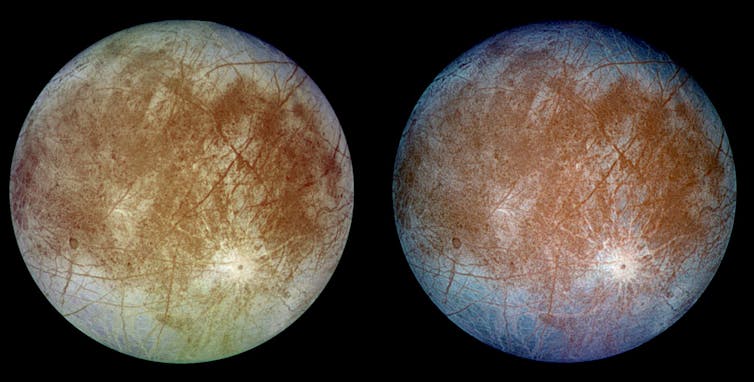
Jupiter’s icy moon Europa has long been thought of as one of the most habitable worlds in the Solar System. Now the Juno mission to Jupiter has directly sampled its atmosphere in detail for the first time. The results, published in Nature Astronomy, show that Europa’s icy surface produces less oxygen than we thought.
There are plenty of reasons to be excited about the possibility of finding microbial life on Europa. Evidence from the Galileo mission has shown that the moon has an ocean below its icy surface containing about twice the amount of water as Earth’s oceans. Also, models derived from Europa data show that its ocean floor is in contact with rock, enabling chemical water-rock interactions that produce energy, making it the prime candidate for life.
Telescope observations, meanwhile, reveal a weak, oxygen-rich atmosphere. It also looks as though plumes of water erupt intermittently from the ocean. And there is some evidence of the presence of basic chemical elements on the surface – including carbon, hydrogen, nitrogen, oxygen, phosphorus and sulphur – used by life on Earth. Some of these could seep down into the water from the atmosphere and surface.
The heating of Europa and its ocean is partly thanks to the moon’s orbit around Jupiter, which produces tidal forces to heat an otherwise frigid environment.
Although Europa boasts three basic ingredients for life – water, the right chemical elements and a source of heat – we don’t yet know if there has been enough time for life to develop.

The other prime candidate in our solar system is Mars, the Rosalind Franklin rover’s target in 2028. Life might have started on Mars at the same time as it did on Earth, but then probably stopped due to climate change.
A third candidate is Saturn’s moon Enceladus where the Cassini-Huygens mission discovered plumes of water from a sub-surface salty ocean, also in contact with rock at the ocean’s floor.
Titan is the closest runner up in fourth place, with its thick atmosphere of organic compounds including hydrocarbon and tholins, born in the high atmosphere. These then float down to the surface coating it with ingredients for life.
Losing Oxygen
The Juno mission boasts the best charged particle instruments sent to Jupiter so far. It can measure the energy, direction and composition of charged particles on the surface. Similar instruments at Saturn and Titan found tholins (a type of organic substance) there. But they also measured particles that suggested atmospheres at Saturn’s moons Rhea and Dione, in addition to those at Titan and Enceladus.
These particles are known as pickup ions. Planetary atmospheres consist of neutral particles, but the top of an atmosphere becomes “ionised” (meaning it loses electrons) in sunlight and via collisions with other particles, forming ions (charged atoms that have lost electrons) and free electrons.
When a plasma – a charged gas making up the fourth state of matter beyond solid, liquid and gas – flows past an atmosphere with newly formed ions, it disturbs the atmosphere with electric fields which can accelerate the new ions – the first part of an ion pickup process.
These pickup ions then spiral around the planet’s magnetic field and are usually lost from the atmosphere, while some hit the surface and are absorbed. The pickup process has rid the Martian atmosphere of particles after the red planet’s magnetic field was lost 3.8 billion years ago.
Europa also has a pickup process. The new measurements show the telltale signs of pickup molecular oxygen and hydrogen ions from the surface and atmosphere. Some of these escape from Europa, whereas some hit the icy surface enhancing the amount of oxygen at and under the surface.
This confirms that oxygen and hydrogen are indeed the main constituents of Europa’s atmosphere – in agreement with remote observations. However, the measurements imply that the amount of oxygen being produced – released by the surface to the atmosphere – is only about 12kg per second, at the lower end of earlier estimates from about 5kg to 1,100 kg per second.
This would indicate that the surface suffers very little erosion. The measurements indicate that this may amount to only 1.5cm of Europa’s surface per million years, which is less than we had thought. So Europa is constantly losing oxygen due to pickup processes, with only a small amount of additional oxygen being released from the surface to replenish it and ending up back on the surface.
So what does that mean for its chances of hosting life? Some of the oxygen trapped in the surface may find its way to the subsurface ocean to nourish any life there. But based on the study’s estimate of the overall loss of oxygen, this should be less than the 0.3kg-300kg per second estimated earlier.
It remains to be seen whether this rate, recorded on 29, September 2022, is usual. Perhaps it is not representative of the overall oxygen on the moon. It may be that the eruption of plumes, orbital position and upstream conditions increase and decrease the rate at certain times, respectively.
Nasa’s Europa Clipper mission, to be launched later this year, and the Juice mission which will make two flybys of Europa on its way to orbit Ganymede, will be able to follow up these measurements, and provide much more information on Europa’s habitability.![]()
Andrew Coates, Professor of Physics, Deputy Director (Solar System) at the Mullard Space Science Laboratory, UCL
This article is republished from The Conversation under a Creative Commons license. Read the original article.
Bundanon’s Tales of Land & Sea: three exhibitions working in harmony to discuss loss, migration and colonisation
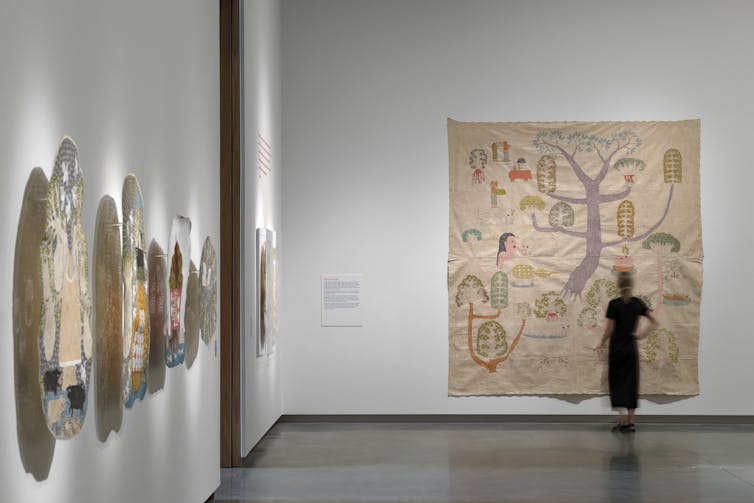
A bit over 30 years ago, I met Arthur Boyd, and we talked about art. At the time the Art Gallery of NSW was preparing a huge retrospective exhibition of his life’s work. It was not uncommon for curators and art dealers to call him a “genius”. His response to this adulation was acute embarrassment.
He described his artistic career as “selfish” and saw his own art as ephemeral. The true value of his contribution to Australia, to the world, he said, was in the gift of the 1,000 hectares named Bundanon he and his wife Yvonne were donating to the people of Australia. The Boyds were determined no developer would turn this earthly paradise into real estate.
Arthur Boyd understood the tragedy of loss of place. In the 1960s the much loved Boyd family home, The Grange, Harkaway, had been demolished to become a quarry. His art – and that of generations of his family – had been nourished by its pastoral beauty, which was turned to rubble. Bundanon has been created in the spirit of The Grange, a place for artists and others to create and perform, surrounded by pastoral beauty.
The three separate exhibitions that come together in Tales of Land & Sea, speak to Boyd’s sense of justice, his desire to break down barriers between class and cultures, and his deep love of the ancient myths that still speak to humanity.
An Exquisite Exhibition
The year Arthur and Yvonne Boyd gave Bundanon to the Australian people, 1993, was also the year Arthur Boyd collaborated with a young Indonesian art student, Indra Diegan, on a visual retelling of one of the great West Javanese myths, Sankuriang.
It is a tale of gods who become animals, of love and jealousy, of incest and guilt.

Boyd had been introduced to collotypes, a photographic mode of printmaking, by Diegan’s father some years before, and collaborating on her honours project was a natural outcome of the friendship.
Their final outcome was a book, whose beauty lies in this collaboration. Boyd’s intense, passionate prints work in harmony to create a visual conversation with Diegan’s delicate woodcuts. Only 12 copies were printed. The three in the Bundanon collection form the core of this small, exquisite exhibition.
Of Life And Death
In the adjoining large gallery is ayang-ayang, showing the work of the artist Jumaadi. Echoes in the form of shadows are at the heart of the exhibition.
In both Indonesia and Australia, colonisation led to mass displacement, exploitation and death. Jumaadi’s paintings draw both on the visual iconography and materials from traditional folk art, a connection emphasised by a separate display of historical Javanese artefacts, including exquisitely carved elaborate hair pieces displayed to throw deep shadows on the gallery wall.

The main exhibition space is dominated by a screening of a performance of wayang Kulit, Indonesian shadow puppetry.
In The Sea is Still a Mystery, a fisherman first catches an abundance of fish, but then his line draws up a bizarre array of sea creatures, a wrecked ship, strange objects (including old beds and a wedding dress) body parts, plants, ships carrying sheep and a head that looks like Captain Cook. The sea may give us life, but it is also the home of the dead.
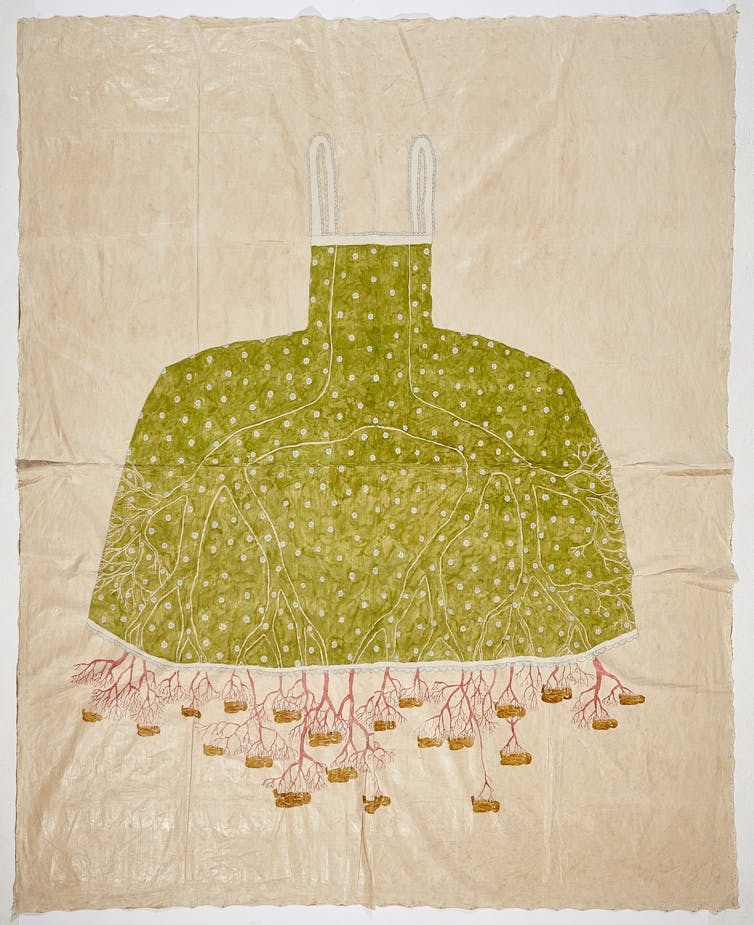
Some of the subjects and themes in the wayang kulit are repeated and expanded in the paintings and buffalo hide pieces that fill the gallery. These include a series of large works he made during the COVID lockdown. Lovers are shown together, or separated by migration. A large wedding dress has many embryos growing at its base. The artist flies under the wing of a plane across the volcanic islands.
As an artist he can fly free, but the confined passengers may well be indentured labour, facing an uncertain future.
Of Labour And Loss
The third exhibition, Sancintya Mohini Simpson’s par-parā / phus-phusā (“to speak incessantly / to whisper”) is an exploration of the legacy of the artist’s maternal ancestors who were Indian indentured labourers, gulled into travelling to South Africa to work on the sugar fields.
Simpson makes the point that the great 19th century migration of Indians to the sugar fields of Africa, Fiji and the West Indies was hardly voluntary. The colonial powers saw them as a substitute for the recently freed slaves, and treated them accordingly.
The main installation, Vessel (4) consists of mounds of earth from Bundanon, scattered with ash from caramel-smelling sugar cane. These hold a series of earthenware lotas, vessels used in sacred ceremonies, smeared with sugar cane ash to make them a dull grey.

This is the site for a sound installation piece Simpson performs with her sibling, Isha Ram Das. The lotas vibrate with an amplified sound when gently tapped by both artists in an echoing rhythm.
Their art speaks of labour and loss, of salt for the sea that divided the people from their homelands, and for the tears they shed when they realised they could never return.
As I was looking at the three exhibitions, by artists whose connections to Australia are via different parts of Asia, I thought of Arthur Boyd, and the way his family were also in transit between Australia and England. He knew, as they know, the yearning for the other, the distant ancestral land.
The Boyds’ vision of Bundanon has been fulfilled. Not only has the land been preserved and nourished, but at its heart there is a hub, a meeting place where artists in transit can stop, consider, and create. ![]()
Joanna Mendelssohn, Honorary (Senior Fellow) School of Culture and Communication University of Melbourne. Editor in Chief, Design and Art of Australia Online, The University of Melbourne
This article is republished from The Conversation under a Creative Commons license. Read the original article.
What is a GPU? An expert explains the chips powering the AI boom, and why they’re worth trillions

As the world rushes to make use of the latest wave of AI technologies, one piece of high-tech hardware has become a surprisingly hot commodity: the graphics processing unit, or GPU.
A top-of-the-line GPU can sell for tens of thousands of dollars, and leading manufacturer NVIDIA has seen its market valuation soar past US$2 trillion as demand for its products surges.
GPUs aren’t just high-end AI products, either. There are less powerful GPUs in phones, laptops and gaming consoles, too.
By now you’re probably wondering: what is a GPU, really? And what makes them so special?
What Is A GPU?
GPUs were originally designed primarily to quickly generate and display complex 3D scenes and objects, such as those involved in video games and computer-aided design software. Modern GPUs also handle tasks such as decompressing video streams.
The “brain” of most computers is a chip called a central processing unit (CPU). CPUs can be used to generate graphical scenes and decompress videos, but they are typically far slower and less efficient on these tasks compared to GPUs. CPUs are better suited for general computation tasks, such as word processing and browsing web pages.
How Are GPUs Different From CPUs?
A typical modern CPU is made up of between 8 and 16 “cores”, each of which can process complex tasks in a sequential manner.
GPUs, on the other hand, have thousands of relatively small cores, which are designed to all work at the same time (“in parallel”) to achieve fast overall processing. This makes them well suited for tasks that require a large number of simple operations which can be done at the same time, rather than one after another.
Traditional GPUs come in two main flavours.
First, there are standalone chips, which often come in add-on cards for large desktop computers. Second are GPUs combined with a CPU in the same chip package, which are often found in laptops and game consoles such as the PlayStation 5. In both cases, the CPU controls what the GPU does.
Why Are GPUs So Useful For AI?
It turns out GPUs can be repurposed to do more than generate graphical scenes.
Many of the machine learning techniques behind artificial intelligence (AI), such as deep neural networks, rely heavily on various forms of “matrix multiplication”.
This is a mathematical operation where very large sets of numbers are multiplied and summed together. These operations are well suited to parallel processing, and hence can be performed very quickly by GPUs.
What’s Next For GPUs?
The number-crunching prowess of GPUs is steadily increasing, due to the rise in the number of cores and their operating speeds. These improvements are primarily driven by improvements in chip manufacturing by companies such as TSMC in Taiwan.
The size of individual transistors – the basic components of any computer chip – is decreasing, allowing more transistors to be placed in the same amount of physical space.
However, that is not the entire story. While traditional GPUs are useful for AI-related computation tasks, they are not optimal.
Just as GPUs were originally designed to accelerate computers by providing specialised processing for graphics, there are accelerators that are designed to speed up machine learning tasks. These accelerators are often referred to as “data centre GPUs”.
Some of the most popular accelerators, made by companies such as AMD and NVIDIA, started out as traditional GPUs. Over time, their designs evolved to better handle various machine learning tasks, for example by supporting the more efficient “brain float” number format.

Other accelerators, such as Google’s Tensor Processing Units and Tenstorrent’s Tensix Cores, were designed from the ground up for speeding up deep neural networks.
Data centre GPUs and other AI accelerators typically come with significantly more memory than traditional GPU add-on cards, which is crucial for training large AI models. The larger the AI model, the more capable and accurate it is.
To further speed up training and handle even larger AI models, such as ChatGPT, many data centre GPUs can be pooled together to form a supercomputer. This requires more complex software in order to properly harness the available number crunching power. Another approach is to create a single very large accelerator, such as the “wafer-scale processor” produced by Cerebras.
Are Specialised Chips The Future?
CPUs have not been standing still either. Recent CPUs from AMD and Intel have built-in low-level instructions that speed up the number-crunching required by deep neural networks. This additional functionality mainly helps with “inference” tasks – that is, using AI models that have already been developed elsewhere.
To train the AI models in the first place, large GPU-like accelerators are still needed.
It is possible to create ever more specialised accelerators for specific machine learning algorithms. Recently, for example, a company called Groq has produced a “language processing unit” (LPU) specifically designed for running large language models along the lines of ChatGPT.
However, creating these specialised processors takes considerable engineering resources. History shows the usage and popularity of any given machine learning algorithm tends to peak and then wane – so expensive specialised hardware may become quickly outdated.
For the average consumer, however, that’s unlikely to be a problem. The GPUs and other chips in the products you use are likely to keep quietly getting faster.![]()
Conrad Sanderson, Research Scientist & Team Leader, CSIRO
This article is republished from The Conversation under a Creative Commons license. Read the original article.
From micro to macro, Andrew Leigh’s accessible history covers the economic essentials
John Quiggin, The University of QueenslandAndrew Leigh’s The Shortest History of Economics is the latest in a series of such histories, mostly focused on particular countries.
It begins with a striking mini-history of household lighting, focusing on the amount of labour required to produce the light now given off by a standard lightbulb: 58 hours for a wood fire, five hours for a candle based on animal fat, a few minutes for an early electric lightbulb, and less than one second for a modern light-emitting diode.
The Shortest History of Economics – Andrew Leigh (Black Inc.)
Importantly, what is true of labour hours is also true of material inputs. Older technologies required felling a tree or killing an animal, but an LED uses the photoelectric properties of common crystals. It only needs tiny quantities. The input of electricity is similarly modest.
Meanwhile, because workers in all kinds of activities have become more productive, the purchasing power of their wages, expressed in terms of services like lighting, has risen. The result is that services like lighting have become exceptionally cheap.
As this example shows, The Shortest History of Economics is not, as might be supposed, a history of economic thought (a topic primarily suited to retired economists like the author of this review). Rather, it is primarily a history of economic life, from Paleolithic times to the COVID pandemic.
The history is, however, informed by modern economics, included in the narrative in palatable doses.
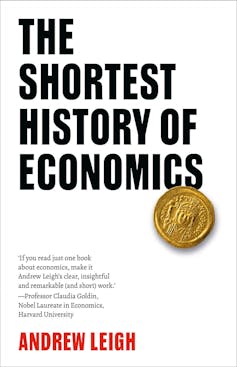
Standards Of Living
The first half of the book, covering the period up to the Industrial Revolution, is mostly about technology. Leigh begins with the transition from hunter-gatherer societies – made up of relatively small groups of people, who followed their food sources around – to agriculture, which permitted and required larger settled populations.
The effect on living standards was ambiguous at best. Farmers were less likely than hunter-gatherers to suffer violent deaths or starve in winter, but they were almost permanently undernourished. They overworked to produce a surplus that enabled a small stratum of priests and warriors to live relatively luxurious lives.
The millennia following the agricultural revolution are covered pretty quickly, with a focus on developments in transport (mostly water transport) and trade. Leigh traces the gradual emergence of a global economy, culminating in the rise of European empires, whose reach depended on sail.
There are lots of interesting vignettes, covering topics such as social mobility. There wasn’t much, as can be seen by the persistence over centuries of the same surnames in high-status positions. More depressing is the discussion of the central role of the slave trade, which was a major source of labour in the Americas and income for European nations.
The second half of the book, covering the period after the Industrial Revolution, shifts the focus from technology to economic institutions and policy. The 19th century saw the rise of the corporation and the concentration of economic power.
This produced responses in the form of “anti-trust” legislation in the United States, usually referred to as “competition policy” in Australia. This remains an issue of central concern to Leigh in his day job, as assistant minister for Competition, Charities and Treasury.
The 19th century also saw the rise of the trade union movement and the beginning of an era of continuous struggle over the distribution of income between capital labour. The balance has ebbed and flowed.
As Leigh shows, labour has been losing ground since the 1970s in most countries, while those at the top of the income distribution have gained massively. The offsetting positive development is that the very poorest people in the world have generally improved their lot, thanks to the belated arrival of modern technology.
Macroeconomics
The issues I have discussed so far have mostly concerned markets and prices, the topics studied by economists under the label “microeconomics”. But the 20th century also saw the emergence of “macroeconomics”, the analysis of booms, depressions, inflation and mass unemployment.
The key figure here was English economist John Maynard Keynes, whose General Theory of Employment, Interest and Money (1935) provided the theoretical basis for the use of public expenditure and taxation (fiscal policy) to stabilise the economy.
As Leigh notes in his introduction, The Shortest History of Economics is unusual among recent popular works on economics in covering both microeconomics and macroeconomics.
Despite proceeding briskly through millennia of economic history, Leigh manages to convey the essential points in a way that does not leave the reader feeling rushed through an incomplete argument. While it makes sense to begin by reading the book from beginning to end, it is also enjoyable to dip into it, more or less at random.
Inevitably, I have some points of disagreement. At a couple of points, Leigh gives uncritical credence to beliefs widely held among economists, but not supported by the evidence.
He repeats Adam Smith’s creation story for money as a more efficient alternative to barter. But a hundred years of anthropological evidence, beginning with my namesake Alison Hingston Quiggin and continuing to the work of the late David Graeber, suggests that money first emerged as a way of discharging debts (owed to the king whose face appeared on coins or as recompense for private injuries). It was only later adapted to use in commerce.
In his discussion of Keynesian macroeconomics, Leigh cites a popular rap video presenting a dispute between Keynes and Friedrich von Hayek, two of the great economists of the 20th century.
But in reality, although Hayek had criticised Keynes’ earlier Tract on Monetary Reform (1923), he did not even review his General Theory of Employment, Interest and Money. Arguably the most effective critic was A.C. Pigou, best known nowadays as the inventor of pollution taxes.
And Keynes was quite sympathetic to the arguments against economic planning Hayek presented in The Road to Serfdom (1944).
The idea of Hayek as Keynes’ primary antagonist is largely a piece of retroactive continuity (“retconning” in the jargon of genre fiction). The myth was created in the 1970s, following Hayek’s Nobel Prize in Economics in 1974 and his influence on political leaders, including Margaret Thatcher and Augusto Pinochet.
But these are quibbles, which will be of little concern to the general readership at which the book is aimed. As with all of the dozen or so books Leigh has produced since his election to Parliament (while also raising three children and maintaining a strenuous athletic regime – how does he do it?), The Shortest History of Economics is an engaging read, conveying economic insights to readers who would find a standard economics text both boring and impenetrable.![]()
John Quiggin, Professor, School of Economics, The University of Queensland
This article is republished from The Conversation under a Creative Commons license. Read the original article.
Bradley Cooper, Cillian Murphy and the myths of Method acting

Should actors and actresses who go to extremes to prepare for their roles get more love from Oscars voters?
This year, best actor nominees Cillian Murphy, who played nuclear physicist J. Robert Oppenheimer in “Oppenheimer,” and Bradley Cooper, who starred as Leonard Bernstein in the biopic “Maestro,” are getting lots of buzz not only for their performances but also for how those performances were achieved.
The already slim Murphy lost roughly 20 pounds and took up smoking fake cigarettes to mimic the look and habits of the real-life Oppenheimer. His preparation for the role was purportedly so intense that he isolated himself from his co-stars during the making of the film.
Meanwhile, Cooper allegedly spent six years training in the art of conducting in order to film a key sequence for “Maestro.” And on a December 2023 episode of the podcast “SmartLess,” best actress nominee Carey Mulligan recounted how Bradley Cooper called her on the phone and spoke to her in Leonard Bernstein’s voice years before they had begun filming “Maestro.”
Reporting on the actors’ preparation often references Method acting, a psychological approach to performing that’s designed to make the character seem more real and believable.
But as someone who has taught theater for over 20 years, I’ve found that much of what is said or written about Method acting perpetuates a number of myths about the technique. Sometimes, it can be tough to tell whether actors are genuinely preparing for a role or simply “performing” their preparation for their co-stars, the media and the public.
The Origins Of ‘The Method’
Method acting – sometimes called “the Method” – derives from “the system,” an approach to acting developed by Russian actor and director Konstantin Stanislavski, which he describes in the 1936 book “An Actor Prepares.”

Stanislavski asks actors to identify the forces that motivate and drive their characters. In doing so, the actor strives to be in the moment with their fellow actors, responding as their character would to imaginary circumstances.
Marlon Brando brought mainstream awareness to Method acting. To prepare for his role in “The Men,” in which he plays a paralyzed war veteran, Brando reportedly spent time in a veterans hospital using a wheelchair and did not initially reveal to the other patients that he was not disabled. He also reportedly stayed in his wheelchair between takes while filming.
In the decades since, Method acting has become associated with actors losing themselves in their characters, such as Daniel Day-Lewis having people spoon-feed him in order to prepare for his role as a painter with cerebral palsy in “My Left Foot” (1989).
This Is The New Me!
Despite all of the attention these stories get, some of the extremes actors go to would have likely made Stanislavski laugh.
“An Actor Prepares” is built around a fictional acting class in which a teacher – most likely a stand-in for Stanislavski himself – breaks his actors’ bad habits and teaches them the foundations of the system.
Many of the exercises the teacher designs are to help the actors imagine what they might do if they were in the same situation as their characters – not to recreate those circumstances in real life.
Along the way, Stanislavski’s acting teacher regularly lampoons actors going to phony extremes to achieve what they think is authenticity.
Not unlike the ethically questionable issues of Brando and Day-Lewis appropriating disability, one of the actor characters in Stanislavski’s book adopts mind-bogglingly racist approaches, including blackface, as he prepares to play Othello.
Decades later, there are echoes of this critique in the work of Robert Downey Jr., who wore blackface in an irony-drenched but nonetheless problematic sendup of Method acting in “Tropic Thunder” (2008).
Does This Character Make Me Look Fat?
Much of the debate around last year’s best actor winner, Brendan Fraser, had to do with his wearing prosthetics to play the morbidly obese Charlie in “The Whale.”
It should be noted that Cillian Murphy denies that he is a Method actor – as does Day-Lewis – and Murphy has refused to disclose the weight loss tactics he used to shed pounds for his role in “Oppenheimer.” Yet one of his co-stars, Emily Blunt, semi-jokingly referred to Murphy as eating an almond a day to maintain his underweight physique during filming.
What any actor does with their body is between them and their doctors; however, there are major medical and ethical implications when weight loss and weight gain are marked as evidence of a disciplined commitment to one’s craft.
Stanislavski didn’t tell actors to bulk up or go on a crash diet for their roles; in fact, early in “An Actor Prepares,” the acting teacher admonishes his students for practicing in front of mirrors and being too focused on their outward appearance. Later in the book, the teacher also warns against what he calls an exhibitionistic approach to acting, in which the actor is trying to show the audience how hard they are working at their craft.
Come At Me, Bro
And then there are stories of actors who prod, tease and surprise their co-stars to try to elicit authentic responses.
During the height of the #MeToo movement, a story about the filming of “Kramer vs. Kramer” (1979) resurfaced. Meryl Streep recalled that co-star Dustin Hoffman slapped her before shooting one of their scenes in order to get a response from her. Those actions were allegedly part of a larger pattern of behavior and strained relations between the two during the making of the film.
Similarly, when “Suicide Squad” (2016) was being filmed, Jared Leto reportedly sent gag gifts to his co-stars from his character, The Joker, that included dead animals and used condoms. Leto has alternately endorsed and walked back the stories about the pranks.
Contrast these stunts with Stanislavski’s take on working with acting partners: Create communion and engage in active listening. Ticking them off, whether it’s in service of a scene or part of their own technique of “staying in character,” is selfish.
Is It Process Or Privilege?
Since Stanislavski’s book was published, a number of acting approaches have emerged that do favor the kind of personal psychological investment that seems to blur the line between actor and character, most notably those of American acting teacher and theater director Lee Strasberg.
However, in Chapter 8 of “An Actor Prepares,” Stanislavski makes a clear distinction between what’s true and real for the actor and what’s true and real for the character they are playing.
In other words, he did not subscribe to the idea that an actor can lose themselves in their part.
Yes, the media loves these kinds of stories, and they can demonstrate a certain type of commitment. But they can also paint actors as pampered and pretentious “artistes” whose process is self-indulgent. A working actor struggling to pay the bills doesn’t have the luxury of, say, insisting that everyone address them by their character’s name.
In fact, these narratives about Method acting can swing the other way: Much of the praise around Ryan Gosling’s turn in “Barbie” plays on the idea of a serious actor’s willingness to get blond, goofy and take a decidedly un-Methody approach, something the actor cheekily embraced while doing press for the film.
So when the acting Oscars get handed out, hopefully it will be because voters believed in the performances – not because of some meta narrative about their off-screen behavior.![]()
Scott Malia, Associate Professor of Theatre, College of the Holy Cross
This article is republished from The Conversation under a Creative Commons license. Read the original article.
Bagpipes in space: how Hans Zimmer created the dramatic sound world of the new Dune film
Alison Cole, University of SydneyIndustrial. Mechanical. Brutal. These are the words acclaimed electro-acoustic composer Hans Zimmer uses to describe his music for Dune: Part Two, released in Australia on Thursday.
Dune: Part One (2021) showcased Zimmer’s expertise in manipulating sound to create timbres that uniquely fit an onscreen environment. The new film is no exception.
By carefully considering the Dune universe and drawing on a range of audio production and editing techniques, Zimmer creates a rich score that breathes life into author Frank Herbert’s fantasy world.
Creating A Rich, Textured Sound World
Zimmer looks to the film’s visual world – such as the costume colour palette, or the way the cinematographer shoots the film – to inform his sound and instrument choices.
“It starts off with creating that sonic world that I want the tunes or the motifs to live in,” Zimmer said in an interview.
He uses several tools to achieve this, drawing on plugins and audio editing tools to fragment, granulate, stretch, shorten, reverse, repeat and feature certain parts of a sound’s frequency range. He also processes distinct sounds such as metallic scrapes, or sand falling into a metal bowl.
The result is a unique soundscape in keeping with the war-footing narrative at the heart of the film. The militaristic feel of the score is created through the use of deep drums and percussion, repetitive (and at times delicate) vocals and ominous synthesisers that range from warm tones to uncomfortable screeching metallic tonalities.
All combine to draw the viewer into both a deep human narrative and the treacherous environment in which the tensions play out.
Unrelenting And Otherworldly
Zimmer is very familiar with processing sound to design unique sound worlds – an approach that stems from his lifelong fascination with electronic music. For Dune: Part Two, he composes a sonic landscape that feels as unrelenting as the planet Arrakis itself.
There are several familiar components, such as synthesised real-world elements, vocals and a repeat of melodies used in the first film. Both Paul’s and the Kwisatz Haderach melodies are repeated, as is the House Atreides theme.
In the track Eclipse – which repeats elements of the Holy War cue – ominous deep brass, deep percussion, unnerving vocals and synthesisers work to create a sinister mood.
Added on is an evocative blend of bagpipes, synthesisers and processed sounds invoking an otherworldly atmosphere. Combined with soloist Loire Cotler’s ethereal vocals, these disparate musical elements intertwine to build a memorable ambience.
The lines are blurred between the soundtrack and the film’s sound design to create moments of building tension. For the viewer, the dynamic use of these musical elements creates an almost visceral experience.
A Masterful Soundtrack
Compared to the first film, Dune: Part Two expands the atmospheric musical world in a far more foreboding and dramatic style – brought to life by woodwinds and synths.
The soundtrack, which is worth listening to as a complete album, is both a dynamic continuation and expansion of the first film’s quieter, moodier score. There’s a significant shift in tone and a deliberate weaving of melodic themes from the first film.
The first track, Beginnings Are Such Delicate Times, expands on a theme we hear briefly in the first film – played in the bagpipes as the Atreides first arrive on the landing fields of Arrakis. In Dune: Part Two, this theme stands out as Zimmer has transformed it from a military announcement to a moment of pure emotion.
A Time of Quiet Between the Storms develops this same bagpipe melody with a new purpose: as the romantic love theme between Chani and Paul Atreides.
The track opens with a single wind instrument, synthesisers and percussion. The percussion transports the viewer back to Zimmer’s Dream of Arrakis from the first film’s opening. The weaving of this foreboding theme contrasts with a feeling of hope.
The new Emperor and the Bene Gesserit themes are threaded with a return of the first film’s Holy War theme, which has now been transformed into the theme we hear at the point of Paul’s victory in the film.
By exploring the relationship between a film’s soundtrack and sound design, Zimmer creates a sound world full of personality and new timbral possibilities.![]()
Alison Cole, Composer and Lecturer in Screen Composition, Sydney Conservatorium of Music, University of Sydney
This article is republished from The Conversation under a Creative Commons license. Read the original article.
Council's Seniors Festival 2024
Dementia Australia Announces New CEO

Protecting Joints From Bacteria With Mussels
NAPLAN testing is about to start. How can you support an anxious child?

From March 13, NAPLAN testing for 2024 will begin. Over the following two weeks, all Australian students in years 3,5,7 and 9 are expected to sit tests in literacy and numeracy.
Results are then aggregated for schools and other demographics and made public. Students also get their individual results.
For students in Year 3, this will be their first experience of a formal test. For others, they will be sitting the test among school and media hype about the “importance of NAPLAN”.
The NAPLAN Debate
Since it was introduced in 2008, NAPLAN has polarised the community. Some education experts see it as counterproductive (with too much emphasis on test performance rather than learning). Others emphasise the importance of the data collected, and how this informs teaching practice and school funding.
One of the prevailing concerns relates to the impact on student wellbeing.
While many students do not feel any anxiety, one 2022 study of more than 200 high school students found 48% felt worried about what the test would be like and how they would perform. A 2017 study of more than 100 primary students revealed up to 20% of children had a physical response to the test, such as feeling sick, not sleeping well, headaches or crying.
For parents, the stress and anxiety their child experiences in the lead up to NAPLAN can cause them to worry and even withdraw their child from the assessment.
But test anxiety is not inevitable. Here are some simple things parents and teachers can do to support students, not just for this assessment, but into the future.
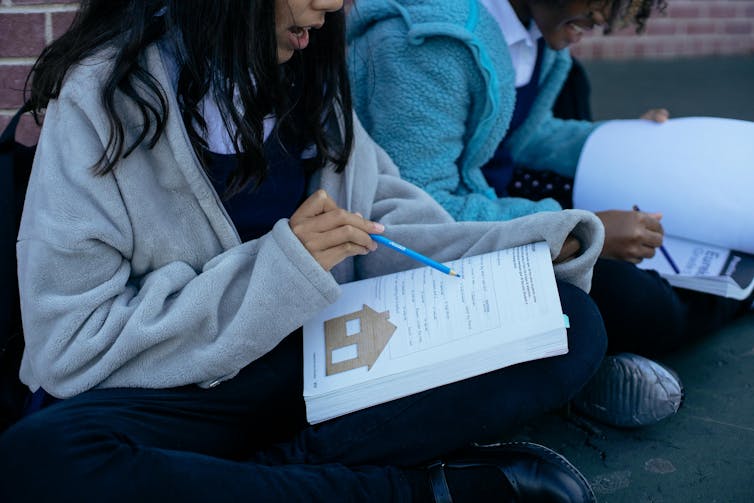
1. Talk About The Purpose Of The Test
NAPLAN is not just about individual student results and whether you are a “good” at maths or “bad” at reading. It’s about informing teaching and learning.
The results help teachers do their jobs by identifying areas of reading, writing and maths that need more attention. This can help individual students, classes or entire schools.
When the results are collected at state and national levels, they also help tell governments where to put more efforts and funding to help support students.
2. Talk About How The Test Is A Journey (Not A Destination)
Children learn from experience. This enables them to predict what might happen in similar future events.
Talk about NAPLAN as “practice” for future tests. So if you sit NAPLAN test in your younger school years this will help you handle other tests in senior school or maybe even university.
Emphasise that sitting the test is not about a particular outcome or result. It’s about embarking on an experience and learning what it is like to do a standardised tests. In this way, NAPLAN can help students build resilience.

3. Teach Your Child To Manage Anxiety
Mindfulness-based interventions have been shown to be successful in addressing anxiety symptoms in children.
Mindfulness can teach children to recognise anxiety symptoms such as a fast heart beat, shortness of breath or racing thoughts. By encouraging children to focus on the present moment, mindfulness can help children through improved concentration, better emotional regulation and fostering a sense of calm.
Smiling Mind is an Australian app designed to teach children to be mindful in a developmentally appropriate and guided way. The app is free to download and use. You could sit or lie down with your child and do a “body scan” (where you scan your entire body and notice how it feels) or a listening practice (where you pay attention to the sounds around you).
If your child is experiencing significant test anxiety, such as headaches, tummy pains or a racing heart, there may be more to it than just concerns about NAPLAN. For children aged 12–18, Headspace – Australia’s mental health foundation for young people – offers a range of services.
For younger children, or if you are still concerned, speak to your child’s teacher, the school counsellor or your GP.![]()
Rachel Leslie, Lecturer in Curriculum and Pedagogy with a focus on Educational Psychology, University of Southern Queensland
This article is republished from The Conversation under a Creative Commons license. Read the original article.
Why do I need to get up during the night to wee? Is this normal?

It can be normal to wake up once or even twice during the night to wee, especially as we get older.
One in three adults over 30 makes at least two trips to the bathroom every night.
Waking up from sleep to urinate on a regular basis is called nocturia. It’s one of the most commonly reported bothersome urinary symptoms (others include urgency and poor stream).
So what causes nocturia, and how can it affect wellbeing?
A Range Of Causes
Nocturia can be caused by a variety of medical conditions, such as heart or kidney problems, poorly controlled diabetes, bladder infections, an overactive bladder, or gastrointestinal issues. Other causes include pregnancy, medications and consumption of alcohol or caffeine before bed.
While nocturia causes disrupted sleep, the reverse is true as well. Having broken sleep, or insomnia, can also cause nocturia.
When we sleep, an antidiuretic hormone is released that slows down the rate at which our kidneys produce urine. If we lie awake at night, less of this hormone is released, meaning we continue to produce normal rates of urine. This can accelerate the rate at which we fill our bladder and need to get up during the night.
Stress, anxiety and watching television late into the night are common causes of insomnia.

Effects Of Nocturia On Daily Functioning
The recommended amount of sleep for adults is between seven and nine hours per night. The more times you have to get up in the night to go to the bathroom, the more this impacts sleep quantity and quality.
Decreased sleep can result in increased tiredness during the day, poor concentration, forgetfulness, changes in mood and impaired work performance.
If you’re missing out on quality sleep due to nighttime trips to the bathroom, this can affect your quality of life.
In more severe cases, nocturia has been compared to having a similar impact on quality of life as diabetes, high blood pressure, chest pain, and some forms of arthritis. Also, frequent disruptions to quality and quantity of sleep can have longer-term health impacts.
Nocturia not only upsets sleep, but also increases the risk of falls from moving around in the dark to go to the bathroom.
Further, it can affect sleep partners or others in the household who may be disturbed when you get out of bed.
Can You Have A ‘Small Bladder’?
It’s a common misconception that your trips to the bathroom are correlated with the size of your bladder. It’s also unlikely your bladder is smaller relative to your other organs.
If you find you are having to wee more than your friends, this could be due to body size. A smaller person drinking the same amount of fluids as someone larger will simply need to go the bathroom more often.
If you find you are going to the bathroom quite a lot during the day and evening (more than eight times in 24 hours), this could be a symptom of an overactive bladder. This often presents as frequent and sudden urges to urinate.
If you are concerned about any lower urinary tract symptoms, it’s worth having a chat with your family GP.
There are some medications that can assist in the management of nocturia, and your doctor will also be able to help identify any underlying causes of needing to go to the toilet during the night.
A Happy And Healthy Bladder
Here are some tips to maintain a happy and healthy bladder, and reduce the risk you’ll be up at night:
make your sleep environment comfortable, with a suitable mattress and sheets to suit the temperature
get to bed early, and limit screens, or activites before bed
limit foods and drinks that irritate the bladder, such as coffee or alcohol, especially before bedtime
sit in a relaxed position when urinating, and allow time for the bladder to completely empty
practice pelvic floor muscle exercises
drink an adequate amount of fluids during the day, and avoid becoming dehydrated
maintain a healthy lifestyle, eat nutritious foods and do not do anything harmful to the body such as smoking or using illicit drugs
review your medications, as the time you take some pharmaceuticals may affect urine production or sleep
if you have swollen legs, raise them a few hours before bedtime to let the fluid drain.

Christian Moro, Associate Professor of Science & Medicine, Bond University and Charlotte Phelps, Senior Teaching Fellow, Medical Program, Bond University
This article is republished from The Conversation under a Creative Commons license. Read the original article.
We’re a step closer to having a universal antivenom for snake bites – new study
Stuart Ainsworth, University of Liverpool and Camille Abada, Liverpool School of Tropical MedicineIf you’re bitten by a venomous snake, the medicine you need is antivenom. Unfortunately, antivenoms are species specific, meaning you need to have the right antivenom for the snake that bit you. Most of the time, people have no idea what species of snake has bitten them. And for some snakes, antivenoms are simply not available.
New research my colleagues and I conducted provides a significant step forward in enabling the development of an antivenom that will neutralise the effects of venom from any venomous snake: a so-called “universal antivenom”.
In our paper, published in Science Translational Medicine, we describe the discovery and development of a laboratory-made antibody that can neutralise a neurotoxin (a toxin that acts on the nervous system) found in the venom of many types of snake around the world.
Venomous snakes kill as many as 138,000 people each year, with many more survivors suffering from life-changing injuries and mental trauma. Children and farmers make up the bulk of the victims.
The active ingredients in antivenoms are anti-toxin antibodies. They are made by injecting horses with small quantities of snake venom and harvesting the antibodies. This method of making antivenom has remained the same for over a century – and it has substantial drawbacks.
In addition to antivenoms being species specific, they are also not very potent, so you need lots of antivenom to neutralise the venom from a bite.
Also, because antivenoms are made in horses, you are highly likely to experience severe side-effects when administered, as your body’s immune system will detect and react to the “foreign” horse antibodies circulating in your bloodstream.
Antibodies that are made in the laboratory using genetically modified cells are routinely used in humans to treat cancers and immune disorders. A long-held hope is that the technology used to produce these antibodies can be used to make antivenom and eventually replace traditional antivenoms, thereby solving many of the issues current antivenoms face.
The antibodies in lab-made antivenoms could be “humanised”, a process that tricks your immune system into thinking foreign antibodies are your own antibodies. This might reduce the rate of severe side-effects that are commonly encountered with horse-derived antivenoms.
Paralysis And Death Avoided
One of the most important families of toxins in snake venoms are neurotoxins.
These toxins prevent nerve signals from travelling from your brain to your muscles, paralysing them. This includes paralysing the muscles that inflate and deflate your lungs, so prey and human victims quickly stop breathing and die.
These neurotoxins are in the venoms of some of the world’s most deadly snakes, including the African black mamba, the Asian monocled cobra and king Cobra, and the deadly kraits of the Indian subcontinent.
In our research, we describe the discovery and development of a lab-made humanised antibody that can neutralise key venom neurotoxins from diverse snakes from diverse regions.
The lab-made antibody is called 95Mat5 and was discovered after examining 50 billion unique antibodies to find ones capable of not only recognising the neurotoxin in the venoms of many species but also able to neutralise its deadly effects.
When injected into mice that had received lethal doses of venom, 95Mat5 was able to prevent paralysis and death in all the venoms tested.
These results are particularly exciting as they show that generating lab-made antibodies that can broadly neutralise the effects of venoms from many species is feasible, making the development of a universal antivenom a realistic prospect.
However, 95Mat5 is a single antibody that only works against neurotoxins. As we said earlier, to make a universal antivenom you will require a handful of antibodies. This is because snake venoms don’t just consist of neurotoxins.
Some snake venoms have haemotoxins, which make you bleed, and some have cytotoxins, which destroy skin and bone. To create a universal antivenom, capable of treating any bite from any snake, we still need to identify additional antibodies that can broadly and potently neutralise the other toxin types, in the same manner as 95Mat5.
We hope that once identified, these antibodies can be mixed with 95Mat5 to make an antivenom that is capable of neutralising the venom of any snake, no matter what toxin types it possesses.
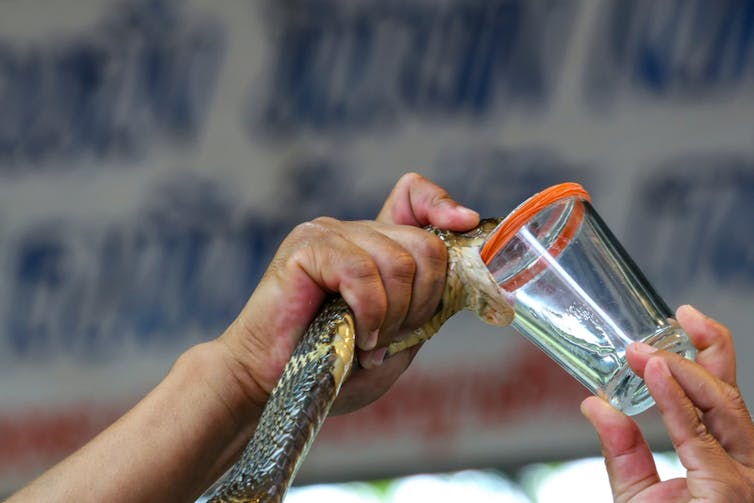
The requirement for antibodies for other venom toxins and also the need to ensure any new lab-made antivenom for effectiveness and safety in human trials means it will still take many years for a universal antivenom to become available to snakebite victims.
Other hurdles need to be overcome. These new antivenoms will probably need to be stored in a fridge to prevent loss of effectiveness, so it will need to be shown that they can be distributed in often warm regions of the world that don’t have reliable electricity for refrigeration.
Lab-made antibodies are some of the most expensive drugs on the planet. While we are hopeful, it remains to be seen if lab-made antivenoms will be affordable for most snakebite victims, who are usually some of the poorest people in the world.![]()
Stuart Ainsworth, Senior Lecture and UKRI Future Leader Fellow, University of Liverpool and Camille Abada, PhD Candidate, Antibodies, Liverpool School of Tropical Medicine
This article is republished from The Conversation under a Creative Commons license. Read the original article.
Pan Pacific Masters Games 2024

More Medicines Available For 60-Day Prescriptions
- androgen deficiency
- arthritis
- breast cancer
- bipolar disorder
- diabetes
- epilepsy
- hypothyroidism
- incontinence
- menopause
- migraine
- prostate cancer
- prostate enlargement
Hearing loss is twice as common in Australia’s lowest income groups, our research shows

Around one in six Australians has some form of hearing loss, ranging from mild to complete hearing loss. That figure is expected to grow to one in four by 2050, due in a large part to the country’s ageing population.
Hearing loss affects communication and social engagement and limits educational and employment opportunities. Effective treatment for hearing loss is available in the form of communication training (for example, lipreading and auditory training), hearing aids and other devices.
But the uptake of treatment is low. In Australia, publicly subsidised hearing care is available predominantly only to children, young people and retirement-age people on a pension. Adults of working age are mostly not eligible for hearing health care under the government’s Hearing Services Program.
Our recent study published in the journal Ear and Hearing showed, for the first time, that working-age Australians from lower socioeconomic backgrounds are at much greater risk of hearing loss than those from higher socioeconomic backgrounds.
We believe the lack of socially subsidised hearing care for adults of working age results in poor detection and care for hearing loss among people from disadvantaged backgrounds. This in turn exacerbates social inequalities.
Population Data Shows Hearing Inequality
We analysed a large data set called the Household, Income and Labour Dynamics in Australia (HILDA) survey that collects information on various aspects of people’s lives, including health and hearing loss.
Using a HILDA sub-sample of 10,719 working-age Australians, we evaluated whether self-reported hearing loss was more common among people from lower socioeconomic backgrounds than for those from higher socioeconomic backgrounds between 2008 and 2018.
Relying on self-reported hearing data instead of information from hearing tests is one limitation of our paper. However, self-reported hearing tends to underestimate actual rates of hearing impairment, so the hearing loss rates we reported are likely an underestimate.
We also wanted to find out whether people from lower socioeconomic backgrounds were more likely to develop hearing loss in the long run.

We found people in the lowest income groups were more than twice as likely to have hearing loss than those in the highest income groups. Further, hearing loss was 1.5 times as common among people living in the most deprived neighbourhoods than in the most affluent areas.
For people reporting no hearing loss at the beginning of the study, after 11 years of follow up, those from a more deprived socioeconomic background were much more likely to develop hearing loss. For example, a lack of post secondary education was associated with a more than 1.5 times increased risk of developing hearing loss compared to those who achieved a bachelor’s degree or above.
Overall, men were more likely to have hearing loss than women. As seen in the figure below, this gap is largest for people of low socioeconomic status.
Why Are Disadvantaged Groups More Likely To Experience Hearing Loss?
There are several possible reasons hearing loss is more common among people from low socioeconomic backgrounds. Noise exposure is one of the biggest risks for hearing loss and people from low socioeconomic backgrounds may be more likely to be exposed to damaging levels of noise in jobs in mining, construction, manufacturing, and agriculture.
Lifestyle factors which may be more prevalent in lower socioeconomic communities such as smoking, unhealthy diet, and a lack of regular exercise are also related to the risk of hearing loss.
Finally, people with lower incomes may face challenges in accessing timely hearing care, alongside competing health needs, which could lead to missed identification of treatable ear disease.
Why Does This Disparity In Hearing Loss Matter?
We like to think of Australia as an egalitarian society – the land of the fair go. But nearly half of people in Australia with hearing loss are of working age and mostly ineligible for publicly funded hearing services.
Hearing aids with a private hearing care provider cost from around A$1,000 up to more than $4,000 for higher-end devices. Most people need two hearing aids.

Lack of access to affordable hearing care for working-age adults on low incomes comes with an economic as well as a social cost.
Previous economic analysis estimated hearing loss was responsible for financial costs of around $20 billion in 2019–20 in Australia. The largest component of these costs was productivity losses (unemployment, under-employment and Jobseeker social security payment costs) among working-age adults.
Providing Affordable Hearing Care For All Australians
Lack of affordable hearing care for working-age adults from lower socioeconomic backgrounds may significantly exacerbate the impact of hearing loss among deprived communities and worsen social inequalities.
Recently, the federal government has been considering extending publicly subsidised hearing services to lower income working age Australians. We believe reforming the current government Hearing Services Program and expanding eligibility to this group could not only promote a more inclusive, fairer and healthier society but may also yield overall cost savings by reducing lost productivity.
All Australians should have access to affordable hearing care to have sufficient functional hearing to achieve their potential in life. That’s the land of the fair go.![]()
Mohammad Nure Alam, PhD Candidate in Economics, Macquarie University; Kompal Sinha, Associate Professor, Department of Economics, Macquarie University, and Piers Dawes, Professor, School of Health and Rehabilitation Sciences, The University of Queensland
This article is republished from The Conversation under a Creative Commons license. Read the original article.
Potato charms: people throughout history have kept and even stolen wrinkly old vegetables for their health
Anna Marie Roos, University of LincolnIn 1897, one Mr Burgess, the Clerk of Works at Oxford University, donated two shrivelled potatoes to the Pitt Rivers Museum. He usually kept them in his pockets. They were the ultimate “jacket” potatoes.
The Pitt Rivers Museum in Oxford is dedicated to categorising and displaying a “democracy of objects” not according to time or nation, but according to human usage. Since the potato is fairly ubiquitous in human culture, it means there are many in the museum’s collection.
In addition to Burgess’s donation, 11 other wrinkled specimens are catalogued in the museum’s collections, and are neatly labelled. The names of the previous owners are usually not identified because most of the potatoes were stolen before they were donated.
But why would someone would want to steal a wrinkly potato? The answer is these were not just any purloined spuds. They were medical charms thought to be cures for rheumatism – and if they were stolen, they were thought to be even more effective.
In the Victorian era, and for centuries before, a variety of vegetables were carried whole, or pulverised and put into bags to hang around the neck in the hopes of warding off or curing illness.
Plants As Drugs
Before modern pharmaceuticals, most materia medica (substances used in medical practice, or drugs) were herbal. Their usage was described in books by the ancient Greek physician Pedanius Dioscorides (40-70 AD) and in Pliny’s Natural History (1st century AD), an encyclopaedia written in ancient Rome. These books from the ancient world continued to be reference guides throughout the Renaissance.

In his book Pliny described the usefulness of plants such as the mandrake root, which was thought to resemble a human figure complete with what was known as “the virile members”. The root was made into amulets to be worn to promote fertility and in love magic. Using it in this way, is also referred to in the Song of Solomon in the Bible.
Because the root contained hallucinogenic and narcotic active ingredients, it was also used as an anaesthetic and to relieve the pain of arthritis. By the 16th century, herbalist John Gerard’s Herball or General Historie of Plants related the legend that if one pulled it from the ground, the root would scream, killing anyone who heard it (possibly a result of a couple of bad trips).
Illnesses Caused By The Planets
Paracelsus, a 16th-century Swiss doctor, elaborated upon such theories, claiming each plant had what was called a “signature” or sign of its medical application resembling the part of the body or ailment that it could cure.
For instance, lentils and rapeseed were thought sympathetically to cure smallpox because the seeds were similar to the pox pustules. The appropriate herbs, pulses, seeds or vegetables were bundled and worn about the neck to affect the cure.
Other plants, such as the sunflower, were thought to promote the hot and dry characteristics of the sun, good to warm you if you suffered from a cold.
Plant therapy was also linked to the use of astrology in early medicine. The planets were thought to control the fluids or “humors” in the body (black bile, blood, yellow bile, and phlegm), all of which had to be kept in careful balance to promote health. An imbalance was believed to be cured by bleeding or by the ingestion of an herbal remedy, or in some cases, wearing of the appropriate plant amulet.
Diseases caused by a particular planet could be healed by a herb of the opposing planet. For example, lunar diseases were considered to produce an abundance of cold and moist humours, as the Moon controlled the waters in the tides.
Diseases that produced phlegm and caused sneezing like the common cold, or those that produced fluid-filled tumours, such as scrofula, were therefore considered governed by the Moon. These lunar diseases could be cured by means of solar herbs or tinctures, which were hot and drying as sunbeams. Hence the sunflower cure. Lettuce which was watery was to be avoided.
But what of our potato and its connection to rheumatism?
There is a poison, called solanine, present in green potatoes and potato eyes (the root-like sprouts). Solanine is chemically closely related to another poison tropane alkaloid, named atropine in deadly nightshade. In fact, the potato is called a nightshade vegetable.
Atropine cream in the Victorian era, sometimes in combination with morphine, was applied to “relieve the pain of rheumatism, sciatica and neuralgia”. Although there proved to be no scientific basis for this, atropine is used in contemporary medicine to dilate the pupils or to elevate heartbeats in a medical emergency.
There were several cases of murder involving putting higher levels of atropine in tea or in a gin and tonic, its bitter taste disguised by the booze.
As to why the potatoes had to be stolen to cure rheumatism, we still don’t quite know but it certainly adds to their charm.

Looking for something good? Cut through the noise with a carefully curated selection of the latest releases, live events and exhibitions, straight to your inbox every fortnight, on Fridays. Sign up here.![]()
Anna Marie Roos, Professor of the History of Science and Medicine in the School of History and Heritage, University of Lincoln
This article is republished from The Conversation under a Creative Commons license. Read the original article.
New Parramatta River Class Ferry Starts Sea Trials On The Derwent: The Frances Bodkin

Pharmacy Trial Surpasses 12,000 Consultations
Rhonda The Roadheader Breaks Through At Clyde
Sydney Metro West’s Huge Year Of Tunnelling Kicks Off
.jpg?timestamp=1709660345938)
Living Near Pubs, Bars And Fast-Food Restaurants Could Be Bad For Heart Health
- Overall, participants in the highest density of ready-to-eat food outlets — defined as 1 kilometer/.62 mile area with 11 or more ready-to-eat outlets — had a 16% greater risk of heart failure compared to those with no ready-to-eat food environments near their homes.
- Those in the highest density areas of pubs and bars showed a 14% higher risk for heart failure; while those in the highest density areas for fast-food outlets had a 12% higher risk.
- Participants who lived closest to pubs and bars — less than 500 meters (.31 miles) — had a 13% higher risk of heart failure; while those closest to fast-food outlets had a 10% higher risk compared to those who lived the farthest away (more than 2,000 meters or 1.24 miles.
- Heart failure risk was stronger among participants without a college degree and adults in urban areas without access to formal physical activity facilities such as gyms.
- Data came from UK Biobank entries for more than 500,000 adults, ages 37-73 years old recruited from 22 assessment centers in England, Scotland and Wales between March 2006 and October 2010, followed through May 2021.
- Heart Failure was based on self-reported information and hospital inpatient records.
- Participants, on average, were 56 years old, more than half were women and 94% were of white European ancestry. Participants had completed extensive questionnaires detailing personal information, such as age, sex, race, education, lifestyle habits and medical history.
- Within the 1-kilometer range of where participants lived, there were 3.57 ready-to-eat food outlets on average.
- The average street distance to pubs and bars was 692 meters (0.43 miles); 820 meters (0.50 miles) to restaurants and cafeterias; and 1,135 meters (0.70 miles) to fast-food restaurants. Participants included in the analysis were exposed to the highest density category of composite ready-to-eat food environments.
Your face for sale: anyone can legally gather and market your facial data without explicit consent

The morning started with a message from a friend: “I used your photos to train my local version of Midjourney. I hope you don’t mind”, followed up with generated pictures of me wearing a flirty steampunk costume.
I did in fact mind. I felt violated. Wouldn’t you? I bet Taylor Swift did when deepfakes of her hit the internet. But is the legal status of my face different from the face of a celebrity?
Your facial information is a unique form of personal sensitive information. It can identify you. Intense profiling and mass government surveillance receives much attention. But businesses and individuals are also using tools that collect, store and modify facial information, and we’re facing an unexpected wave of photos and videos generated with artificial intelligence (AI) tools.
The development of legal regulation for these uses is lagging. At what levels and in what ways should our facial information be protected?
Is Implied Consent Enough?
The Australian Privacy Act considers biometric information (which would include your face) to be a part of our personal sensitive information. However, the act doesn’t define biometric information.
Despite its drawbacks, the act is currently the main legislation in Australia aimed at facial information protection. It states biometric information cannot be collected without a person’s consent.
But the law doesn’t specify whether it should be express or implied consent. Express consent is given explicitly, either orally or in writing. Implied consent means consent may reasonably be inferred from the individual’s actions in a given context. For example, if you walk into a store that has a sign “facial recognition camera on the premises”, your consent is implied.

But using implied consent opens our facial data up to potential exploitation. Bunnings, Kmart and Woolworths have all used easy-to-miss signage that facial recognition or camera technology is used in their stores.
Valuable And Unprotected
Our facial information has become so valuable, data companies such as Clearview AI and PimEye are mercilessly hunting it down on the internet without our consent.
These companies put together databases for sale, used not only by the police in various countries, including Australia, but also by private companies.
Even if you deleted all your facial data from the internet, you could easily be captured in public and appear in some database anyway. Being in someone’s TikTok video without your consent is a prime example – in Australia this is legal.
Furthermore, we’re also now contending with generative AI programs such as Midjourney, DALL-E 3, Stable Diffusion and others. Not only the collection, but the modification of our facial information can be easily performed by anyone.
Our faces are unique to us, they’re part of what we perceive as ourselves. But they don’t have special legal status or special legal protection.
The only action you can take to protect your facial information from aggressive collection by a store or private entity is to complain to the office of the Australian Information Commissioner, which may or may not result in an investigation.
The same applies to deepfakes. The Australian Competition and Consumer Commission will consider only activity that applies to trade and commerce, for example if a deepfake is used for false advertising.
And the Privacy Act doesn’t protect us from other people’s actions. I didn’t consent to have someone train an AI with my facial information and produce made-up images. But there is no oversight on such use of generative AI tools, either.
There are currently no laws that prevent other people from collecting or modifying your facial information.
Catching Up The Law
We need a range of regulations on the collection and modification of facial information. We also need a stricter status of facial information itself. Thankfully, some developments in this area are looking promising.
Experts at the University of Technology Sydney have proposed a comprehensive legal framework for regulating the use of facial recognition technology under Australian law.
It contains proposals for regulating the first stage of non-consensual activity: the collection of personal information. That may help in the development of new laws.
Regarding photo modification using AI, we’ll have to wait for announcements from the newly established government AI expert group working to develop “safe and responsible AI practices”.
There are no specific discussions about a higher level of protection for our facial information in general. However, the government’s recent response to the Attorney-General’s Privacy Act review has some promising provisions.
The government has agreed further consideration should be given to enhanced risk assessment requirements in the context of facial recognition technology and other uses of biometric information. This work should be coordinated with the government’s ongoing work on Digital ID and the National Strategy for Identity Resilience.
As for consent, the government has agreed in principle that the definition of consent required for biometric information collection should be amended to specify it must be voluntary, informed, current, specific and unambiguous.
As facial information is increasingly exploited, we’re all waiting to see whether these discussions do become law – hopefully sooner rather than later.
Correction: we have amended a sentence to clarify Woolworths use camera technology but not necessarily facial recognition technology.![]()
Margarita Vladimirova, PhD in Privacy Law and Facial Recognition Technology, Deakin University
This article is republished from The Conversation under a Creative Commons license. Read the original article.
Gravity experiments on the kitchen table: why a tiny, tiny measurement may be a big leap forward for physics

Just over a week ago, European physicists announced they had measured the strength of gravity on the smallest scale ever.
In a clever tabletop experiment, researchers at Leiden University in the Netherlands, the University of Southampton in the UK, and the Institute for Photonics and Nanotechnologies in Italy measured a force of around 30 attonewtons on a particle with just under half a milligram of mass. An attonewton is a billionth of a billionth of a newton, the standard unit of force.
The researchers say the work could “unlock more secrets about the universe’s very fabric” and may be an important step toward the next big revolution in physics.
But why is that? It’s not just the result: it’s the method, and what it says about a path forward for a branch of science critics say may be trapped in a loop of rising costs and diminishing returns.
Gravity
From a physicist’s point of view, gravity is an extremely weak force. This might seem like an odd thing to say. It doesn’t feel weak when you’re trying to get out of bed in the morning!
Still, compared with the other forces that we know about – such as the electromagnetic force that is responsible for binding atoms together and for generating light, and the strong nuclear force that binds the cores of atoms – gravity exerts a relatively weak attraction between objects.
And on smaller scales, the effects of gravity get weaker and weaker.
It’s easy to see the effects of gravity for objects the size of a star or planet, but it is much harder to detect gravitational effects for small, light objects.
The Need To Test Gravity
Despite the difficulty, physicists really want to test gravity at small scales. This is because it could help resolve a century-old mystery in current physics.
Physics is dominated by two extremely successful theories.
The first is general relativity, which describes gravity and spacetime at large scales. The second is quantum mechanics, which is a theory of particles and fields – the basic building blocks of matter – at small scales.
These two theories are in some ways contradictory, and physicists don’t understand what happens in situations where both should apply. One goal of modern physics is to combine general relativity and quantum mechanics into a theory of “quantum gravity”.
One example of a situation where quantum gravity is needed is to fully understand black holes. These are predicted by general relativity – and we have observed huge ones in space – but tiny black holes may also arise at the quantum scale.
At present, however, we don’t know how to bring general relativity and quantum mechanics together to give an account of how gravity, and thus black holes, work in the quantum realm.
New Theories And New Data
A number of approaches to a potential theory of quantum gravity have been developed, including string theory, loop quantum gravity and causal set theory.
However, these approaches are entirely theoretical. We currently don’t have any way to test them via experiments.
To empirically test these theories, we’d need a way to measure gravity at very small scales where quantum effects dominate.
Until recently, performing such tests was out of reach. It seemed we would need very large pieces of equipment: even bigger than the world’s largest particle accelerator, the Large Hadron Collider, which sends high-energy particles zooming around a 27-kilometre loop before smashing them together.
Tabletop Experiments
This is why the recent small-scale measurement of gravity is so important.
The experiment conducted jointly between the Netherlands and the UK is a “tabletop” experiment. It didn’t require massive machinery.
The experiment works by floating a particle in a magnetic field and then swinging a weight past it to see how it “wiggles” in response.
This is analogous to the way one planet “wiggles” when it swings past another.
By levitating the particle with magnets, it can be isolated from many of the influences that make detecting weak gravitational influences so hard.
The beauty of tabletop experiments like this is they don’t cost billions of dollars, which removes one of the main barriers to conducting small-scale gravity experiments, and potentially to making progress in physics. (The latest proposal for a bigger successor to the Large Hadron Collider would cost US$17 billion.)
Work To Do
Tabletop experiments are very promising, but there is still work to do.
The recent experiment comes close to the quantum domain, but doesn’t quite get there. The masses and forces involved will need to be even smaller, to find out how gravity acts at this scale.
We also need to be prepared for the possibility that it may not be possible to push tabletop experiments this far.
There may yet be some technological limitation that prevents us from conducting experiments of gravity at quantum scales, pushing us back toward building bigger colliders.
Back To The Theories
It’s also worth noting some of the theories of quantum gravity that might be tested using tabletop experiments are very radical.
Some theories, such as loop quantum gravity, suggest space and time may disappear at very small scales or high energies. If that’s right, it may not be possible to carry out experiments at these scales.
After all, experiments as we know them are the kind of thing that happen at a particular place, across a particular interval of time. If theories like this are correct, we may need to rethink the very nature of experimentation so we can make sense of it in situations where space and time are absent.
On the other hand, the very fact we can perform straightforward experiments involving gravity at small scales may suggest that space and time are present after all.
Which will prove true? The best way to find out is to keep going with tabletop experiments, and to push them as far as they can go.![]()
Sam Baron, Associate Professor, Philosophy of Science, The University of Melbourne
This article is republished from The Conversation under a Creative Commons license. Read the original article.
Independent Referee Needed For Private Health Insurance Sector: AMA
It's A Scam! Celebrities Are Not Getting Rich From Online Investment Trading Platforms
- Scammers entice victims through social media advertisements, deepfake videos on video sharing platforms and fake online news articles about celebrities and well-known public figures claiming to make substantial money from online trading platforms.
- This fake click bait will link to a scam website where victims are prompted to enter their details. This is the gateway for communication between the scammer and victim.
- Scammers ask for a small investment of around $250 via credit card to provide access to the trading platform.
- Scammers will often ask the new investor to download a third-party trading platform via the relevant app store or provide the investor with login details for an online dashboard.
- After showing profits through a dedicated online dashboard, scammers persuade their victims to invest more. Sometimes scammers will allow victims to make a small withdrawal early in the scam to build trust.
- When the victim eventually tries to withdraw their funds, scammers will ask for withdrawal fees or cite tax implications to obtain more money. Some victims have reported being locked out of their account.
- STOP – Don’t give personal information or act on investment advice you have come across on social media. Don’t feel pressured to invest. If you have any doubts, stop communicating with them.
- THINK – Ask yourself if you really know what you are investing in? Scammers can create fake news to make it seem legitimate. Do an internet search to see if there are warnings about this investment trading platform scam, including if the well-known public figure has warned about being impersonated.
- PROTECT – Act quickly if something feels wrong. If you have shared financial information or transferred money, contact your bank immediately. Help others by reporting scams to Scamwatch.
- check ASIC’s investor alert list to help keep you informed about investments that could be fraudulent, a scam or unlicensed.
- go to ASIC’s Check before you invest page to see how you can check if the company or person is licensed or authorised to offer the investment. Be sure to check ASIC’s professional register to see if the licensee is authorised to provide services to retail clients. Sometimes licensees are impersonated so check you are dealing with the correct entity by independently verifying contact details on AFCA’s financial firms directory. Does the website domain and contact details match those on the list? For more information about how to spot an investment scam, visit ASIC’s Moneysmart website.
Dreading footy season? You’re not alone – 20% of Australians are self-described sport haters

With the winter AFL and NRL seasons about to start, Australia’s sporting calendar is once again transitioning from its quietest to busiest period.
For many, the return of the AFL and NRL competitions is highly anticipated. But there is one group whose experience is very different: the approximately 20% of Australians who hate sport.
We are currently conducting research to better understand why people feel this way about sport and what their experiences are like living in a nation where sport is so culturally central. We have completed surveys with thousands of Australians and are now beginning to interview those who have described themselves as “sport haters”.
Australia, A ‘Sports Mad’ Nation
Australia has long been described as a “sports mad nation”, a reasonable assertion given the Melbourne Cup attracted crowds of more than 100,000 people as far back as the 1880s.
Australia’s sport passion is perhaps most evident today from the number of professional teams we support for a nation of 26 million people, one of the highest per capita concentrations in the world.
In addition to our four distinct football codes – Australian rules football, rugby league, rugby union and soccer – we have professional netball, basketball, cricket and tennis. In all, there are more than 130 professional sport teams in Australia today (across both genders).
Australia also hosts – and Australians attend – major sport events at a rate wildly disproportionate to the size of our population and economy. Formula One, the Australian Open, the National Basketball League, the National Rugby League and Matildas have all recently broken attendance or television viewership records.
Why People Hate Sport
The ubiquity of sport in our culture, however, conceals the fact that a significant portion of people strongly and actively dislike sport. Recent research by one of the co-authors here (Heath McDonald) has begun to shine light on this cohort, dubbed “sport haters”.
Sport haters account for approximately 20% of the Australian population, according to two surveys we have conducted of nearly 3,500 and more than 27,000 adults. Demographically, this group is significantly more likely to be female, younger and more affluent than other Australians.
Their strong negative sentiments are reflected in the most common word associations study participants used to describe sport. In the case of AFL, these were: “boring”, “overpaid”, “stupid/dumb”, “rough”, “scandal” and “alcohol”.
While the reasons for disliking sport vary from person to person, research shows there are some common themes. The first is in childhood, where negative experiences participating in sport or attending games or matches can lead to a life-long dislike of all sport. As one professed sport hater said in an online forum devoted to men who don’t like sport:
My brother would force me to play soccer against my will all the time as children. I think that is where my resentment for physical sport comes from because the choice was taken away from me by my twat of a brother.
Sport hatred can also derive from social exclusion or marginalisation. Sport has historically been a male-centric domain that celebrates masculinity and can lead to toxic behaviour, which can exclude many women and some men.
Sport has also had to overcome racism, perhaps most symbolically visible by AFL player Nicky Winmar’s iconic protest in 1993. In addition, individuals with a disability still face barriers that result in lower rates of sport participation.
Here, the current Taylor Swift effect is noteworthy. The singer’s attendance at National Football League games, including the Superbowl, resulted in huge spikes in television viewership. Through her association, Swift helped make the sport more psychologically accessible for many women and girls.
The cultural dominance of sport also fuels its detractors, with many critical of sport’s media saturation and its broader social and even political prioritisation. (The debate in Tasmania over the controversial AFL stadium proposal is a good case in point.)
From a media perspective, Australia’s particularly strict anti-siphoning laws have ensured that sport remains front and centre on free-to-air television programming.
Sport’s cultural dominance also fosters resentment for overshadowing people’s non-sporting passions and pursuits, as well as creating societal out-groups. Journalist Jo Chandler’s 2010 description of moving to Melbourne is no doubt shared by many:
In the workplace, to be unaligned is deeply isolating. Team tribalism infects meetings, especially when overseen by male chiefs. In shameful desperation, I’ve played along.
In life, it’s fairly easy to avoid most products you might dislike. But given sport’s ubiquity, simply tuning out is sometimes not an option.
The Anti-Football League, A Club For Haters
In 1967, two Melbourne journalists, Keith Dunstan and Douglas Wilkie, launched an anti-sport club in response to this growing cultural dominance. In his founding address to the Anti-Football League, Wilkie made clear who the club was for:
All of us who are tired of having football personalities, predictions and post mortems cluttering our newspapers, TV screens and attempts at alternative human converse – from beginning-of-morning prayers to the last trickle of bed time bathwater – should join at once.
Membership quickly reached the thousands. Soon, a Sydney branch was launched, bringing national membership to a high of around 7,000. According to sport historian Matthew Klugman, members found joy in being “haters”.
…they wanted to find a shared meaning in their suffering, not to extinguish it, but to better enjoy it.
This led to some curious rituals, with members ceremonially cremating footballs or burying them. An Anti-Football Day was also launched, taking place on the eve of the Victorian Football League Grand Final.
The club would go on to experience periods of both prosperity and hiatus over the years, but has been dormant since Dunstan’s death in 2013.
With eight more years to go in Australia’s so-called “golden decade of sport”, which began with 2022 Women’s Basketball World Cup in Sydney and culminates with the 2032 Brisbane Olympics, it may be time sport haters to start a new support group.
If you consider yourself a sport hater, and are interested in contributing your experience to our ongoing research, please provide your contact information here.![]()
Hunter Fujak, Senior Lecturer in Sport Management, Deakin University and Heath McDonald, Dean of Economics, Finance and Marketing and Professor of Marketing, RMIT University
This article is republished from The Conversation under a Creative Commons license. Read the original article.
MH370 disappearance 10 years on: can we still find it?
Charitha Pattiaratchi, The University of Western AustraliaIt has been ten years since Malaysia Airlines passenger flight MH370 disappeared on March 8 2014. To this day it remains one of the biggest aviation mysteries globally.
It’s unthinkable that a modern Boeing 777-200ER jetliner with 239 people on board can simply vanish without any explanation. Yet multiple searches in the past decade have still not yielded the main wreckage or the bodies of the victims.
At a remembrance event held earlier this week, the Malaysian transport minister announced a renewed push for another search.
If approved by the Malaysian government, the survey will be conducted by United States seabed exploration firm Ocean Infinity, whose efforts were unsuccessful in 2018.
What Happened To MH370?
The flight was scheduled to fly from Kuala Lumpur to Beijing. Air traffic control lost contact with the aircraft within 60 minutes into the flight over the South China Sea.
Subsequently, it was tracked by military radar crossing the Malay Peninsula and was last located by radar over the Andaman Sea in the northeastern Indian Ocean.

Later, automated satellite communications between the aircraft and British firm’s Inmarsat telecommunications satellite indicated that the plane ended up in the southeast Indian Ocean along the 7th arc (an arc is a series of coordinates).
This became the basis for defining the initial search areas by the Australian Air Transport Safety Bureau. Initial air searches were conducted in the South China Sea and the Andaman Sea.
To date, we still don’t know what caused the aircraft’s change of course and disappearance.

What Have Searches For MH370 Found So Far?
On March 18 2014, ten days after the disappearance of MH370, a search in the southern Indian Ocean was led by Australia, with participation of aircraft from several countries. This search continued until April 28 and covered an area of 4,500,000 square kilometres of ocean. No debris was found.
Two underwater searches of the Indian Ocean, 2,800km off the coast of Western Australia, have also failed to find any evidence of the main crash site.
The initial seabed search, led by Australia, covered 120,000 square kilometres and extended 50 nautical miles across the 7th arc. It took 1,046 days and was suspended on January 17 2017.
A second search by Ocean Infinity in 2018 covered over 112,000 square kilometres. It was completed in just over three months but also didn’t locate the wreckage.
What About Debris?
While the main crash site still hasn’t been found, several pieces of debris have washed up in the years since the flight’s disappearance.
In fact, in June 2015 officials from the Australian Air Transport Safety Bureau determined that debris might arrive in Sumatra, contrary to the ocean currents in the region.
The strongest current in the Indian Ocean is the South Equatorial Current. It flows east to west between northern Australia and Madagascar, and debris would be able to cross it.
Indeed, on July 30 2015 a large piece of debris – a flaperon (moving part of a plane wing) – washed up on Reunion Island in the western Indian Ocean. It was later confirmed to belong to MH370.
Twelve months earlier, using an oceanographic drift model, our University of Western Australia (UWA) modelling team had predicted that any debris originating from the 7th arc would end up in the western Indian Ocean.
In subsequent months, additional aircraft debris was found in the western Indian Ocean in Mauritius, Tanzania, Rodrigues, Madagascar, Mozambique and South Africa.
The UWA drift analysis accurately predicted where floating debris from MH370 would beach in the western Indian Ocean. It also guided American adventurer Blaine Gibson and others to directly recover several dozen pieces of debris, three of which have been confirmed to be from MH370, while several others are deemed likely.

To date, these debris finds in the western Indian ocean are the only physical evidence found related to MH370.
It is also independent verification that the crash occurred close to the 7th arc, as any debris would initially flow northwards and then to the west, transported by the prevailing ocean currents. These results are consistent with other drift studies undertaken by independent researchers globally.
Why A New Search For MH370 Now?
Unfortunately, the ocean is a chaotic place, and even oceanographic drift models cannot pinpoint the exact location of the crash site.
The proposed new search by Ocean Infinity has significantly narrowed down the target area within latitudes 36°S and 33°S. This is approximately 50km to the south of the locations where UWA modelling indicated the release of debris along the 7th arc. If the search does not locate the wreckage, it could be extended north.
Since the initial underwater searches, technology has tremendously improved. Ocean Infinity is using a fleet of autonomous underwater vehicles with improved resolution. The proposed search will also use remotely controlled surface vessels.
In the area where the search is to take place, the ocean is around 4,000 metres deep. The water temperatures are 1–2°C, with low currents. This means that even after ten years, the debris field would be relatively intact.
Therefore, there is a high probability that the wreckage can still be found. If a future search is successful, this would bring closure not just to the families of those who perished, but also the thousands of people who have been involved in the search efforts.![]()
Charitha Pattiaratchi, Professor of Coastal Oceanography, The University of Western Australia
This article is republished from The Conversation under a Creative Commons license. Read the original article.
Disclaimer: These articles are not intended to provide medical advice, diagnosis or treatment. Views expressed here do not necessarily reflect those of Pittwater Online News or its staff.
